Safe Adventure Tour and Training


Comprehensive Guide for Vaishno Devi Trek
Nestled amidst the picturesque Trikuta Mountains in the northern state of Jammu and Kashmir, the Vaishno Devi Trek is an arduous yet spiritually rewarding pilgrimage undertaken by millions of devotees each year. Dedicated to the revered Hindu goddess Vaishno Devi, this trek offers a challenging yet transformative experience through enchanting landscapes and sacred shrines.
This comprehensive guide delves into the intricate details of the Vaishno Devi Trek, providing valuable insights, tips, and FAQs to empower pilgrims on their journey.
Table of contents:
The Trek Route and Distance
Sanctuary of devotion: the vaishno devi temple, spiritual significance and legends, important tips.

The Vaishno Devi Trek commences from the holy town of Katra. The trek route spans approximately 13 kilometers , with a total ascent of about 5,200 feet . The trek generally takes 4-6 hours to complete , depending on the pace and endurance of the pilgrims. The trail is well-paved and interspersed with rest stops and refreshment points.
The culmination of the trek is the revered Vaishno Devi Temple, situated atop Trikuta Mountains . The temple houses the revered 'pindies' or natural rock formations representing the goddesses Vaishno Devi, Kali, Durga, and Saraswati. Pilgrims ascend the final flight of steps towards the sanctum sanctorum, their hearts filled with unwavering devotion and a yearning to seek the goddess's blessings.
The Vaishno Devi shrine holds immense religious significance in Hinduism . Legends narrate that the goddess Vaishno Devi incarnated as a young princess, Vaishnavi, and assumed the form of a three-headed, ten-armed deity to vanquish the malevolent demon, Bhairon Nath. Her abode atop the Trikuta Mountains became a sacred pilgrimage site, attracting devotees from far and wide.
Prepare in advance by practicing walking and exercising regularly.
Pack light and carry only essential items such as water bottles, snacks, a first-aid kit, and warm clothing for the chilly mountain temperatures.
Respect the sacredness of the pilgrimage site and adhere to the rules and regulations.
Seek guidance and assistance from the local priests and guides if needed.
Start your trek early in the morning to avoid the crowds and enjoy the serene atmosphere.
1. How long is the trek to Vaishno Devi?
The trek from Katra to the Vaishno Devi Temple covers a distance of approximately 13 kilometers and typically takes 4-6 hours to complete.
2. Is the Vaishno Devi trek difficult?
While the trek route is well-paved and accessible for most age groups, it requires a moderate level of fitness and stamina. The ascent can be challenging, especially for first-time trekkers.
3. What is the best route for the Vaishno Devi trek?
There are two main routes for the Vaishno Devi trek: the traditional Old Track and the newer Tarakote Marg. Both routes offer distinct experiences, with the Tarakote Marg being slightly shorter and less crowded.
4. What is the height of Vaishno Devi temple?
The Vaishno Devi Temple is situated at an altitude of approximately 5,200 feet above sea level.
5. How can I book accommodation near the Vaishno Devi Temple?
Several guest houses and lodges are available near the Vaishno Devi Temple. Devotees can make bookings in advance through the official website or contact the local authorities.
Upon completing the pilgrimage, pilgrims can venture into the local market and visit the Bhairavnath Temple, situated approximately 3 kilometers from the Vaishno Devi Temple. Budget-friendly accommodation and transportation options are readily available, enabling pilgrims to customize their journey according to their preferences and financial constraints.
Embark on the Vaishno Devi Trek with a heart filled with reverence and determination. May the divine grace of the goddess guide your footsteps on this transformative pilgrimage, leaving an enduring imprint on your soul.
- Jammu and Kashmir
- India Trekking
Kolahoi Glacier Trek: Adventure Journey to Kashmir's Glacial Marvel
Exploring the Enchanting Khilanmarg Trek: A Scenic Himalayan Paradise
Pir Panjal Trek: Guide to Enchanting Trek in Indian Himalayas
- Philadelphia
- Tourist Places
- Write for us
- Term & Condition
- Privacy Policy
Which Is More Difficult Kedarnath Or Vaishno Devi Trek?
Which Is More Difficult Kedarnath Or Vaishno Devi? If you also think the same as the majority of people. From here, you will get great knowledge about these holy pilgrimage place trekking guides. Apart from that, you will clarify yourself to know which trek is easy or difficult for you.
Before going further about these trekking discussions, you should know all about these places Kedarnath or Vaishno Devi. Below we gonna start with both places introduction.
Introduction For Vaishno Devi And Kedarnath Temple
Here is the in-detail introduction to explore both places, so let’s start to explore more and also will clear that which trek is easy or difficult for trekking.
Table of Contents
Vaishno Devi
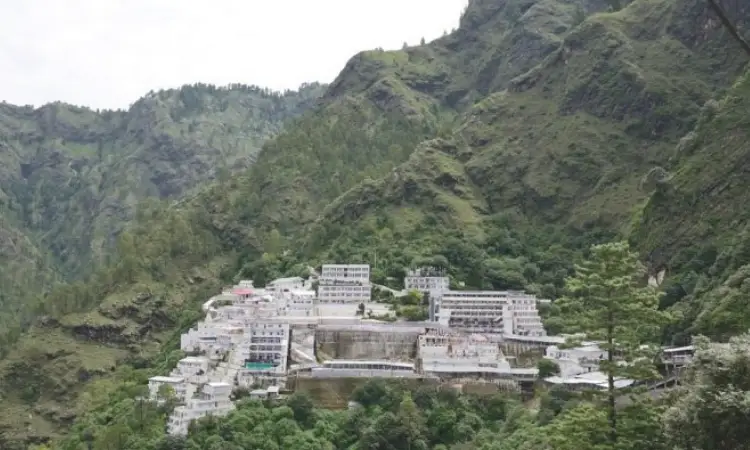
Vaishno Devi temple is suited in pretty Trikuta mountain cave which is dedicated to the Goddess Vaishno Devi. The majority of people believe that it is the holiest place for pilgrimage Yatra in India and Established three Pindies Mahakali, Mahalaxmi, and Mata Durga.
People go on an experience to go to the holy cave temple devoted to Goddess Vaishno Devi. The trip, stuffed with devotion, consists of strolling on a difficult however well-kept trekking path. This trek offers each exercise and time for questioning about religious things, making the trip special for believers. If any person desires a faster way up, they can also take a helicopter. Vaishno Devi is a stunning vicinity the place of faith, nature’s beauty, and the excitement of trekking all come collectively for a distinctive pilgrimage.
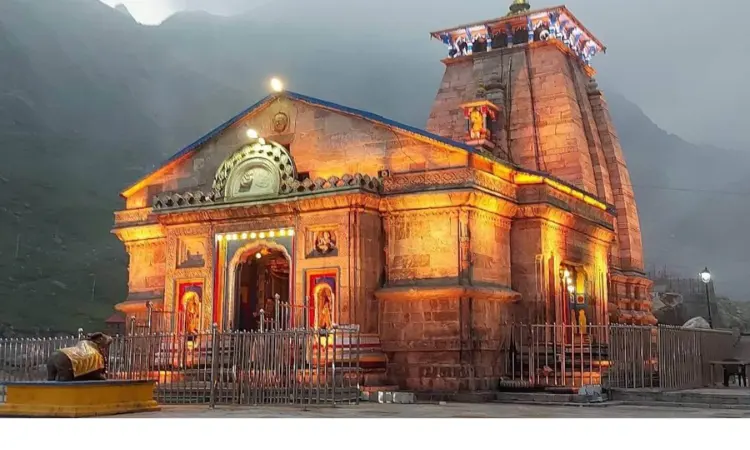
Nestled in the breathtaking Himalayas, Kedarnath stands as a revered Hindu pilgrimage internet site online in India. Devotees embark on a nonsecular quest to gain the ancient Kedarnath Temple, committed to Lord Shiva. The day trip consists of traversing tough and picturesque trekking paths, which include an adventurous dimension to the pilgrimage.
Pilgrims navigate through rugged terrains, cross rivers, and brave a number of local weather conditions. The laborious trek fosters a specific connection between the pilgrim, nature, and spirituality. The nonsecular atmosphere, coupled with the bodily wants of trekking, creates a transformative trip for those in search of divine advantages amidst the awe-inspiring landscapes of Kedarnath. If you would like to make the easiest trek of Kedarnath then you can book a Helicopter that will give you a peaceful trekking moment. So, currently if interest in making your Kedarnath tour by Helicopter , you can visit Udan Aviation’s reputed site.
Vaishno devi vs Kedarnath trek – Comparision
Kedarnath trek:.
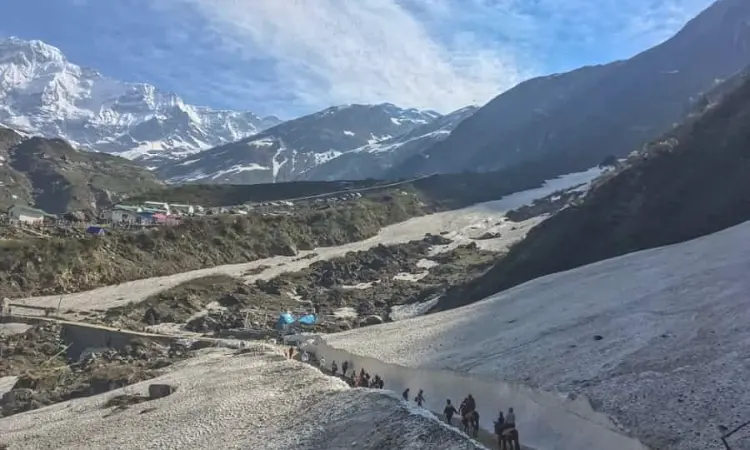
The Kedarnath Trek, set in the Himalayas, is a challenging pilgrimage leading to the ancient Kedarnath Temple dedicated to Lord Shiva. Pilgrims navigate rugged terrains, river crossings, and unpredictable weather, forging a transformative connection with nature and spirituality amidst the breathtaking landscapes of the region. Its trekking depends on the availability of facilities. Such as Accommodation, Food and Water, Medical Facilities, Mule and Pony Services, and physical fitness of the person.
- Located in the Himalayas, the Kedarnath Trek is acknowledged for its rugged and difficult terrain.
- Involves river crossings, steep ascents, and unpredictable climate conditions.
- The trek needs bodily staying power and a resilient spirit.
Vaishno Devi Trek:
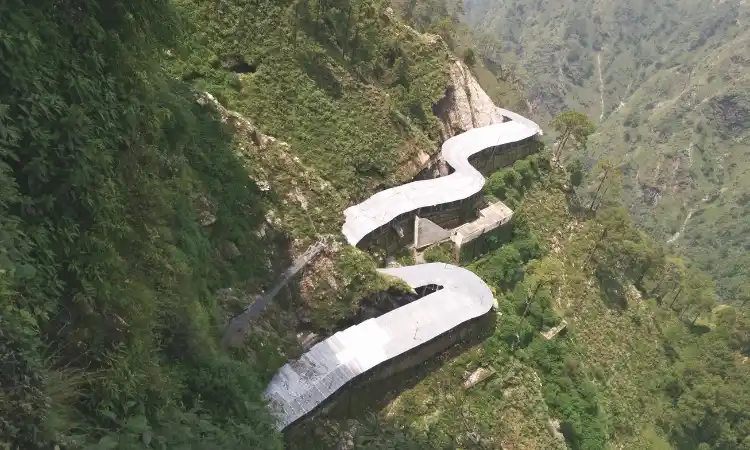
The Vaishno Devi Trek, nestled in the scenic Trikuta Mountains of Jammu and Kashmir, is a revered pilgrimage to the sacred cave temple of Goddess Vaishno Devi. Pilgrims embark on a trip alongside a steep, well-maintained path, with a choice for a faster ascent by helicopter. So, if want to book your Vaishno devi tour by helicopter then book now. The trek combines bodily exertion with religious reflection, supplying devotees with a special ride amidst serene surroundings. The cultural importance of Vaishno Devi contributes to the pilgrimage’s charm, making it a cherished vacation spot for those looking for a harmonious mixture of belief and herbal beauty.
- Set in the Trikuta Mountains, the Vaishno Devi Trek affords a steep however well-maintained path.
- Pilgrims have the choice of a faster ascent by helicopter, imparting a choice to trekking.
- The trek combines bodily exertion with non-secular reflection.
The perceived subject can fluctuate from man or woman to person. Kedarnath Trek is typically regarded as extra difficult due to its difficult terrain and lack of selections like a helicopter ride. Vaishno Devi Trek, with its alternative for a helicopter ascent, may additionally be seen as pretty extra reachable to some individuals. Ultimately, the ease of the trek relies upon private preferences and bodily capabilities.
Which trek is tougher Kedarnath or Vaishno Devi?
The Kedarnath Trek is generally considered tougher than the Vaishno Devi Trek . Kedarnath, set in the Himalayas, presents a rugged and challenging terrain with river crossings and unpredictable weather. In contrast, Vaishno Devi offers a steep but well-maintained path, and pilgrims have the option of a helicopter ascent, making it relatively less demanding.
Which is harder Vaishno Devi or Kedarnath?
Kedarnath is normally regarded as tougher than Vaishno Devi. The Kedarnath Trek in the Himalayas is extra rugged and challenging, involving river crossings and unpredictable weather. Vaishno Devi, with a steep however maintained course and helicopter option, is comparatively much less demanding.
Is The Kedarnath Trek Difficult?
Yes, the Kedarnath trek is viewed as difficult, providing rugged terrain, river crossings, and unpredictable climate stipulations in the Himalayas.
How Far Is Vaishno Devi From Kedarnath?
Vaishno Devi and Kedarnath are positioned in extraordinary areas of India. Vaishno Devi is in the Trikuta Mountains in Jammu and Kashmir, whilst Kedarnath is located in the Himalayas in Uttarakhand. The distance between them is significant, with every pilgrimage web page having its special nonsecular and geographical significance.
Conclusion: Kedarnath Trek Vs Vaishno Devi Trek
The desire between the Kedarnath Trek and Vaishno Devi Trek relies upon on character preferences and the willingness to embody wonderful challenges. The Kedarnath Trek, set in the ambitious Himalayas, provides a rugged and worrying journey, whilst the Vaishno Devi Trek, amidst the scenic Trikuta Mountains, gives a fantastically much less strenuous direction and the comfort of a helicopter ascent. Both treks, however, preserve vast religious importance and provide special possibilities for non-public boom and connection with nature. The choice subsequently rests on the pilgrim’s inclination in the direction of a greater challenging, adventurous journey or a notably simpler but spiritually enriching journey.
AUTHOR: Harsh Vardhan
RECOMMENDED FOR YOU
Vaishno Devi Yatra Travel Tips
Vaishno Devi, also known as Mata Vaishno Devi, is one of the most revered Hindu shrines in India. Nestled in the Trikuta Mountains of Jammu and Kashmir, this holy cave temple attracts millions of devotees each year. The pilgrimage to Vaishno Devi is not just a journey; it is a profound spiritual experience. To ensure a safe, comfortable, and fulfilling visit, it’s essential to be well-prepared. In this comprehensive guide, we will provide you with valuable Vaishno Devi Yatra travel tips covering every aspect of your pilgrimage.
Table of Contents
Planning Your Vaishno Devi Yatra
Choosing the Right Time
- Beyond just the weather, consider the festivals and events. Navratri, especially during Chaitra (March-April) and Sharad (September-October), is considered an auspicious time to visit.
Booking Accommodation in Advance
- While there are plenty of accommodation options, during peak seasons, it’s best to book well in advance to secure your stay.
Registering for the Yatra
- Registering for the Yatra online not only streamlines your journey but also helps authorities in ensuring the safety of pilgrims.
Health Checkup
- Along with assessing your fitness level, consult with a doctor to get advice on high-altitude trekking and any necessary vaccinations.
Reaching Katra – The Starting Point
- Jammu Airport (IXJ) is well-connected to major Indian cities. Upon arrival, hire a pre-paid taxi or board a shuttle to Katra.
- The Shri Mata Vaishno Devi Katra Railway Station (SVDK) has regular trains from cities like Delhi, Kolkata, and Mumbai. Make train reservations well in advance during peak seasons.
- If you prefer road travel, Katra is accessible by bus from various cities in North India, including Jammu, Delhi, and Chandigarh.
Trekking to Vaishno Devi
Starting the Trek
- The 13-kilometer trek from Katra to Vaishno Devi Bhawan is both challenging and spiritually enriching. You can choose your mode of transportation based on your fitness and preferences.
Walking Tips
- In addition to comfortable trekking shoes, carry a walking stick for support. Layer your clothing as temperatures can change rapidly. Don’t forget rain gear during monsoon season.
Pony and Palanquin Services
- If you choose to use pony or palanquin services, make sure they are registered with the Shrine Board to ensure safety and fair pricing.
Halt Points Along the Way
- There are several halting points with clean restrooms, food stalls, and medical facilities. Take advantage of these to rest, hydrate, and recharge.
Reaching the Vaishno Devi Bhawan
Security Check
- Be prepared for a thorough security check at the Bhawan. Leave behind items such as cameras, leather goods, and tobacco products, as they are prohibited.
The Holy Cave
- The cave temple is small, and it can get crowded during peak times. Maintain patience and follow the queues for darshan. Mobile phones are allowed but should be on silent mode out of respect.
Safety and Health Tips
Stay Hydrated
- Dehydration is a common issue during the trek. Carry enough water and energy drinks. There are water points along the route for refilling.
- Consume easily digestible foods like fruits, nuts, and local snacks. Avoid heavy meals, as they can make the trek more challenging.
- If you have any medical conditions, carry necessary medications and inform your travel companions about your condition. Be aware of the symptoms of altitude sickness.
Emergency Numbers
- Store emergency numbers and contacts of local authorities in your phone. The Shrine Board has a dedicated helpline for pilgrims.
Accommodation and Rest
Bhawan Accommodation
- If you plan to stay at the Bhawan, book rooms well in advance as they tend to get booked quickly, especially during festival seasons.
Accommodation in Katra
- Katra offers a range of accommodation options to suit various budgets. Choose one that fits your preferences and book in advance for peace of mind.
Food and Dietary Tips
Vegetarian Food
- The entire Vaishno Devi Yatra region is strictly vegetarian. Enjoy local dishes like rajma-chawal (kidney beans with rice) and puri-subzi (fried bread with vegetable curry).
- Eat at clean and reputable places to avoid stomach issues. Carry some dry fruits or energy bars as backup snacks.
Miscellaneous Tips
Dress Modestly
- Wear modest clothing covering your arms and legs as a sign of respect. Shawls and scarves are useful for both modesty and warmth.
Respect Local Customs
- Pay heed to local customs, like removing your shoes before entering temples or homes, and show respect to the local population.
Dispose of Waste Responsibly
- Carry a small garbage bag for your trash and dispose of it responsibly. Keep the pilgrimage route clean.
Be Prepared for Crowds
- Expect long queues and crowds, especially during festivals. Keep your belongings secure and stay patient.
Photography Restrictions
- Photography is restricted inside the cave temple. Comply with the rules and focus on the spiritual experience.
Returning from Vaishno Devi
Descending from Bhawan
- The descent can be taxing on your knees, so use walking sticks if necessary. Take your time and enjoy the scenic views on the way back to Katra.
After the Yatra
- Spend a day in Katra to rest and reflect on your spiritual journey before departing for your next destination.
Do’s and Donts
Important do’s:.
- Do carry only essential items such as medicines, basic toiletries, rain gear, and snacks. Keep your luggage light to make the trek easier.
Respect the Environment
- Do dispose of waste responsibly. Use designated bins and avoid littering. Keep the pilgrimage route clean and eco-friendly.
Be Patient and Courteous
- Do maintain patience and be courteous to fellow pilgrims. Long queues are common, especially during peak seasons.
Stay Informed
- Do keep emergency contact numbers, including those of the Shrine Board, local authorities, and your accommodation, handy.
Respect Photography Restrictions
- Do adhere to photography restrictions inside the cave temple. Focus on the spiritual experience rather than capturing pictures.
Important Don’ts:
Don’t Rush
- Don’t rush through the trek. Take your time, enjoy the journey, and pause to rest when needed.
Don’t Litter
- Don’t litter or throw garbage along the trekking route. Use designated bins for disposal.
Don’t Carry Prohibited Items
- Don’t carry prohibited items like cameras, leather goods, alcohol, and tobacco products. They are not allowed in the cave temple.
Don’t Disrupt Religious Practices
- Don’t disrupt or interfere with religious rituals or practices. Maintain silence and reverence inside the temple.
Don’t Ignore Health Issues
- Don’t ignore any health issues that may arise during the Yatra. Seek medical help if needed.
Don’t Engage in Unwanted Conversations:
- Don’t engage in unnecessary or unwanted conversations during the trek. Respect others’ need for silence and meditation.
Don’t Wear Revealing Clothing
Don’t wear revealing or immodest clothing. Dress modestly out of respect for the religious sanctity of the place.
Don’t Bargain Aggressively
- Don’t bargain aggressively with pony and palanquin service providers. Negotiate fairly and respectfully.
Don’t Forget Safety Precautions
- Don’t compromise on safety. Follow the prescribed paths and avoid shortcuts or risky routes.
Don’t Carry Heavy Baggage
- Don’t burden yourself with heavy luggage. Keep your belongings minimal to make the trek more manageable.
The Vaishno Devi Yatra is a blend of spirituality, adventure, and devotion. By following these travel tips, you can embark on a safe and transformative journey to the sacred abode of Mata Vaishno Devi. Approach the Yatra with a humble heart, and you’ll not only seek blessings but also find profound spiritual fulfillment. Your pilgrimage to Vaishno Devi will be an unforgettable experience that will stay with you for a lifetime.
2 thoughts on “Vaishno Devi Yatra Travel Tips”
Thanks for your information. I am from Goa planning to visit in meed of February month.
kindly share your contact detail
Leave a Reply Cancel reply
Your email address will not be published. Required fields are marked *
Plan Your Trip Our expert will get in touch with you shortly
Mobile No *
- INSIDER REVIEWS
- TECH BUYING GUIDES
A complete itinerary for your 3 days in Vaishno Devi
Shagun chaudhary , ayush mehrotra .

Best Time to Visit
How to reach, where to stay, read more articles on.
- Spend 3 Days In Vaishno Devi
- Vaishno Devi
- 3 Days Itinerary For Vaishno Devi
- Indiatravels
- Itinerary For Vaishno Devi
- Trip To Vaishno Devi
Popular Right Now
Advertisement
A quick guide to Mata Vaishno Devi trek

Planning to visit Mata Vaishno Devi Temple in Katra?
Here are some useful tips and tricks:, reaching katra:.
Trains are available up to Katra Railway Station – officially named “Shri Mata Vaishno Devi Katra Railway Station” (Station Code: SVDK). From Katra railway station you will have to take autorickshaw to Fountain Chowk (Phawara Chowk). Autorickshaws charge up to Rs. 300 (Rates mentioned are as they were on May 2017).
A majority of trains culminate at Jammu Railway Station. From Jammu you can hire a cab to Katra (Rs. 1500 one side) or get a bus/mini bus (Rs. 60 per person). They will drop you at Fountain Chowk.
HOTEL BOOKING:
It is advisable to pre-book a hotel room in Katra as per your budget. There are lots of hotels from budget to luxury category. Accommodations in temple trust’s dharmashalas are subject to availability. A lot of information is available on the shrine board’s website.
PARCHI (ENTRY PASS):
The first and most important thing you have to do is to get a “parchi” – an entry pass at the “parchi counter” at Fountain Chowk. This service is free and hassle-free. You have to stand in queue. In 5-10 mins as your turn comes you have to tell your name and hometown and get yourself photographed. They give you a printed entry pass with your name. You have to keep it with yourself to show it at different check points.
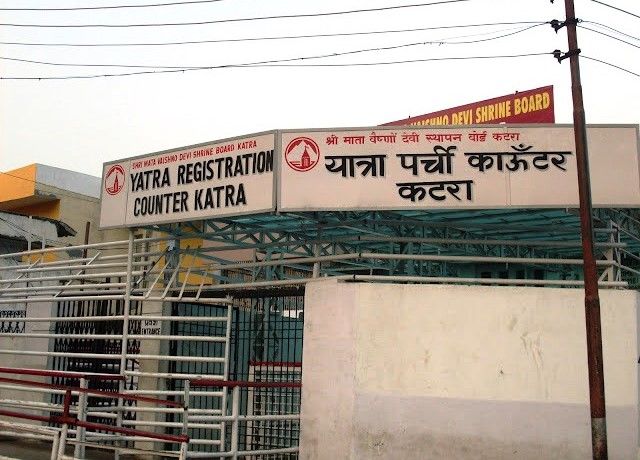
MODES OF REACHING THE SHRINE:
You can reach the temple on foot, pony ride, palanquin and by helicopter.
HELICOPTER BOOKING:
Pilgrims who wish to hire helicopter service should pre-book it online. Rates are decided by the trust. Booking can be done at Shrine's website .
ENTRY GATE:
After getting your “parchi”, you will have to walk down some 4-5 km to reach the first major check point named “Banganga gate”. You can either walk down to the gate, like many other pilgrims do, or you can take an autorickshaw till this point. There are separate queues for men and women.
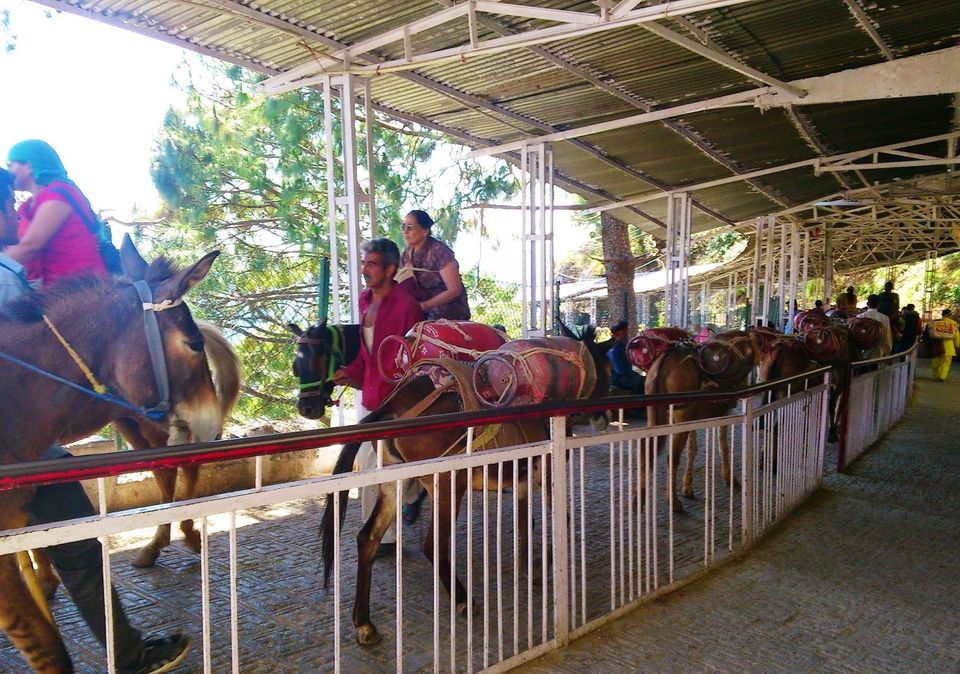
PONIES AND PALKHIS:
Ponies and palkhis are available at Banganga gate. Do pay according to the standard rates decided by the shrine trust. Rates are written on walls. You may still bargain. People with spine/back problems and pregnant women should avoid pony ride.
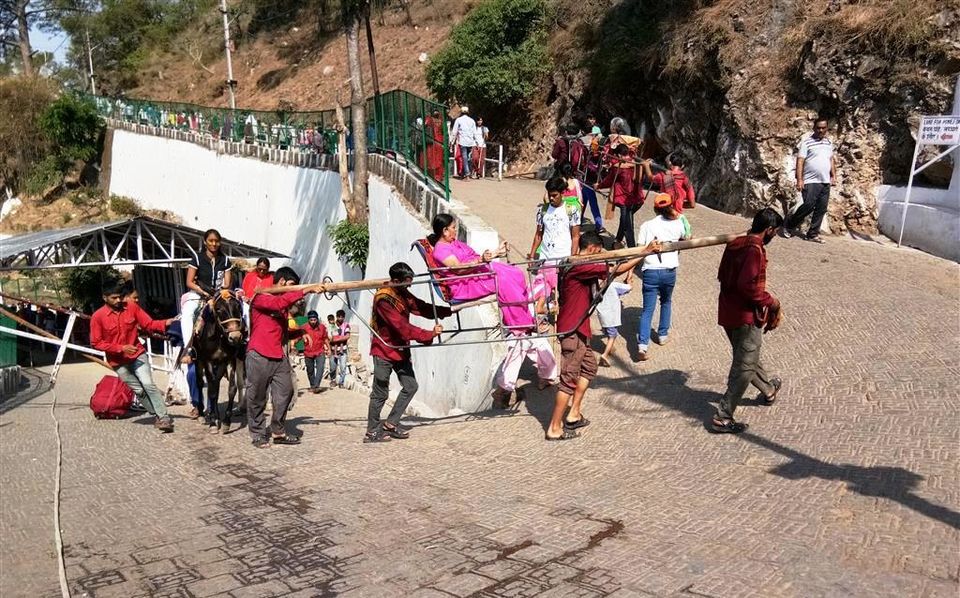
The yatra route is open 24 x7. The trek is 15 km stretch with a good ascent. An athlete/sportsperson walking at normal speed can complete the trek in 3 hours. A regular walk/jog of 10 km for 3 months prior to yatra is advisable.
Must Read: hampta pass trek , sripuram golden temple
There is only one way up and down. Road has proper lighting. It is paved and covered with roofs. Cleanliness level is satisfactory. There are CCTV cameras in-place. Loudspeakers are there all the way for public announcements. Public toilets are easily accessible. The shrine board and pilgrims should strive to maintain the cleanliness.
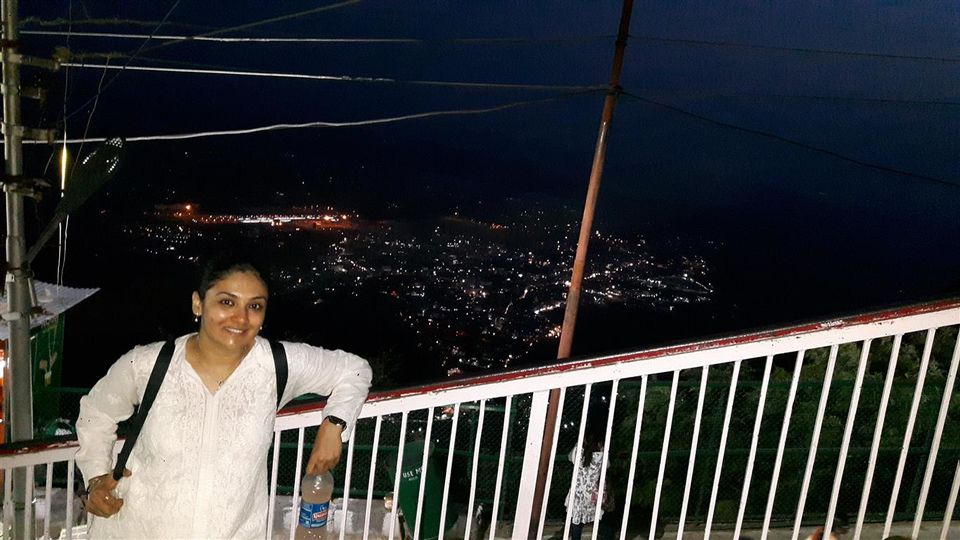
CROWD AND SHOPS:
Crowd depends upon season, weather and holidays. I was told that crowd is at peak during Navratri. The route is wide. Every 15-20 steps you will find shops. Shops are mostly of prasad, souvenirs, dry fruits, snacks and juices, and massage parlours. Shopkeepers are well behaved. Dustbins are around, use it and encourage others to use it.
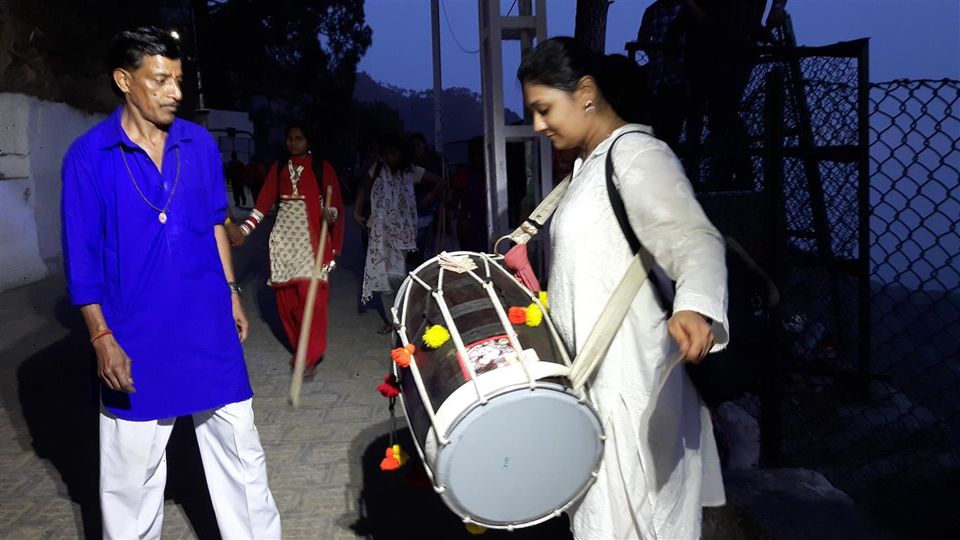
IF SOMEBODY GETS LOST:
There is no chance of people getting lost. By any chance if somebody loses the track of their group/partner/family, cellphones will help. REMEMBER – PREPAID SIM CARDS DO NOT WORK IN JAMMU AND KASHMIR.
If anyone gets lost - don’t panic - just inform the security guards stationed at every 100-200 steps or report at the shrine offices. They will announce names and locate the lost member. Shopkeepers and pilgrims are also supportive. Children are at risk of getting lost. I SUGGEST PINNING SCHOOL I-CARD ON KID’S SHIRT WITH NAME, NUMBER AND ADDRESS OF PARENTS. Also, put your hotel visiting card in their pockets. All pilgrims have to pass through Banganga Gate – entry and exit, the chances of getting detached from your group is rare.
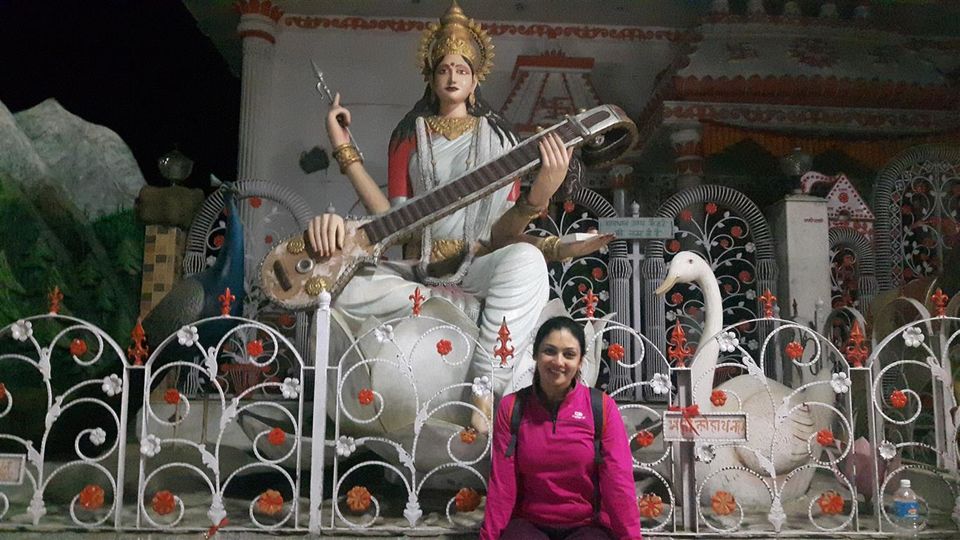
CLIMBING ON FOOT - UP:
The real test is for those who have decided to climb the mountain on foot. If you are a regular runner/jogger/athlete, it will not be tough for you.
My advice for foot pilgrims is to start the trek at sunset if you are climbing up in summer season . You will be at the temple by midnight.
For those who are not regular walkers need not to worry. It is a fun trekking. You can take as many halts. You will see most of the people walking up. This becomes a motivation in itself. You can reenergize yourself with snacks and juices. You can sit down and watch the beautiful sights. You see a mini-India here as pilgrims from different States visit this place. Even at snail pace, you should be near the sanctum sanctorum in less than 10 hours. Some families bring carpets and blankets and take naps or overnight sleep on way. PILGRIMS WHO CLIMB ON FOOT SHOULD WEAR SHOES AND TREK SUITS. NO JEANS or TIGHT CLOTHES.
DEPOSITING CELLPHONE, SHOES, BAGS:
There comes a point 3-km before the Mata Mandir where they have locker facility (free of cost). You have to deposit footwear, bags, cellphones or any metallic thing in the locker. You can carry only prasad and cash after this point. This is the last check point. There is a single queue for ladies and gents (sometimes ladies queue is different). This queue takes you through narrow marbled caves. Don’t try to jump the queue. It is a fast-moving queue, your turn will come soon. Both queues ultimately open at the same place.
BUYING PRASAD:
The place where you deposited your belongings has kiosks where the “official prasad" is sold. You will get a “prasad kit” in a bag with shrine’s logo.
DEVI DARSHAN:
The cave road divides into two somewhere in the middle. No need to worry if your group members take other road as both the roads will open at the same place. Follow the instructions written on walls. Then at a sharp turn you will see the " Vaishno Devi Mata ". Pujaris and security are lined up there to manage the crowd. You will get less than 2 mins to pray. You are 10 feet away Mata. Since you have deposited cellphone and cameras you can't take photos inside the temple.
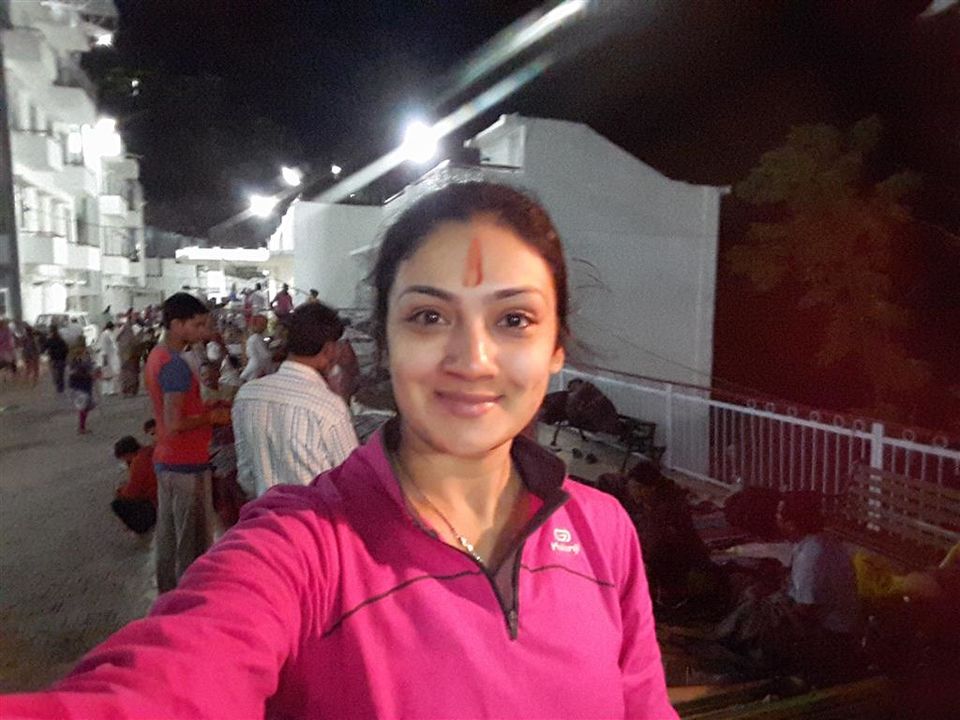
AFTER DARSHAN:
After darshan you come out of caves and you start taking deep breaths. The ambience at the top is divine – a feeling that can’t be expressed in words! Now a common road will lead you to the place where you deposited your belongings. Collect your belongings and return them the keys.
TREK TO BHAIRAVNATH:
Bhairavnath shrine is a few more kilometers up from here. You can take a long break before you start for Bhairav Mandir. Quality food is available in number of outlets at this point. Outlets like Café Coffee Day have kiosks here. Best part is that they are all no-profit outlets. You get food at subsidized rates. After a 30 mins to an hour break, you should start for Bhairavnath Mandir.
CLIMBING DOWN ON FOOT:
Descent is tougher than ascent. You can develop thigh or knee pain. Massage centers are available. While coming down towards Banganga gate, you can buy souvenirs and collectibles. If you are doing Bhairavnath trek, there is ANOTHER ROAD towards Banganga. This road is less crowded. It meets the main route in the middle.
STEPS OR PAVED ROAD?
Steps will make your journey shorter, but it requires good amount of thigh strength. Paved roads have rush of pilgrims and ponies. You can alter between the paved roads and steps.
PHONE AND INTERNET:
Only POSTPAID or local SIM CARDS work here. Cellphone and internet are well within range.
WHAT TO WEAR?
Seasonal clothing, wear loose clothes maintaining the decency and sanctity of the place. Avoid tight and fashionable clothes. It will only make your journey tougher. Women should avoid wearing heavy makeup (trek can sweat you profusely on a warm day) and expensive jewelry. Though there are no reported cases of pick-pocketing or thefts, one should not take chances. Shoes with good grip are most important. Chappals and sandals will slow down your speed and may result in boils and blisters on feet.
WHAT ALL SHOULD BE IN MY BAG?
Bag should be a handbag/school-bag size. Avoid polythene bags. Water bottles, napkins, towel, extra tee-shirt, energy drink (glucose etc.; avoid Coke, Pepsi), light snacks, toilet kit (soap, handwash, deodorants), torch, money, charger, old newspapers for rough use, carpet or bed sheets. Your own visiting card or a chit with your name and number and the local hotel/accommodation card should be in your pocket and bag and with every member of your group. The less weight you carry - the better!
MEDICAL AID:
Carry your medicines and mini first aid box. There are dispensaries on the route. Chronic patients should consult their doctors before taking up this yatra.
HOW MUCH CASH SHOULD I CARRY?
For solo up to a group of three, minimum cash in hand should be Rs. 7,000/-. You will definitely not spend it all. By any chance if a member gets medical issues say, an ankle twist or sprain or develops cramps, you will have to hire a pony or palkhi. Don’t rely on ATMs. For a 15 km trek lasting 10 hours, one person will spend an average of Rs. 500-1000 on juices, tea, snacks, prasad, donations etc.)
Shopping should be done on way back. Souvenirs, devi mata photos, prasad, dry fruits, etc. are decked up at thousands of shops on both the sides along the route. Most shops are open 24x7.
PONIES, DONKEYS AND MONKEYS:
For foot pilgrims, marching ponies are a big nuisance. They hurriedly cross your road or come from the opposite directions. They stink badly. Donkeys, used to carry ration and supplies to the top, also irk a walker. They do have separate lane marked for them, but neither pilgrims nor the pony men follow it. Monkeys, not present throughout the way, have an eye on eatables. You are at risk of getting your eatable robbed by the monkeys. Keep distance from animals. Don't throw stones at them.
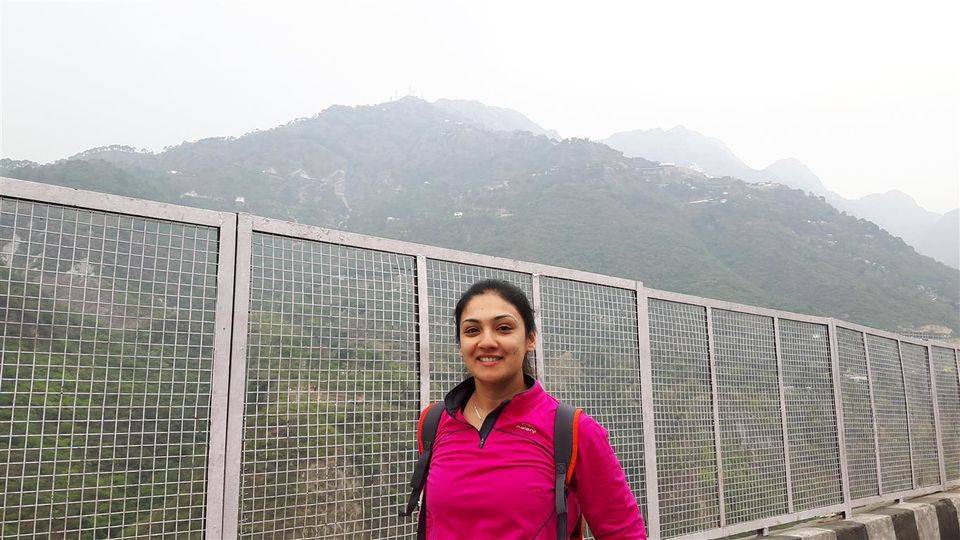
MAPS AND DIRECTIONS:
You don’t need maps or guides here. The flow of pilgrims will take you to the temple. You won’t get lost as there is only one route! If you want to check the distance and altitude, you can always use the fitness apps.
LOCALS’ BEHAVIOR?
Locals (service providers like drivers, shopkeepers, pony men, hotel staff etc.) are good people and cooperative. This may be due to their busy business owing to the large and continuous inflow of pilgrims. You don’t have risk of getting cheated as there are many options available and rates are decided by shrine trust or taxi/hotel unions.
BE A RESPONSIBLE PILGRIM:
My request to all pilgrims is to behave responsibly. Don't loiter the place. Use dustbins to dispose off trash. There are no beggars, but if you find any, don't encourage them by giving alms. Don't make other pilgrims uncomfortable. Don't touch or harass the animals. Help others as need be, especially, the elderly.
Enjoy the trek. Jai Mata Di.
Frequent searches leading to this page:-
tour package from delhi to katra, mata vaishno devi package from delhi, vaishno devi tour package from hyderabad, vaishno devi package 2 night 3 days, vaishno devi tour package from bangalore, vaishno devi tour package from delhi by volvo, jammu to vaishno devi tour package
Jammu Packages

More Stories For Jammu
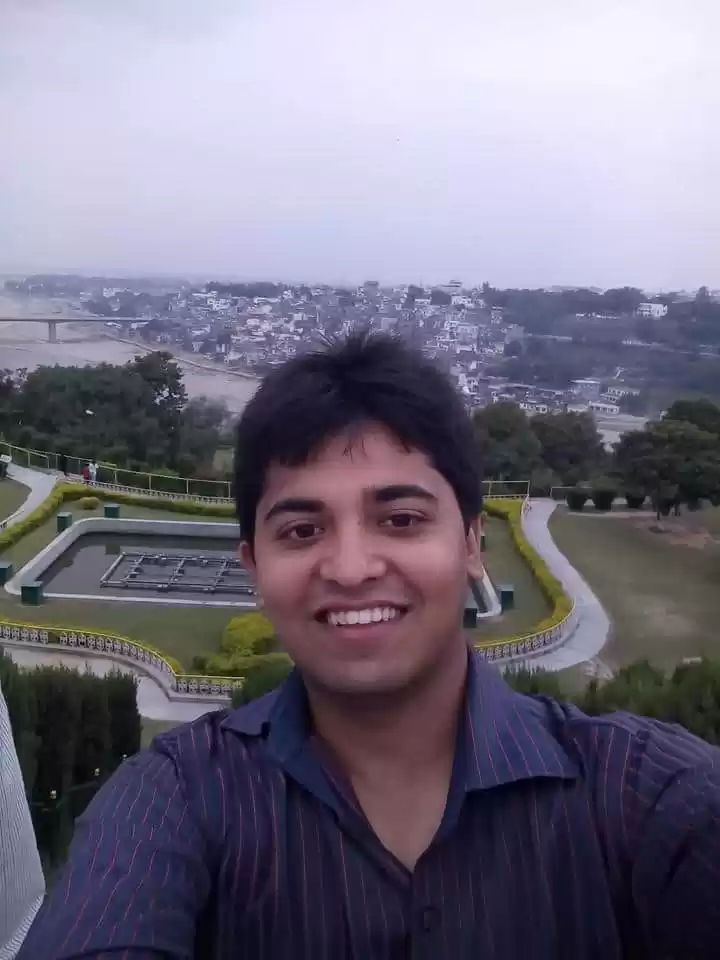
Further Reads
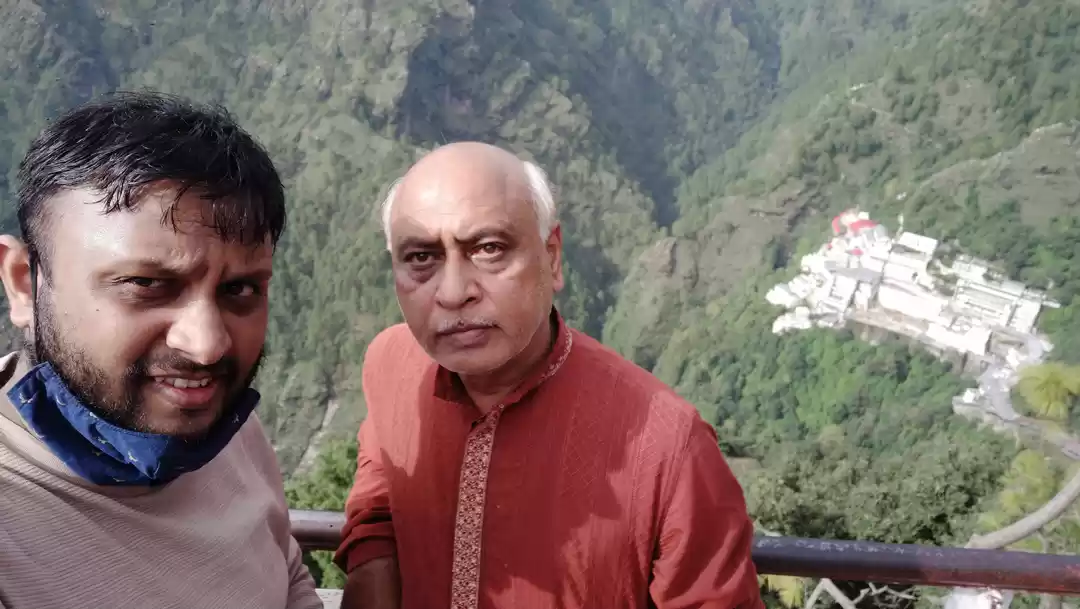
Vaishno Devi Trek Routes
Published by rahul on april 25, 2024 april 25, 2024.
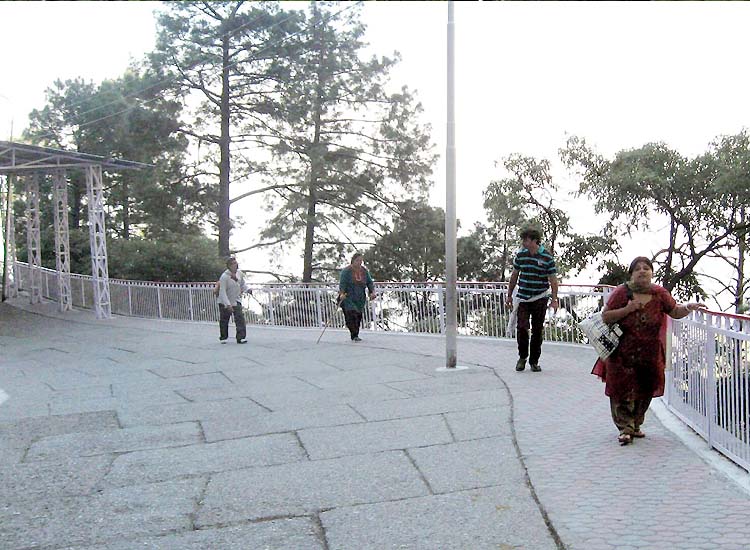
The Vaishno Devi pilgrimage in Katra, India, is a sacred journey undertaken by millions every year. The trek itself, nestled amidst the scenic beauty of the Himalayas, is a test of both physical and spiritual resilience. But fret not, for multiple Vaishno Devi trek routes cater to pilgrims of all abilities. This blog will be your one-stop guide to navigating these routes.
The Traditional Route: A Classic Climb
The original Vaishno Devi trek route is a 13 km uphill climb, starting from Katra. This path, while challenging, offers stunning views and a deep sense of accomplishment. Here’s what to expect:
- Terrain: The route is a mix of paved walkways and steeper inclines with stairs.
- Difficulty: Moderate to difficult. Be prepared for a strenuous trek.
- Accessibility: Ponies and palanquins are available for those needing assistance.
The Alternate Route: A Shorter Path
Opened in 1999, the alternate route offers a slightly shorter (around 500 meters) and less strenuous option. This route features:
- Terrain: A wider, well-maintained path with fewer steep climbs.
- Difficulty: Easier than the traditional route.
- Accessibility: Not accessible for ponies or palanquins. Battery-operated rickshaws are available on certain stretches.
The New Adhkuwari Ropeway: A Modern Marvel
For those seeking a more convenient way to reach the Adhkuwari stop, the new ropeway offers a comfortable and scenic ride. This can be particularly helpful for elderly pilgrims or those with limited mobility.
Choosing the Right Route for You
The ideal Vaishno Devi trek route depends on your fitness level, preferences, and time constraints. Here’s a quick guide:
- For the physically fit and adventurous: Opt for the traditional route.
- For those seeking a shorter and easier climb: Choose the alternate route.
- For elders or those with limited mobility: Consider the ropeway to Adhkuwari, followed by a walk to the Bhawan.
Additional Tips for a Smooth Yatra
- Plan your trip: Book your yatra registration (parchi) in advance, especially during peak season.
- Pack light: Carry only essentials like comfortable walking shoes, warm clothes (for evenings), and basic toiletries.
- Stay hydrated: Especially crucial during the climb. Carry a reusable water bottle.
- Respect the pilgrimage: Dress modestly and maintain decorum throughout the trek.
Embark on Your Spiritual Journey
With its diverse Vaishno Devi trek routes, the pilgrimage caters to all devotees. So, choose your path, embrace the challenge, and embark on a transformative journey towards the holy shrine of Mata Vaishno Devi.
Related Posts
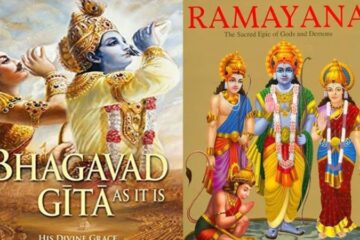
Why should everyone read Bhagavad Gita and Ramayana?
The Gita and Ramayana, two ancient Hindu epics, offer a wealth of wisdom and timeless values that can enrich the lives of people from all walks of life. These texts, filled with profound philosophical insights, Read more…
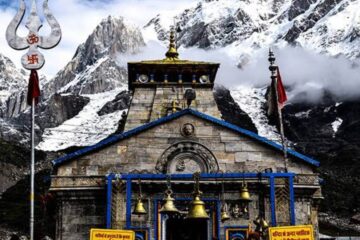
Kedarnath Temple And Its Connection to Mahabharata
Nestled amidst the majestic Himalayas, Kedarnath Temple stands as a testament to India’s rich spiritual heritage. Its serene beauty and ancient history have captivated devotees for centuries. The temple’s connection to the epic Mahabharata adds Read more…

Indian Temple Los Angeles
Indian Temples in Los Angeles: A Spiritual Haven Los Angeles, a city renowned for its glitz and glamour, also serves as a vibrant hub for diverse cultures. Among the many cultural touchstones in the city Read more…
WhatsApp us
- Privacy Policy

Katra to Vaishno Devi Trek (14 km)
Vaishno Devi Trek is a popular pilgrimage route located from Katra to Bhawan in the Indian state of Jammu and Kashmir. The trek begins at the town of Katra and ends at the Vaishno Devi shrine, which is located in the Trikuta Mountains.
Katra to Vaishno Devi Distance
Katra to Vaishno devi covers a distance of approximately 14 kilometers and involves a climb of about 3,500 feet.
This route stretches from Katra to Bhawan and is well-maintained. It has facilities such as rest areas, refreshment stalls, and medical facilities.
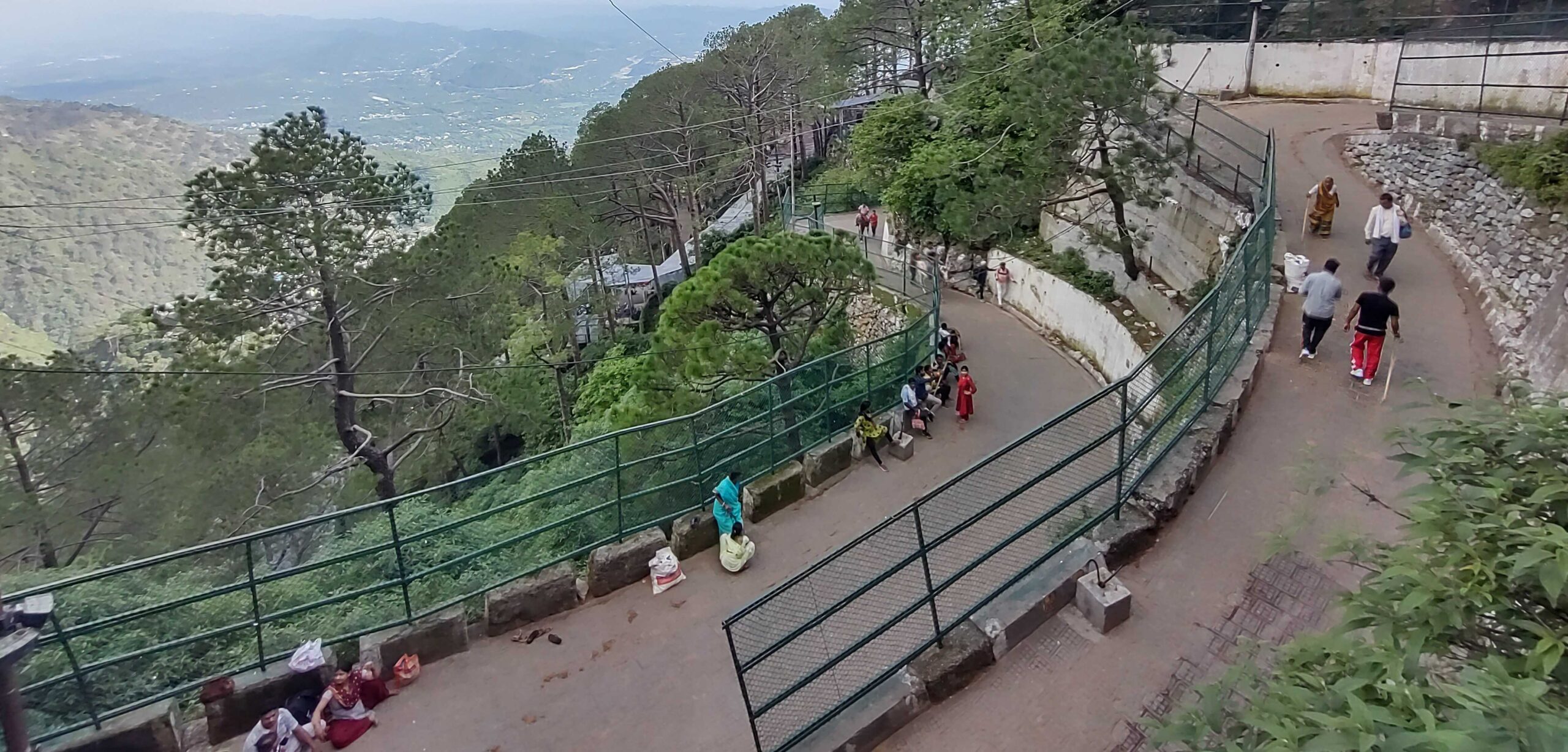
It is a steep uphill climb, and many pilgrims prefer to undertake the journey on foot. However, pony and palanquin services are also available for those who may find it difficult to climb on foot.
Pilgrims can undertake the trek on foot or by hiring a pony or palanquin. The journey can take between 4 to 6 hours depending on the pace of the trekker.
The trek is considered to be a spiritual and physical challenge, with many pilgrims undertaking the journey as a form of penance or devotion. It is important for pilgrims to prepare adequately for the trek by wearing comfortable clothing, carrying enough water and snacks, and consulting a doctor if they have any pre-existing medical conditions.
Overall, the Vaishno Devi Trek is a unique and memorable experience for those who undertake it, combining physical exertion with spiritual devotion.
The Vaishno Devi trek is a popular pilgrimage route in India that leads to the Vaishno Devi temple, a holy shrine dedicated to the Hindu goddess Mata Vaishno Devi. The temple is located in the Trikuta Mountains of Jammu and Kashmir, at an altitude of approximately 5,200 feet.
The trek to Vaishno Devi temple is considered to be a challenging but rewarding journey, with devotees often undertaking it to seek the blessings of the goddess. The trek starts from the base camp at Katra, which is approximately 35 km from the city of Jammu and covers a distance of around 14 km to reach the temple.
The trek is generally divided into two parts – the first part is a 6 km climb from Katra to the town of Adhkuwari, and the second part is an 8 km climb from Adhkuwari to the Vaishno Devi temple. The trek passes through rugged terrain, steep slopes, and narrow paths, and can take anywhere between 5 to 8 hours to complete, depending on one’s fitness level and pace.
To make the journey easier, the Shrine Board has provided various facilities along the trek, such as resting places, medical aid centers, and refreshment stalls. Helicopter services are also available for those who cannot undertake the trek due to age or health-related issues.
Overall, the Vaishno Devi trek is a popular and spiritually uplifting experience for devotees who undertake it, with breathtaking views of the surrounding mountains and a sense of accomplishment upon reaching the temple.
How to Reach Vaishno Devi?
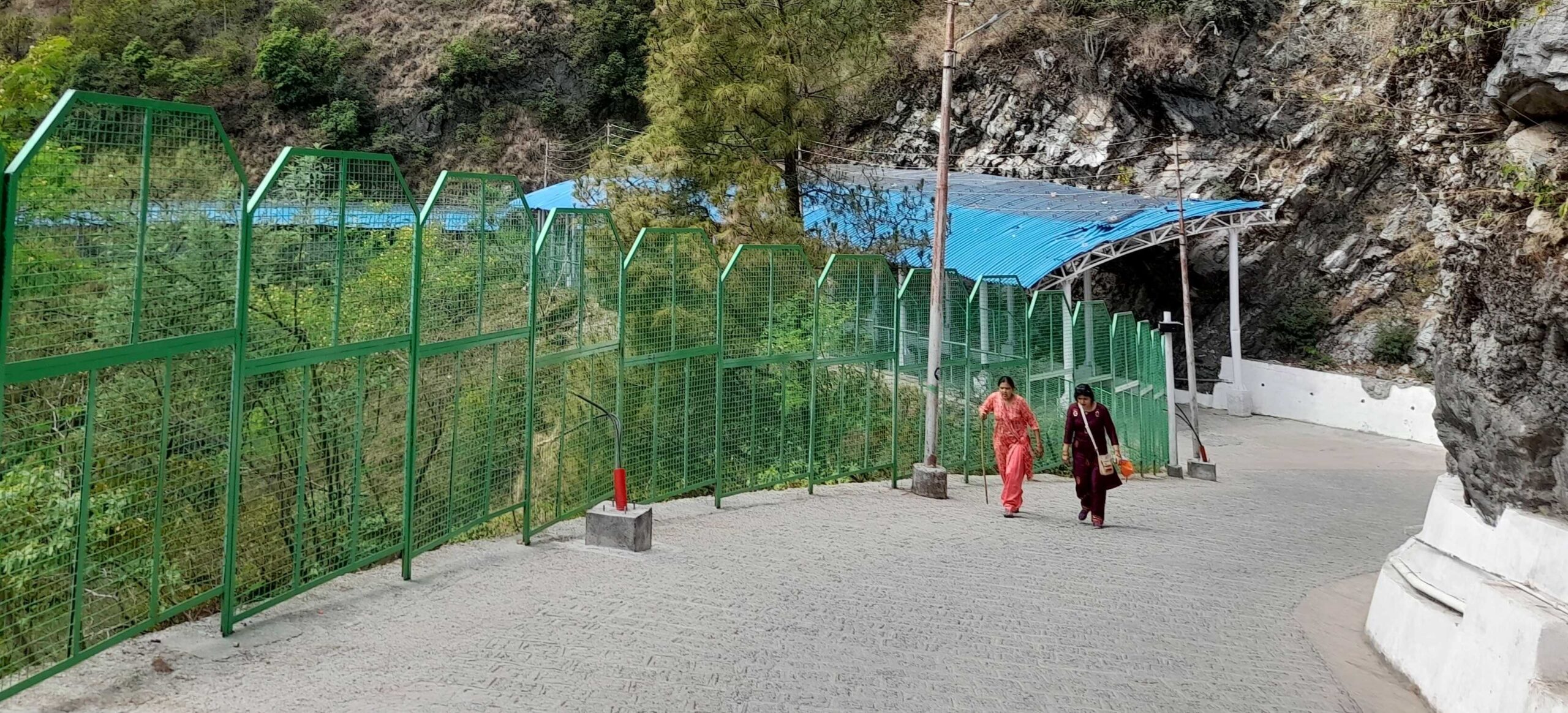
The distance between Katra to Vaishno Devi is approximately 14 kilometers. Katra to Bhawan (Vaishno Devi) is the route that devotees take to visit the holy shrine. Here are the different ways to reach Bhawan from Katra:
Katra to Vaishno Devi on Foot :
The most popular way to reach Bhawan is by trekking on foot from Katra. The trek is around 13.5 km long, and it takes around 4-6 hours to reach Bhawan, depending on your fitness level. The trek is well-marked and well-lit, and there are several facilities such as restrooms, eateries, and medical aid centers along the way.
Katra to Vaishno Devi by Ponies or Horses :
You can also hire a pony or a horse to reach Bhawan from Katra. The cost of hiring a pony or a horse depends on the season and the demand. The journey takes around 4-5 hours, and it is a popular option for those who are unable to trek on foot.
Katra to Vaishno Devi by Helicopter :
You can also take a helicopter from Katra to Sanjichhat, which is located near Bhawan. The helicopter service is operated by the Shri Mata Vaishno Devi Shrine Board, and it takes around 8 minutes to reach Sanjichhat. From Sanjichhat, you can trek to Bhawan or take a pony or a horse.
Note that due to weather conditions and demand, the availability of the helicopter service may vary, and it is recommended to book your tickets in advance.
Places in the Route of Katra to Vaishno Devi (14 km)
- Darshani Darwaaza (Starting Point)
- Holy Track 1: Old Track
- Holy Track 2: New or Alternate Track
- Charan Paduka
- Bhairon Ghati
- Reaching Bhawan
Also Read: History of Vaishno Devi
1. Darshani Darwaaza (Starting Point)
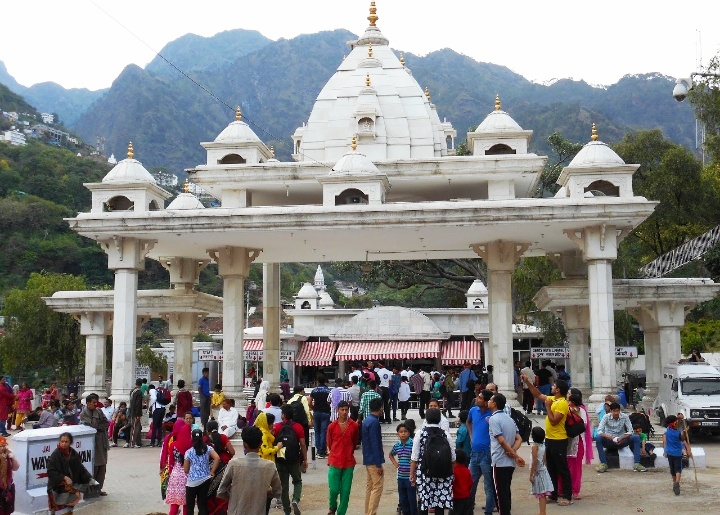
The point known as Darshani Deodhi or Darshani Darwaza, around 1 km away from the bus stand, serves as the entrance to the track. According to legend, it was at this spot where Mata Vaishno Devi appeared as a young girl and met Pandit Shridhar.
This location is also called Darshani Darwaza as it offers a complete view of the Trikuta mountain. The term “Darshan” means view, and therefore, symbolically, this marks the first view of the Yatra. The elevation of this spot is 2800 feet above sea level.
2. (i) Holy Track: Old Track (Main)
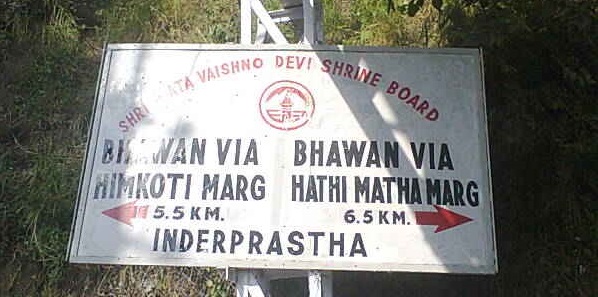
The track leading up to the Shrine was in poor condition prior to August 30th, 1986, when the management was taken over by the Board. It was filled with potholes, and loosely-laid stones, and had an uneven surface. However, after the Board took over, the entire track was reconstructed.
It was widened, paved with tiles, and made much smoother. In addition, the steep inclines were made more gentle in several places. For safety, many parapets were built, and railings were installed along the track. Furthermore, over 5 kilometers of the track have been covered with rain shelters to protect the pilgrims from unpredictable weather conditions.
Previously, there was a lack of illumination along the track leading to the Shrine. However, with the installation of more than 1200 High-Pressure Sodium Vapor Lamps, the entire path now glitters with light.
Additionally, to ensure that visiting devotees have access to potable water, 120 water points and about 20 water coolers have been installed along the route from Banganga to Bhawan. Before the management takeover, there were inadequate sanitary arrangements along the track.
However, now, approximately 600 modern flushing latrine seats have been provided along the track and at Bhawan.
2 (ii) Holy Track: New Track (Alternate)
To address the growing number of pilgrims and the inconvenience caused by the movement of ponies, a new track was constructed in the early 1990s. The sharp gradient at Hathimatha and the congested width of the old track necessitated this construction.
The new track, known as the alternate track, has a much more gradual gradient and was opened to the public in 1999. Unlike the old track, no ponies are permitted on the new track. This shorter and gentler track has received widespread appreciation from pilgrims.
The alternate track, which is 500 meters shorter than the old track, begins just below Adhkuwari near the Inderprastha viewpoint and ends just short of the Bhawan Complex.
The track is wider than the old one and easier to navigate due to its uniform climb and lower gradient. Along the way, there are two viewpoints, three refreshment units, drinking water points, and water coolers for the convenience of the pilgrims.
Additionally, several outlets serving tea, coffee, and soft drinks have been established, as well as a Dosa point at Himkoti Viewpoint. Toilet blocks have also been constructed to provide clean public utilities, and adequate shelter sheds are available.
To reduce pollution, a zero-emission battery vehicle runs along this track.
The Shrine provides a battery vehicle facility for infirm, sick, and handicapped devotees at Inderprasth (Adhkuwari) and Manokmana Bhawan. However, booking of the facility is subject to availability.
3. Ban Ganga
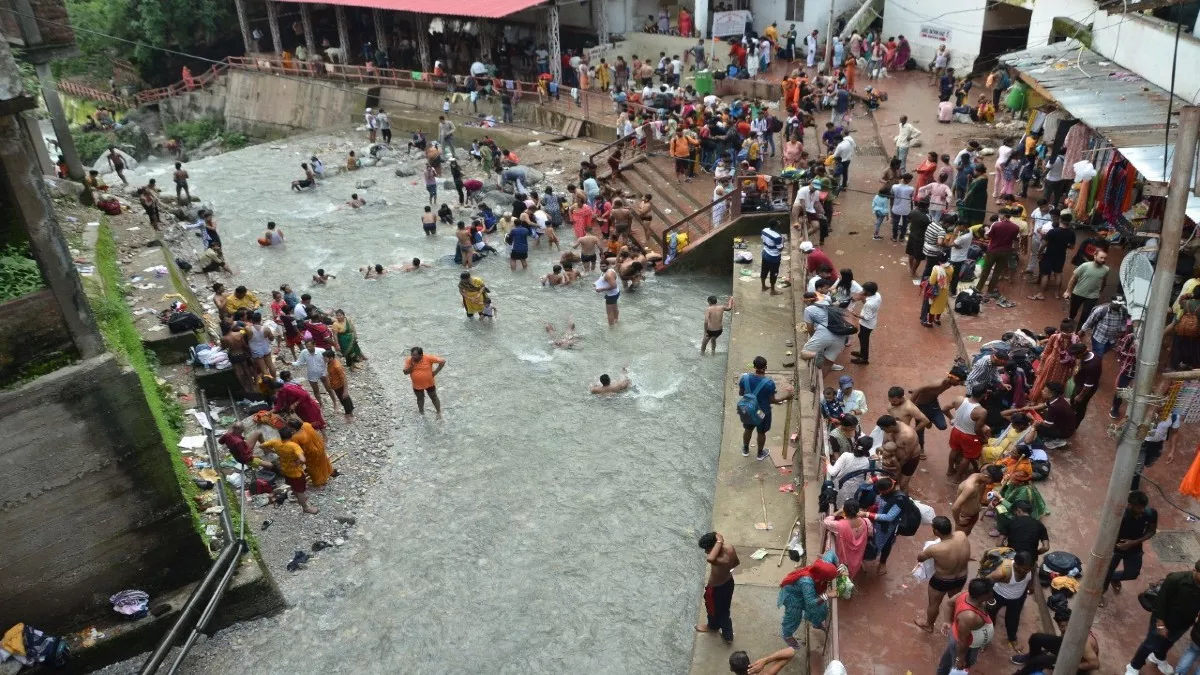
Beyond the Police Check Post and Yatra Parchi Check Post, pilgrims arrive at a small bridge that spans Banganga, a legendary river associated with the miracles and legends of Mata.
The river flows throughout the year, except during periods of acute rainfall or snowfall shortages in the monsoon and winter seasons, respectively.
It is considered sacred, and in keeping with Hindu tradition, many devotees like to take a bath in it before continuing on their journey. However, in modern times, many pilgrims choose to skip this traditional bath.
Nonetheless, those who have the time or are inclined to follow the legends and traditions may choose to take a dip in the river. There are a couple of Ghats constructed for this purpose, with the first one being typically very crowded and the other being comparatively more spacious.
The river flowing under the small bridge, which is considered sacred by the pilgrims, is known as Banganga. The name is derived from two words, “Ban” which means arrow, and “Ganga” which refers to the sacred river Ganges.
According to legends, while on her way to the Holy Cave, Mata Vaishno Devi created this water body with an arrow from her quiver, giving it the name Banganga. It is also believed that she had taken a dip in it and washed her hair. Hence, some people refer to it as Bal Ganga, where “Bal” refers to hair in Hindi.
4. Charan Paduka
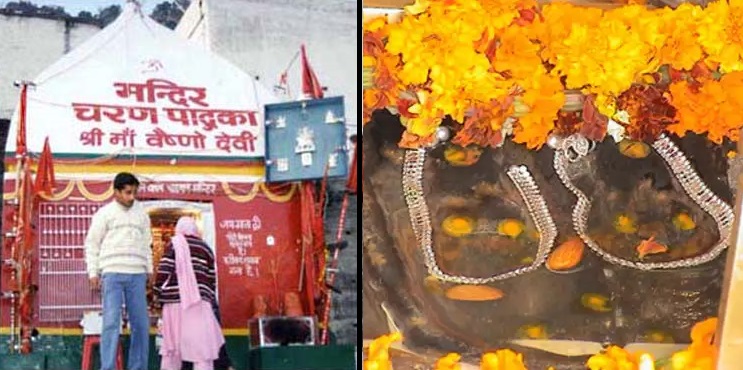
Charan Paduka is located at an altitude of 3380 feet, approximately 1.5 kilometers from Banganga. It is believed that the holy footprints of Mata are imprinted on a rock slab at this site.
Darshans at Charan Paduka are quick, taking only a few minutes on a normal day. Pilgrims pay their respects to the footprints of Mata engraved on the rock slab and continue their journey, symbolically touching Mata’s feet and seeking her blessings at the start of their pilgrimage.
A medical unit operated by the Shrine Board is also situated here. Equipped with all necessary medical facilities and attended by trained medical staff, it provides pilgrims with access to essential medical care.
5. Adhkuwari
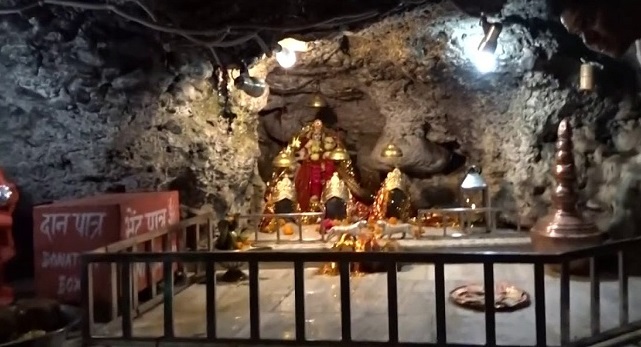
Adkuwari is located at an altitude of 4800 feet and about 500 meters from Inderprastha. The fluttering flag and temple spires can be seen and announcements can be heard from the announcement booth much before reaching there.
Adkuwari is situated halfway on the track, approximately 6 km from Katra, and is an important Darshan on the visit, second only to the main Darshans at the Holy Cave.
The term Adkuwari is believed to have originated from Adi kumari, meaning “The Eternal Virgin”. According to legend, Vaishnavi, in the form of a small girl, disappeared from the Bhandaara organized by Pandit Shridhar and halted at Banganga and Charan Paduka.
She then reached Adkuwari, where she meditated and observed spiritual discipline (Tapasya) in a small womb-shaped cave for nine months. The exact spot where she meditated is located on the right-hand side of the cave and is also shaped like a womb.
This cave has become popular by the name of Garbh Joon, meaning the Womb, since Vaishnavi had observed spiritual discipline in a womb-shaped cave for nine months. It is believed that passing through this cave cleanses a devotee’s sins and purifies their soul.
During her meditation, when Vaishnavi realized that Bhairon Nath had approached the cave in search of her, she created an exit at the other end with her trident and proceeded toward the Holy Cave.
As the cave is very narrow, only one person can pass through it at a time. While the entrance is broad, as one enters further, it becomes a challenge to pass through.
However, with a prompt or a nudge from the person waiting behind, remembrance of Mata in the heart and on the lips, and crawl by crawl, one emerges from the cave, fully recharged with energy that belongs to another world.
Additionally, a medical unit of the Shrine Board is located at Adkuwari and is equipped with all necessary medical facilities attended by trained medical staff.
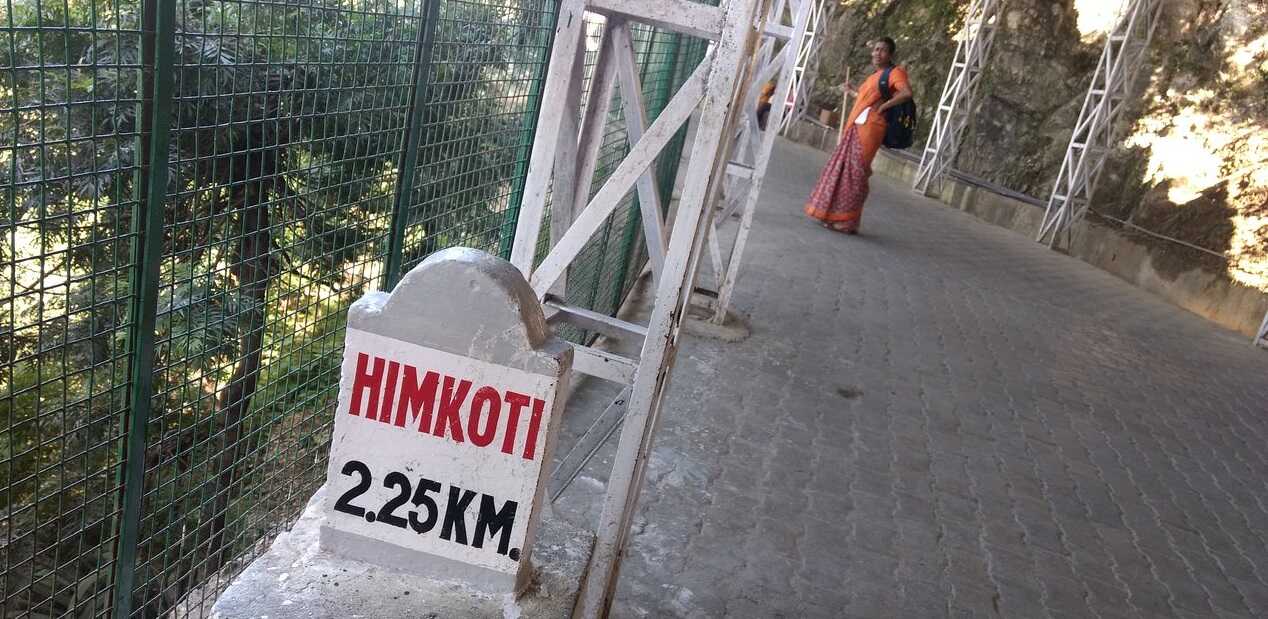
Located about 2.75 kilometers from Adkuwari on the new track, Himkoti is a scenic spot offering breathtaking views of the entire valley. While there is no traditional or religious significance attached to this point, its natural splendor and serene charm captivate pilgrims and visitors alike.
The Shri Mata Vaishno Devi Shrine Board has developed a viewpoint, restaurant, and dosa counter at this location. Visitors can find packed and cooked food, hot and cold beverages, and essential items such as medicare and oxygen cylinders, and cassettes.
There is ample space to relax and enjoy the beauty of nature. Himkoti is being developed into something more than a viewpoint, with plans to add an artificial pond, a garden, and a meditation center.
7. Sanjichhat
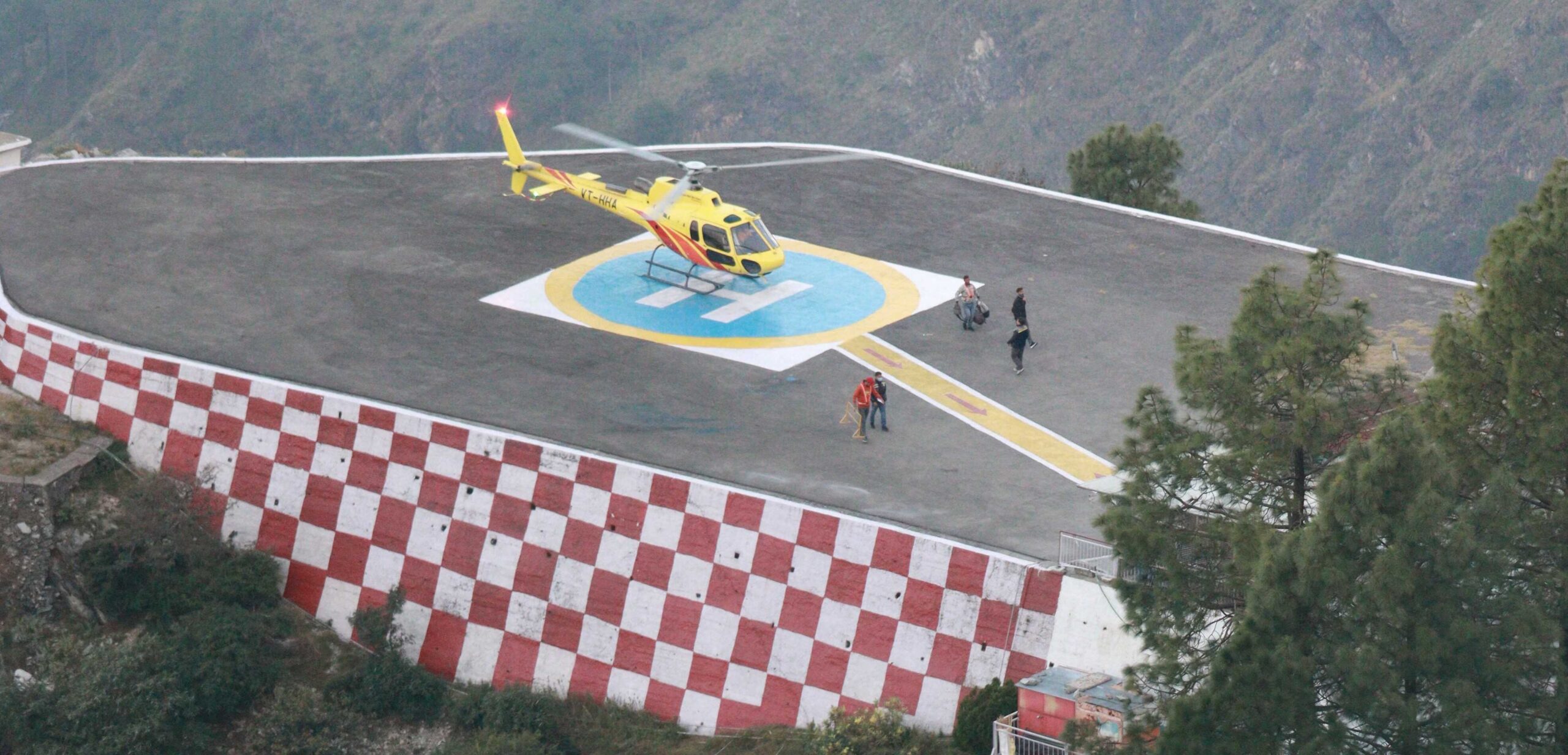
Sanji Chhat, located two and a half kilometers away from the Holy Shrine of Vaishno Devi Ji, is a charming little plateau. This place serves as a welcome break for pilgrims, as the upward climb ends at this point and it also offers a picturesque view. Prior to the Shrine Board’s takeover in 1986, the conditions at Sanji Chhat were vastly different.
The area was cluttered with small, unsanitary kiosks and shopkeepers would discard their waste on the hillside, creating an unpleasant sight and odor. There were no proper arrangements for drinking water, except for Chhabils.
The Dharmarth Trust had constructed a Dharamshalla, but the accommodation was extremely inadequate, with almost non-existent toilet facilities.
Sanjhichhat underwent a significant transformation after the Shrine Board took over its management. The first step was a massive sanitation drive to clean up the hillside. The small, unsanitary kiosks were removed and relocated, while the main platform was reconstructed with white marble and Kota Stone, adorned with a fountain and floodlights.
New shopping complexes and toilet blocks were also erected, and the water supply was improved. To enhance medical facilities for pilgrims, a 24-bed hospital was established. Additionally, a new helipad was constructed to allow for the recent introduction of helicopter services between Katra and Sanjhichhat.
8. Bhairon Ghati
Prior to the takeover of the holy Shrine by the Shri Mata Vaishno Devi Shrine Board in the year 1986, the Bhairon Temple was ignored and the track leading to the temple was in a dilapidated condition, making the climb a grueling task.
However, after the takeover, significant emphasis was placed on developments in this area, particularly the widening and beautification of the track, remodeling of steps, and the construction of rain shelters and toilets.
Additionally, the entire track has been illuminated with High-Pressure Sodium Vapour Lamps and the water supply has been augmented. For the convenience of the pilgrims, toilet blocks have also been constructed and a refreshment unit named OM has been started to provide adequate and reasonably priced beverages and packed food items such as biscuits and snacks.
The Temple area has been beautified by fixing marble tiles and slabs along the pre-ambulation of the temple. As a result of these efforts, the visit of the pilgrims to the Bhairon temple is now much more convenient and memorable.
9. Vaishno Devi Darshan at Bhawan
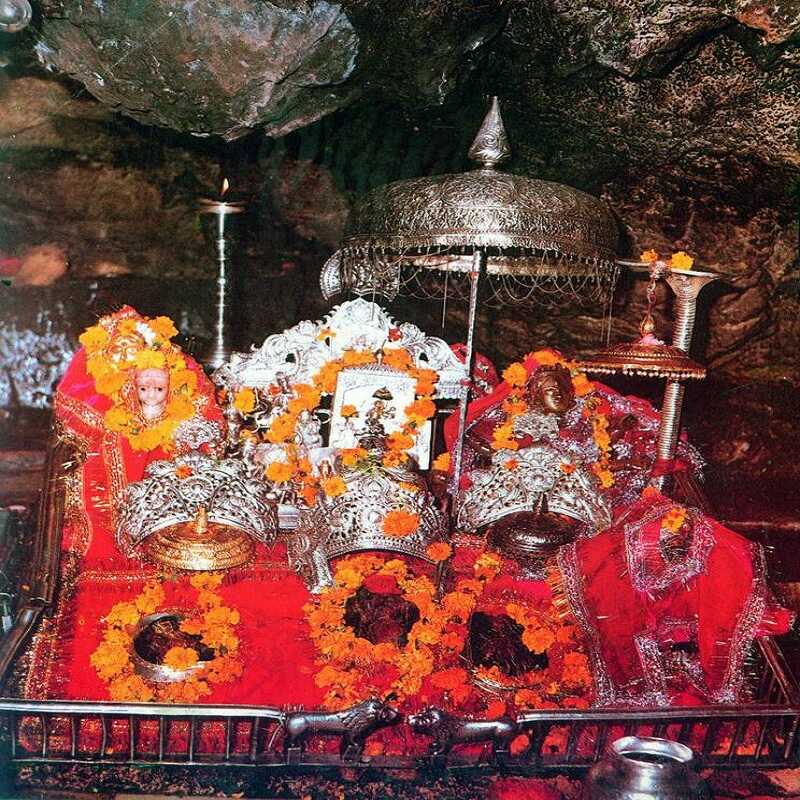
The ultimate destination of the pilgrims, the Holy Bhawan houses the Sanctum Sanctorum – the Holy cave, where the Goddess has revealed herself in the form of Holy Pindies, manifesting Mata in her three forms Maha Kali, Maha Lakshmi, and Mata Saraswati.
Around 1.5 kilometers before reaching the Holy Bhawan, a pilgrim catches the first glimpse of it, which brings an upsurge of energy, and all the tiredness from the strenuous climb evaporates instantly, as if by some magic wand.
The relief of the last 1.5 kilometers being either level or gently sloping downwards eases the tired muscles. Filled with extra fervor and devotion, the yatra covers the last 1.5 kilometers on wings and reaches Bhawan in no time.
Legend has it that Vaishnavi, after leaving the Garbh Joon cave at Adhkawari where Bhairon Nath had located her, began climbing uphill until she reached the Holy Cave. Bhairon Nath, who was following her, found her again inside the cave and started to challenge her.
The Goddess then assumed her divine form and severed Bhairon Nath’s head with her sword. The blow was so powerful that Bhairon Nath’s head flew and landed on another spur of the mountain, about 1.5 kilometers away, which is now the site of the Bhairon Temple.
His torso remained at the mouth of the Holy Cave. The Goddess then immersed herself in deep meditation inside the Sanctum Sanctorum, where she is manifested in the petrified form, also known as the Holy Pindies, representing Mata in her three forms – Maha Kali, Maha Lakshmi, and Mata Saraswati.
The Holy Bhawan is the focal point of the pilgrimage and the most important location in the entire Yatra circuit. The Shrine Board has made extensive arrangements and facilities available for the convenience of the devotees.
These include both free and rented accommodation options, toilet blocks, Bhojanalayas, post offices, banks, communication centers offering STD/PCO services, announcement centers, blanket stores, cloakrooms, medical dispensaries (with an ICU), general stores, Bhaint shops, and a police station, among others.
Related Posts
Vaishno Devi Temple’s Distance from Major Cities of India.
- New Delhi To Vaishno Devi
- Mumbai To Vaishno Devi
- Jammu To Vaishno Devi
RELATED ARTICLES
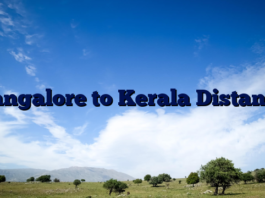
Bangalore to Kerala Distance

Hubli to Goa Distance by Road, Train Ticket Price, Flights
Shirdi to goa distance by road, train ticket price, flights, no comments, leave a reply cancel reply.
Save my name, email, and website in this browser for the next time I comment.
Vaishno Devi trek
The Vaishno Devi legend is an important part of Hindu mythology in India. According to the story, Vaishno Devi was a devotee of Lord Vishnu who meditated in the Trikuta Mountains. She was pursued by a demon named Bhairon Nath, who wanted to marry her.
To escape, Vaishno Devi hid in a cave for nine months, where she meditated and prayed. The legend states that she emerged as a powerful goddess and defeated Bhairon Nath. The cave where Vaishno Devi is said to have meditated is now known as the Holy Cave of Vaishno Devi.
It has become one of the most significant pilgrimage sites in India, attracting millions of visitors annually. Pilgrims often undertake a challenging journey to reach the cave, which is located at an altitude of 5,200 feet (1,585 meters) in the state of Jammu and Kashmir. The pilgrimage to Vaishno Devi is considered highly auspicious in Hinduism.
Many devotees believe that visiting the Holy Cave can lead to the fulfillment of wishes and spiritual enlightenment. The site’s religious significance has contributed to the development of infrastructure in the region, including accommodation facilities and transportation services for pilgrims. The Vaishno Devi legend continues to be an integral part of Indian cultural and religious traditions.
It is passed down through generations and remains a source of inspiration for many devotees. The story exemplifies themes of devotion, perseverance, and the triumph of good over evil, which are common in Hindu mythology.
Key Takeaways
- Vaishno Devi is a revered Hindu pilgrimage site located in the Trikuta Mountains in Jammu and Kashmir, India.
- Pilgrims should prepare for the trek by wearing comfortable clothing and footwear, carrying essential items like water, snacks, and first aid kit, and being mentally and physically prepared for the challenging journey.
- The trek to Vaishno Devi involves a 13-kilometer uphill climb with varying terrain, including steep inclines, narrow pathways, and rocky surfaces.
- Important tips for the trek include staying hydrated, taking regular breaks, and being mindful of the weather conditions and surroundings.
- The Holy Cave is the ultimate destination of the trek, where pilgrims can seek blessings and have darshan of the three holy pindis. Accommodation and facilities are available for pilgrims at various points along the trek route, including guest houses, food stalls, and resting areas.
- Safety and emergency procedures are in place along the trek route, including security personnel, medical aid stations, and emergency evacuation facilities for pilgrims in need.
Preparation for the Trek
Physical and mental preparation.
The journey to the Holy Cave of Vaishno Devi requires careful planning and consideration. Pilgrims should ensure that they are in good health and capable of walking long distances over rough terrain. The trek is not easy, and it is essential to be physically and mentally prepared for the challenges that lie ahead.
Packing Essentials
It is crucial to pack appropriate clothing and footwear for the trek, as the weather in the mountains can be unpredictable and the terrain can be rugged. Pilgrims should consider the climate and terrain when selecting their attire and gear.
Permits and Documentation
In addition to physical preparation, pilgrims should also make sure that they have all the necessary permits and documentation for the journey. It is essential to obtain a yatra slip, which is a permit that allows entry into the pilgrimage area. This can be obtained online or from designated registration counters in Katra, the base camp for the trek. Pilgrims should also carry identification documents and any other necessary paperwork for their journey.
The Route and Terrain
The trek to the Holy Cave of Vaishno Devi begins in Katra, a town located at the base of the Trikuta Mountains. From Katra, pilgrims must walk approximately 13 kilometers to reach the Holy Cave. The route is well-marked and well-maintained, but it is also steep and challenging in some places.
Pilgrims will encounter a variety of terrain along the way, including rocky paths, steep inclines, and narrow passages. The journey is divided into several segments, with designated rest stops and facilities along the route. One of the most iconic landmarks along the way is the Ardhkuwari Temple, which is located halfway to the Holy Cave.
Pilgrims can take a break at this temple and rest before continuing on their journey. The final stretch of the trek involves climbing a series of steps carved into the mountainside, leading up to the entrance of the Holy Cave.
Important Tips for the Trek
For those embarking on the trek to Vaishno Devi, there are several important tips to keep in mind. Firstly, it is essential to start the trek early in the morning in order to avoid the heat of the day and to allow plenty of time for rest stops along the way. It is also important to pace oneself and take breaks as needed, especially on the steeper sections of the route.
Pilgrims should also carry an adequate supply of water and snacks for the journey, as there are limited opportunities to purchase food and drinks along the way. It is also advisable to carry a small first aid kit and any necessary medications, as well as sunscreen and a hat to protect against the sun.
The Holy Cave and Darshan
Upon reaching the Holy Cave of Vaishno Devi, pilgrims are rewarded with a deeply spiritual experience. The cave is small and dark, with a narrow entrance that leads into a chamber where three natural rock formations are worshipped as manifestations of the goddess Vaishno Devi. Pilgrims must wait in line for their turn to enter the cave and receive darshan, or blessings, from these sacred rocks.
The atmosphere inside the cave is one of reverence and devotion, as pilgrims offer prayers and make offerings to the goddess. The experience of receiving darshan at the Holy Cave is deeply moving for many pilgrims, who feel a profound sense of peace and fulfillment in this sacred space.
Accommodation and Facilities
Range of accommodations.
For those undertaking the trek to Vaishno Devi, there are several accommodation options available in Katra, including hotels, guesthouses, and dharamshalas (pilgrim shelters). These accommodations offer a range of amenities and services to cater to the needs of pilgrims, including comfortable rooms, hot showers, and dining facilities.
Facilities Along the Trekking Route
In addition to accommodation, there are also several facilities available along the trekking route, including rest stops with food and drink vendors, clean public toilets, and medical aid stations.
Support and Assistance for Pilgrims
These facilities are designed to provide support and assistance to pilgrims as they make their way to the Holy Cave.
Safety and Emergency Procedures
While undertaking the trek to Vaishno Devi, it is important for pilgrims to prioritize their safety and well-being. It is advisable to travel in groups or with a guide, especially for those who are unfamiliar with the route or are inexperienced hikers. Pilgrims should also be mindful of their surroundings and take precautions against potential hazards such as slippery paths or inclement weather.
In case of emergencies, there are designated rescue teams stationed along the trekking route who are trained to provide assistance and medical aid if needed. Pilgrims should familiarize themselves with emergency procedures and know how to seek help if necessary. In conclusion, the trek to Vaishno Devi is a deeply spiritual journey that requires careful preparation and consideration.
Pilgrims who undertake this pilgrimage are rewarded with a profound sense of fulfillment and spiritual connection, as they seek blessings from the goddess Vaishno Devi in her sacred cave. By following important tips for the trek, prioritizing safety, and being mindful of their surroundings, pilgrims can ensure a safe and meaningful experience on this revered pilgrimage route.
If you are planning a trip to Vaishno Devi, you may also be interested in exploring other nearby places. Templeyatri.in offers a helpful article on “Places to Visit Near Bagdana, Gujarat” that provides information on nearby attractions to consider adding to your itinerary. Check out the article here for more details. And for more travel tips and resources for visiting Vaishno Devi and other religious sites, be sure to visit templeyatri.in .
What is the Vaishno Devi trek?
The Vaishno Devi trek is a pilgrimage route to the Vaishno Devi temple, located in the Trikuta Mountains in the Indian state of Jammu and Kashmir. It is a popular pilgrimage destination for Hindus, and the trek involves a 12-kilometer uphill climb to reach the temple.
How long does it take to complete the Vaishno Devi trek?
The time taken to complete the Vaishno Devi trek can vary depending on the individual’s fitness level and pace. On average, it takes around 4-6 hours to complete the 12-kilometer trek to the temple.
What is the best time to undertake the Vaishno Devi trek?
The best time to undertake the Vaishno Devi trek is during the months of March to October, as the weather is relatively pleasant and the trekking conditions are favorable. It is advisable to avoid the monsoon season and extreme winter months due to the risk of landslides and snowfall.
What are the facilities available along the Vaishno Devi trek?
Along the Vaishno Devi trek, there are various facilities available to pilgrims, including resting points, refreshment stalls, and accommodation options. Additionally, there are pony and palanquin services for those who may have difficulty walking the entire distance.
Are there any safety precautions to consider while undertaking the Vaishno Devi trek?
Pilgrims undertaking the Vaishno Devi trek are advised to carry sufficient water, wear appropriate footwear, and be mindful of their physical limitations. It is also recommended to check the weather forecast and be prepared for any changes in weather conditions.
Leave a Reply Cancel Reply
You must be logged in to post a comment.
Our travel stories | Your travel clues
- Eastern India
- Western India
- North India
- North East India
- South India
- Central India
- Travel Plans
- Unique Experiences
- Budget Travel
- Thinking Aloud
- Sustainable Tourism
- Privacy Policy
Vaishno Devi Yatra : All that you want to know
Sitting atop a high Himalayan mountain, Vaishno Devi shrine looked majestic from a distance. And a plethora of emotions and thoughts kept clouding my mind. Among the feelings ranging from a sense of achievement to sheer futility, I kept wondering how to put my thoughts together. However, to start with, reaching there itself was not an easy task: a 12 km long hike over a steep terrain. A week prior to the trip, I had somehow convinced Sumit (my colleague-friend) & family to hike alongside. We did this exciting Delhi- Patnitop- Katra- Vaishno Devi- Delhi trip in the spring of 2023. In this article, I’m sharing my experience of the Vaishno Devi Yatra , and tips on all that you want to know before you plan your trip.
If you love pilgrimages, do check out: Amritsar (Sikh) ||| Varanasi (Hindu) ||| Shravanabelagola (Jain).
My thoughts on pilgrimages
Yatra , or a pilgrimage, in the common sense of the term, has never been a thing for me. Nor that I think it ever will be. Given the fact that I have always been an agnostic, pilgrimages never appealed to me. But then I read “India- A Sacred Geography” by Diana Eck. The book explores the spiritual destinations of India, a pilgrim’s India with vivid descriptions, stories and insights. The writing is so compelling and fascinating that I got inspired to experience some of the great pilgrimage-sites of India and the world.

Though pilgrimages have a deep spiritual meaning, in common parlance however, pilgrimages are basically a matter of faith. Devotees believe that by completing a pilgrimage, they earn certain blessings or virtue. Besides, a large number of believers undertake pilgrimages to fulfill their wishes. I think fulfillment of wishes is just a matter of coincidence. But religious people do believe in its genuineness.
So, why did I undertake the Vaishno Devi Yatra? It was because I wanted to experience a cultural phenomenon among practicing Hindus. I wanted to see the devotees in their primal form and observe their faith in action. Moreover, my interest was to capture the spiritual essence of the yatra, and experience it from a traveller’s perspective.
For more spiritual/ cultural destinations, please check out: Rishikesh (Hindu) ||| Yuksom (Buddhist).
Vaishno Devi Yatra: History and Mythology
Vaishno Devi temple is near the town of Katra in the Union Territory of Jammu & Kashmir (J&K). It’s among the most popular pilgrimages in India today. As per estimates, 9.4 million tourists visited the shrine in 2023!
{If you are planning to visit J&K, here’s our blog to refer: Best places in Kashmir }
Though Vaishno Devi gets mention in Hindu mythology running into thousands of years, its popularity as a pilgrimage is of relatively recent origin. Quite unbelievably, it was not even a significant shrine in north India in the 1970s. However, the infrastructural expansions made in 1976 saw rapid growth in pilgrimage here.

According to mythology, at the core of the story behind Vaishno Devi is Bhairon Nath’s lusty chase of Vaishnavi, a divine girl. Bhairon, a tantrik, enamored by her beauty, followed Vaishnavi up to a cave on Trikuta hills. Angered by the chase, Vaishnavi took to her astral form of Vaishno Devi. Drawing divine energies from Maha Kali, Maha Saraswati and Maha Laxmi, she beheaded Bhairon.
The place where Vashnavi meditated in a cave is today revered as Vaishno Devi shrine. Goddess Vaishno Devi appears in natural rock formations ( pindis ) in a cave at Bhawan. She manifests in three of her forms at the shrine- Goddesses Parvati, Lakshmi and Saraswati. Interestingly, the place where Bhairon’s head fell, also has a shrine. It’s said that a visit to Vaishno Devi is not complete without visiting the Bhairon Nath shrine!
Our Plan for Vaishno Devi Yatra
We (I, Sumit, Amruta and their son- Aarush) planned for a three and half day trip that included Patnitop and Vaishno Devi Yatra. Here’s the schedule:
- Day-0: Take an overnight train from Delhi to Udhampur
- Day-1: Take a taxi to Patnitop, and check in at the hotel
- Good part of day-1: a day trip to Sanasar lake
- Day-2: Local sightseeing in Patnitop, and proceed to Katra; late night trek to Vaishno Devi
- Day-3: Pay obeisance ( darshan ) at Vaishno Devi shrine early morning; return and take the overnight train to Delhi.

Two days in Patnitop:
As per plan, we took the overnight train (Uttar Samparkkranti) from Delhi and reached Udhampur around 7.30 AM. From there, we took a taxi to reach Patnitop by 9.00 AM, and checked in at Misty Pines hotel. Without wasting much time, we freshened up, had breakfast, and quickly left for day-trip to Sanasar lake.
The distance of 20 kms via Natha top took us about an hour to reach there. The route was absolutely scenic, and the spring-time weather was enjoyable. We had a wonderful day at the Sanasar lake and the tulip garden nearby. However, let’s keep that experience for another day.
Reaching Katra and preparing for the trek:
On the second day, after doing a local sightseeing in Patnitop, we left for Katra in the afternoon. After checking in at the Mount View Hotel, we took some rest. In the evening, when we went to enquire about the entry pass to Vaishno Devi Yatra, we were flummoxed!

The que for collecting the entry passes at the counter (near bus stand) was about a kilometer long! And we heard that they were not issuing entry passes to those who registered online! It was a really disappointing for us because we thought we wouldn’t be able to make the trek! But we didn’t lose hope.
We decided to drop our plan of starting the trek early morning, and instead, start the trek after dinner. So, we had early dinner, and went back to the hotel. After resting for a while, we took an auto-rickshaw to reach Banganga, the entry point to Vaishno Devi trek.
If you are a trekking lover, please have a look: Triund Trek (Himachal) ||| Dzukou Valley Trek (Nagaland)
Vaishno Devi Trek
The routes:.
From Katra bus stand, entry point to Vaishno Devi trek at Banganga is about 1.5 kilometers. Then from Banganga, Vaishno Devi shrine (situated at Bhawan) is about a 12- 13 kms trek. Banganga to Adhkuwari (halfway): 6-7 kms; Adhkuwari to Bhawan: 6-7 kms. Further, if one decides to trek up to Bhairon Temple, it’s about 1.5 kms more.
Here’s the complete route map for your reference:

From Banganga to Adhkuwari, there are two routes. The old route goes via Charan-paduka, and is about 5.5 kms long. The new route inaugurated recently, is called Tarakote marg, and is about 7 kms long. While the old route has facilities like ponies, porters and palanquins, the new route doesn’t have any such services. So, most people still choose the old route. However, the new route is much cleaner and scenic.
From Adhkuwari to Bhawan, again there are two separate routes: the old route (6 kms) goes via Hatimattha / Sanjichhat and the new route (5 kms) goes via Himkoti. While the new route starts a little before Adhkuwari, the old route diverts from the Adi-kuwari temple in Adhkuwari. However, there’s a tunnel that connects Adi-kuwari temple with the new route.
The new route is better for hiking because it’s less steep (than the old one) and it doesn’t allow the ponies. However, porters and palanquins are allowed on both the routes. So, if one is taking a pony ride, one has no choice but to take the old route. On the other hand, battery-rickshaws are available from Adhkuwari to Bhawan on the new route only.

Commencing our trek:
We reached the entry gate around 10 PM. Of course, the first task was to collect our entry passes. Most of the visitors in the que told us that indeed, entry pass was available only offline! To our utter disappointment, we actually saw tens of visitors who had booked online return from the gate. They told us that they would collect their entry passes offline the next day, and would come again. We were distraught as we didn’t have time.
However, on enquiring a bit more, we actually got to know about a counter at the entry gate that gave entry passes to visitors having online booking! Such a relief it was! But I felt bad for all those people returning due to lack of proper information at the gate.
So at last, it was around 10.15 PM, we checked in at the Banganga entry point, and chose the old route via Charan-Paduka. In fact, at that point of time, we didn’t know about the new route, and just followed the majority.

Banganga to Adhkuwari:
After walking a short distance from the entry point, the first thing we noticed was the pony/ porter/ palanquin-booking counter. However, as we had already decided to trek the whole distance, we just took note of the rates and moved from there quickly.
Since we were running late, we didn’t stop over at Banganga temple; we thought of doing it on the return trip. According to legends, Mata Vaishno Devi had originated the river by hurling an arrow at the mountain! Next stop was Charan Paduka temple, where one can see the footprints of Vaishno Devi.

First part of the trek was easy because of gentle slopes. It took us only about 30 minutes to reach our first stop: Charan-paduka temple, 2.5 kms from the entry gate. We spent some 10 minutes at the temple and proceeded towards Adhkuwari soon. Thereafter, the slope started to be a bit steeper. There were a few short cuts with steps to climb. We took some of those, but they proved to be a more difficult choice.
It was quite crowded with hundreds of devotees at any point of the trek passing each other. Add to that the ponies, porters and palanquin carriers. Though the weather was pleasant, the surroundings were not so pleasant with pony-shits all around stinking quite badly.
The most memorable point on the first part of the trek was a place from where the night view of Katra was quite gorgeous. And the moon in the sky over a tree looked mesmerizingly beautiful. It was ~11.45 PM when we reached Adhkuwari.

Stopover at Adhkuwari:
Adhkuwari is not only the midway resting place, but also the place for Adi-kuwari temple. Generally, devotees pay first obeisance ( darshan ) to Goddess Vaishno Devi here. But since it takes about 2-4 hours for darshan, we couldn’t wait that long.
Early in the evening itself, we had already got an idea about the large crowd there in Vaishno Devi that day. But it really hit us hard when we reached Adhkuwari. The most striking scene at the temple campus was the thousands of devotees sleeping in the open all over the place. From roadside to courtyard to toilets, everywhere devotees were laying down in hundreds!

Here’s a little interesting story. Before commencing our Vaishno Devi Yatra, when we first decided to take up this journey, Sumit asked his son whether he would like to join. He was initially hesitant about the trek. But when Sumit showed an YouTube video mentioning that there’s a McDonald cafe up there are at Adhkuwari, he agreed instantly!
So, from the very beginning of our trek at Banganga, he had been asking about the cafe. Sumit kept telling him that it was just a few hundreds meters away. And when we reached the McDonald cafe at Adhkuwari, buoy, was he excited! Keeping his promise, Sumit did bring him his favorite burger and French fries.
After spending about 45 minutes there, it was time for us to proceed towards Bhawan.

Adhkuwari to Bhawan:
From Adhkuwari, as it was a gradual ascent, and nicely paved road, it was not really physically challenging. However, walking at odd hours of late night till early morning, it was an arduous task. In hindsight, I thought it was not at all a good idea to walk after midnight.
Sumit had put his son in a pram ( pithu ), and we walked alongside. But the porter didn’t go beyond a certain point (perhaps Himkoti). Beyond that point, poor chap Sumit had to carry his son over his shoulder! It must be such a difficult task!

From Adhkuwari to Bhawan, we had taken the new route via Himkoti. Again, we weren’t aware of the two routes; just enquired a bit, and chose the route taken by the majority. Starting ~1.30 AM, we reached Bhawan ~4.30 AM; covered the distance of 5 kms in 3 hours.
Paying obeisance ( darshan ) at Bhawan/ Vaishno Devi shrine:
The congregation of crowd was beyond my imagination up there at Bhawan. The que to enter the Vaishno Devi temple to pay obeisance ( darshan ) at Vaishno Devi temple was 1-2 kms long! Then we got to know that they didn’t allow any hand bags inside the temple.
So, we went in search of a locker room. But t o make things worse for us, we found the locker rooms full. So, one of us had to stay outside the temple keeping a vigil on our bags. I offered myself for that job. Actually, I thought I would enter the temple after they came back.

However, it took them about one and half hours to enter the temple, pay obeisance and come back. By that time (6 AM), the gates were closed for morning Aarti (rituals). And I would have to wait another two hours for the gate to open again.
To be honest, I was totally exhausted exacerbated by my sleeplessness. Thus, I had hardly have any patience left to wait till 8 AM to enter the temple. So, we decided to take the return journey; started ~6 AM.
Bhawan to Bhairon temple:
According to mythology, Vaishno Devi Yatra is not complete without visiting Bhairon temple, 1.5 kms from Bhawan. So, majority of devotees trek up to Bhairon temple and return via Adhkuwari. But as said above, we didn’t have any energy or willpower to go any further.
The return trek:
Like any other return trek, this was supposed to be relatively easier. But sleeplessness and exhaustion made things difficult. Sumit put Aarush in a pram ( pithu) . Since the porter walked fast, Sumit had no choice but to walk fast alongside. I and Amruta walked a little slower and took a number of small stops along the way. About 30 minutes before reaching Banganga, we departed somehow. The return trek took us about three and half hours (reached ~9.30 AM).

Vaishno Devi Yatra : Travel Tips
Best time to visit:.
- March (spring) to June (summer) are the best months; October (autumn) is good as well
- July to September are monsoon months; rains can mar the trip
- Winters are a bit difficult due to very low temperatures
A suggested schedule for the trek to Bhawan:
- Day-1: Reach Katra in the morning, take some rest
- Late afternoon/ early evening: Keep the room if you have luggage; and proceed for Vaishno Devi trek. Reach Adhkuwari by late evening. If you want to pay obeisance at Adhkuwari, take a token and wait for your turn.
- Day-2: Early morning proceed to Bhawan; reach ~4- 5 AM for darshan
- If you decide to skip Adhkuwari, reach Bhawan directly late in the evening, and check in at your selected accommodation, and take rest.
- If you wish, hike up to Bhairon temple and return via Sanjichhat, onward to Katra.

How to reach Katra:
- Katra is the base location for Vaishno Devi Yatra. From Banganga in Katra, one has to trek to reach Bhawan (Vaishno Devi Shrine) via Adhkuwari temple
- If one prefers travelling by flight, the nearest airport is in Jammu, just 45 kms away from Katra. From there, regular buses are available to Katra; or, one may take a taxi
- Katra has a railway station; one may find out if there’s a train available from their location
- If one wants to take a bus, there are buses from cities of Jammu, Punjab, and Delhi.
Where to stay:
- Some budget hotel suggestions in Katra: Niharika Bhawan || Ginger Katra || Hotel Katra Residency || Hotel Divine Oak || The White Hotels || Hotel Vaishno Devi || Vaishno Devi IRCTC Guesthouse || Royal Krishna Hotel
- As hotels generally offer drop off (at Banganga) facility to guests, location of hotel doesn’t matter too much
- Accommodation at Adhkuwari: Shri Mata Vaishno Devi Shrine Board – rooms and dormitory. No private hotel is available here, and one has to book at least 60 days in advance.
- Accommodation at Bhawan: Shri Mata Vaishno Devi Shrine Board- rooms and dormitory. Like Adhkuwari, no private hotel is available here, and one has to book at least 60 days in advance.
How to undertake the trek to Bhawan:
- Helicopters: If you want to take a chopper ride, you have to book at least 60 days in advance. They fly from Katra to Sanjichhat, from where one has to walk up to Bhawan (3- 3.5 kms). However, helicopter trips are cancelled often due to bad weather.
- Hiking: As the slope is gentle, moderately healthy people can easily hike up to the temple. Check out the routes mentioned above; should take 5-6 hrs up and 3-4 hrs downhill
- Pony ride: Pony rides are available at Banganga entry point. If one chooses to hike, and later finds it difficult, one can find ponies on the trail till Adhkuwari. Taking a pony ride up the hill, and walking back is also a good idea.
- Porter ( Pithu ) service: Porters are available to carry children by prams and elderly people on the back (called pithus ).
- Palanquin ( palki ) service: Elderlies may choose palanquins as well; they are better than pithus or ponies.
- Battery rickshaws: They are available from Adhkuwari to Bhawan. Though bookings are available online, one can book on the spot as well, depending on availability of seats. Appropriately, elderlies are given priority.
- The government defined rates for all these services are written at the counter near Banganga; do check out.
Where to eat:
- In Katra: Lazeez restaurant || Pooja Vaishno Dhaba || Rajasthani & Gujarati restaurant || Madhuban Saattvik restaurant || Jewel’s restaurant || Rainbow restaurant
- At Adhkuwari: Vaishno Devi Bhojanalay || Shrine Board Cafe || Manokamana Bhojanalay || McDonald’s
- At Bhawan: Sagar Ratna || Bhojanalay

Miscellaneous tips:
- Avoid weekends, holidays and special days, unless you have a very good reason to do so
- Always book the entry pass online before starting your journey
- Book at least 60 days in advance for: Helicopter; Entry Pass; Rooms at Adhkuwari and Bhawan; Morning Aatki Aarti Darshan at Bhawan
Food for thought
Need for planning well:.
When I reached back the hotel room, there were not many good feelings in my mind. The trek was strenuous and absolutely exhausting. To be honest, I hardly enjoyed the trip. However, in the hindsight, it seems not that bad. If anything needs to be changed if I want to go back, it’s the planning bit. To be honest, I had hardly done any research on our Vaishno Devi Yatra, or any planning whatsoever. That was a big mistake.
I thought it was going to be a straight forward trek without too many complexities. But little did I know about all the complexities waiting for us! Luckily though, at least Sumit had booked our entry for the day. Would you believe, I wasn’t aware of this even! And b ecause we weren’t well prepared, we had no idea how to schedule our trek. This proved to be a major reason for the not-so-good experience.
Further, if I go for a second Vaishno Devi Yatra, I would take a pony on the way up, and return by foot. This way, I would save a lot of energy, and enjoy the trip more.
Looking back at the sunny side
All was not that bad though. I did enjoy the learning experience. This was my first mountain pilgrimage where one has to undertake a difficult trek to reach the temple. I wanted to see for myself how believers take all the hardship with a smile. And I was not disappointed at all.
Besides, the views from the trek were nice, especially the view of Katra town, both night and morning views.

Information dissemination:
We found there was a big gap in information dissemination. Because we didn’t find any reliable information on routes and entry passes in Katra or at Banganga. It was all hearsay! There was a lot of chaos among the visitors. Yes, one can always find information on google, but they are not always reliable. And not all the devotees are tech-savvy! So, the authorities should put up official information center/ help desk 24/7.
Facilities at Bhawan:
In the peak season (between March and June), the facilities at Bhawan are very limited. When we visited, hotels were full and restaurants were overcrowded. We didn’t even get a cloakroom to keep our luggage! Authorities must create decent and enough facilities. Because visitors come from all over the country, and reach there exhausted. The least they would want is a bed and some food.
However, overall facilities on the trek route were good though. There were frequent snack corners, toilets, massage centers, souvenir shops, etc.
The Epilogoue
The faith factor:.
The most striking thing that I experienced was how intense was the sense of pilgrimage/ religiousness among devotees. Of course, not everyone who undertakes the Vaishno Devi Yatra is an equally ardent devotee, but majority of them are.
The 13 km long trek over a hilly terrain is by no means an easy task. But I saw large number of elderly people trekking by foot, however difficult was the proposition for them. Besides, a sizable number of very old people took to porters and palanquins!
So much so that some of the devotees were trekking by full-body prostration (lying flat on floor reverentially, and keep repeating)! And they cover the whole distance like this! I cannot even imagine the kind of hardship they undergo. For what?! I may not understand, but they do.
Faith is designed to be this way only. If you question, you cannot do this.

A note to self:
It’s true that after taking all the hardship to reach Vaishno Devi temple gate, I couldn’t actually pay obeisance ( darshan ) to the Goddess! But was I unhappy? To be honest, not at all. In fact, it was a choice I made that morning willfully. I could have waited for another two hours to enter the temple. If I took all those pain, I could have definitely taken a bit more. But I chose not to. It was a conscious decision.
I asked myself if God really resides in a temple? My mind said no, as always. By reaching the gate of the temple, had I accomplished what I wanted to? The answer was yes. So, it was easy for me to return from the temple-gate without paying obeisance.
Ardent believers say that it’s only the chosen ones who can see the Goddess. So, maybe they are right! At the end of the day, it’s what you believe is what defines you.
I have and I will definitely undertake more pilgrimages, be it Hindu, Muslim, Christian or any other. However, it will continue to be as my quest for cultural experiences rather than for any faith.
6 Responses
Fantastic trip A place unknowed for me, with a lot of mystic and culture Thanks for share it in your usually form, very complete information
stampedmoments
We are glad that you keep coming back to our blog. Readers like you are our inspiration. Can’t thank you enough!
juha sandro
Absolutely! The Vaishno Devi Yatra is a spiritual journey like no other, nestled in the breathtaking Trikuta Mountains of Jammu and Kashmir. Whether you’re a first-time pilgrim or a seasoned devotee, there’s always something special to discover.
Well said! It’s a difficult journey, but worth the experience. Thanks a lot for sharing your feedback.
What a well written clear blog. You mentioned about pre-planning which i fully agree with & in the same quest went about searching foir tips. You were right. Information was scarce and dispersed. I found your tips the best by far. So keep the faith!
Hi Delip! We are happy that you found the tips useful; that’s been our endeavor. Thanks for sharing your feedback; keep connected. Cheers!
Leave a Reply Cancel reply
Your email address will not be published. Required fields are marked *
Save my name, email, and website in this browser for the next time I comment.
This site uses Akismet to reduce spam. Learn how your comment data is processed .
You will be redirected to your dashboard shortly. We will also call you back in 24 hrs .
- A Detailed Guide to Vaishno Devi Trip with Family
Vaishno Devi is regarded as one of the holiest pilgrimages and the famous cave abodes the Mata Vaishno Devi temple at the Trikuta Mountains. It is one of the oldest holy shrines in India, and devotees from all across the world come here to seek blessings. Here the goddess is manifested in three forms namely Maha Kali, Maha Saraswati, and Maha Lakshmi. Known by various names such as Mata Rani, Trikuta, or Vaishnavi. The trek to the temple is a 13 km path with mesmerizing views throughout. If you are planning a Vaishno Devi trip with family , then here is a guide that details all the things you need to know before planning an escape to this holy destination.
Ways to do Vaishno Devi Yatra
Vaishno Devi is indeed visited by more than 1 crore worshippers of Mata Vaishno Devi every year who plan to climb for 12 km to seek the blessings of Mata Rani. Let’s give you a sneak peek at different choices that you can pick to reach from Katra to Ardhkuwari and then from Ardhkuwari to Bhawan on your Vaishno Devi trip with family.

1. Trekking
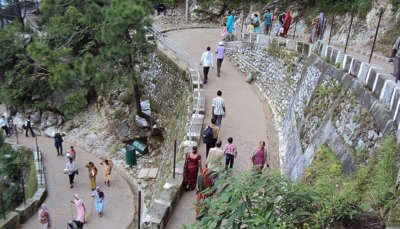
Image Credit: Vinayaraj for Wikimedia Commons
Vaishno Devi’s trip with family must be well planned while choosing trekking as your mode to reach from Katra to Bhawan which is nearly 13 km. There are two routes from Katra to Ardhkuwari, each differing in distance and the same is with Ardhkuwari to Bhawan having two routes. Bhairavnath shrine is a few more kilometers up the Vaishno Devi temple, you can either indulge in a Vaishno Devi hike to the temple, or there are many ponies and palkies available on the route.
Must Read: Trekking Routes in Jammu and Kashmir Updates
2. Helicopter Ride

Image Credit: Varunkau for Wikimedia Commons
All the kids, adults and the elderly, a helicopter ride would add the spark of fun and excitement to the overall experience. The tourists must book the helicopter ride at least 2 months in advance. The helicopter ride takes approximately 8 minutes and can accommodate 5 to 6 passengers at a time. The helipad of Katra located on Udhampur road, is at a distance of 2 km from Katra bus station.
After reaching Sanjhichhat point, it takes almost half an hour to reach Vaishno Devi Bhawan. You can choose ponies, porter, palkis services according to your convenience or prefer to walk to the temple. For a helicopter ride, a one-way fare from Katra to Sanjhichhat will cost around Rs. 1800 for a single person, and for both sides, it will cost Rs. 3600 per person.
3. Ponies and Palanquins
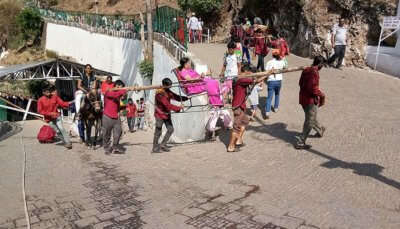
Image Credit: Nckumbhkar for Wikimedia Commons
For some devotees, it might be an arduous task to walk for 12 to 13 km at a stretch to reach Vaishno Devi Bhawan so, many of the pilgrims prefer to avail themselves of different services including ponies and palanquins. The municipal committee manages all the ponies, porters, and palanquins services for the convenience of the travellers. Also make sure you are checking all the options before planning your Vaishno devi trip from Delhi.
Suggested Read: Places Near Jammu
Temples to Visit on a Vaishno Devi Yatra
The following are the prominent temples that you will be visiting on your Vaishno Devi trip with family:
1. Mata Vaishno Devi Temple
Regarded as one of the most important temples and religious sites amongst Hindus, Mata Vaishno Devi Temple is dedicated to Vaishno Devi. The temple is considered to be one of the 108 Shakti Peethas that is dedicated to Durga who is being worshipped as Vaishno Devi. It is the must visit place on your Vaishno Devi family trip.
2. Adh Kumari Temple
Adh Kuwari is considered as a halfway mark to the main Bhawan of Vaishno Devi situated at a distance of 6 km. The term Adh Kuwari means the eternal virgin and is regarded as one of the most essential temples on the way to the holy cave.
Suggested Read: National Parks In Kashmir
3. Bhairon Nath Temple
Situated just 2 km away from Mata Vaishno Devi Temple, Bhairon Nath Temple is dedicated to Baba Bhairavnath. It is believed that Bhairav was killed by the Vaishno Devi goddess as he was about to attack her and then she acquired the form of Kali and beheaded him. However, he repented for his sins and the goddess forgave him and specified that pilgrimage to Vaishno Devi would be incomplete without seeking the blessings of Bhairon Nath.
4. Charan Paduka
Charan Paduka is situated at an altitude of 3380 feet and is about 1.5 km from Banganga. Imprinted on a rock slab, Charan Paduka is a religious site where the imprints of Goddess pious feet are believed to be. The visitors pay their obeisance to the footprints of the Mata which is engraved on a rock slab and then proceed further for the yatra.
Suggested Read: Things To Do In Kashmir In June
3 Best Places to Stay in Katra
The tourists will only discover a property that is available in Katra when they are planning for a visit to Vaishno Devi. However, you can plan your stay at Katra. The below-mentioned hotels are located in Katra which are famous for their best-in-class amenities offering comfortable stay for their guests. Let’s have a glimpse at our curated list of hotels in Katra for those on a Vaishno Devi trip with family.
1. Hotel Rama Trident

Image Credit: davidlee770924 for Pixabay
The property comprises modern architecture and the rejuvenating hotel is just 14 minutes walking distance from Shri Mata Vaishno Devi Katra train station. You can choose to indulge in nearby things to do such as visiting Baba Dhansar Temple which is just 24 minutes away. You can go for a leisure walk in the Shalimar Garden, located 8 minutes away from the hotel. Cooperative staff, spacious rooms, delicious food, and a good location are some of the amenities preferred by the guests.
Star Category: 4-star Starting Price: INR 6,500 per night Location: Railway Rd, near Ambika Chowk, Katra, Jammu and Kashmir 182301
2. AMR Hotel

Image Credit: Peterweideman for Pixabay
The hotel is located close to a shopping mall and is situated nearby Shri Mata Vaishno Devi train station, which is around a 4 minutes walking distance from the property. The AMR hotel offers a safe and hygienic environment for its guests. The rooms are available in different categories such as Superior room, deluxe room and deluxe family room.
Star Category: 3-star Starting Price (For Night): INR 3,ooo Location: Ground Floor, Jammu Road, near main bazaar Vaishno Devi Katra Jammu and Kashmir, 182301
Suggested Read: Lakes In Kashmir
3. Hotel Hari Resort

Image Credit: ManuelaJaeger for Pixabay
Hotel Hari Resort offers various amenities such as free Wifi, full-service laundry and rooms with air conditioning. The hotel is popular for organising special occasion arrangements. There are different categories of rooms available at the resort including double deluxe AC, double deluxe non AC, and super deluxe room. With its close proximity to major points, a stay in this property in your Katra tour plan with the family trip to Vaishno Devi will be a wonderful idea.
Star Category: 3-star Starting Price (For Night): INR 2,500 Location: Dak Bungalow Road, opp. Shalimar Park, Katra, Jammu and Kashmir 182301
How to Reach Vaishno Devi
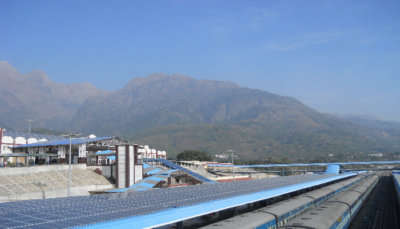
Vaishnodevi trip with the family can be done by road, train, or flight. The Shri Mata Vaishno Devi Katra Railway station is the nearest terminal located at a distance of 20 km from the holy shrine of Vaishno Devi temple. There are frequent buses to Katra from Jammu Tawi, Amritsar, New Delhi, and other major cities of India. One can also reach Katra, which is about 50 km from Jammu, it serves as the base camp for the yatra. Jammu is well connected by flight from all the major cities, another way is to take a train to Jammu. There are many daily and weekly trains that operate from major cities to Jammu and there are few trains that have been extended till Katra. Given the connectivity and options you can easily plan a Vaishno devi trip from Mumbai.
Suggested Read: Places To Visit In Srinagar
Best Time to go on Vaishno Devi Yatra
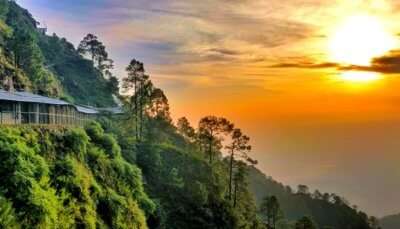
Vaishno Devi remains crowded throughout the year, but it is mostly visited by tourists during the months of March to July as the weather is pleasant and comforting for the devotees. The maximum temperature is 31 degrees Celsius, and the minimum temperature is 17 degrees Celsius making it appropriate for darshan and because of this many travellers prefer scheduling their Vaishno Devi trip plan with family during these months.
It usually rains between August and September, the weather conditions can get a little extreme this time, but despite that many devotees prefer travelling around this time. November to February are the winter months and many travellers do not prefer travelling during these months because weather conditions are harsh and Vaishno Devi trekking distance becomes difficult to cover around this time.
Further Read: Valleys In Kashmir
Now that you know all about Vaishno Devi and everything you need to keep in your mind before planning your trip. Your Vaishno Devi trip with family will be made convenient with our ultimate guide described above. Do plan a trip to Vaishno Devi as it is considered a home to spiritual culture and a sacred site for Hindus. Schedule your vacation in the season of summer when there is a nice ambience amidst the hills.
For our editorial codes of conduct and copyright disclaimer, please click here .
Frequently Asked Questions about Vaishno Devi Trip with Family
How can I plan a Vaishno Devi trip with my family?
You can plan your Vaishno Devi family trip with 3 to 4 days in hand. 3 to 4 days will be enough for a relaxing vacation, you can easily spend 1 night in Katra, 1 night at the Bhawan and return back to Katra.
How much does a Vaishno Devi trip cost?
The cost will largely vary on the basis of the number of days you decide to be on the trip, choice of accommodation, and other facilities such as breakfast, transfers. Having said that, the trip will cost you around Rs.10,950 for single occupancy and Rs. 7,850 for double occupancy, this will include your 1 night stay in Katra and transfers from and to Jammu. The darshan cost is not included in this.
How difficult is the Vaishno Devi trek?
The mother Goddess shrine is located in the Trikuta mountains which are at a height of 5200 feet and 61 km from the city of Jammu. The devotees have to plan a journey of 13 km on foot starting from Katra. The trekk is not that difficult, it is a bit tiring due to the steep slopes at a few patches. However, there are helicopters, ponies, and palanquins available that would help the devotees to reach the shrine.
Which month is good for travel is Vaishno Devi?
The months of April to October are considered ideal for traveling to Vaishno Devi due to the pleasant weather and accessibility of the pilgrimage site during these months.
How much time is sufficient for Vaishno Devi?
Typically, 2 to 3 days are sufficient for a visit to Vaishno Devi, allowing you to complete the pilgrimage, have darshan, and return. However, the duration can vary based on your pace and desire to explore the surroundings.
How far is Patnitop from Katra?
The distance between Patnitop and Katra is approx. 85 km by road, 38 km by flight. The travelling time by road is approx. 1 to 2 hours.
Which month is crowded in Vaishno Devi?
October and November remain the most crowded in Vaishno Devi, where the pilgrims can be seen chanting “Jai Mata Di.”
Is Vaishno Devi hot or cold?
The temperature of Vaishno Devi varies from season to season. It is bearable during summers, gets low in monsoon season, and gets down below zero degrees during the winter months of December and January.
What is the Vaishno Devi walking distance from Katra?
Vaishno Devi is 15 km away from Katra. It can take 4.5-5 hrs to reach if you prefer to walk.
People Also Read:
Temples In Manali Temples In Uttarakhand Temples In Ladakh

Tanishk Juneja
Experience the world through captivating stories of adventure and travel. As a senior content writer, I bring my passion for exploration to life, crafting tales that take you on a journey. With my words, you’ll feel the thrill of discovery and the joy of experiencing new cultures. Let me turn your imagination into a reality with stories that inspire you to explore and embrace the world.
Places to visit in India
- 30 Best Places To Visit In Bangalore In...
- 64 Best Places To Visit In Kerala For...
- 39 Best Places To Visit In October In...
- 101 Places To Visit In India Before You...
- 20 Places To Visit In Sakleshpur In 2024...
- 35 Exotic Places To Visit In December In...
- 32 Best Places To Visit In January In...
- 20 Best Places To Visit In Meghalaya For...
- 12 Places To Visit In Punjab To Witness...
- Unravel Places To Visit In Uttarakhand For A...
- 26 Best Places To Visit In Jammu For...
- 29 Places To Visit In Monsoon In India...
- Best Places To Visit In August In India...
- 36 Beautiful Places To Visit In Kashmir One...
- 55 Fascinating Places To Visit In Hyderabad In...
- 35 Ultimate Places To Visit In July In...
- 72 Places To Visit In Rajasthan In 2024
- 42 Best Places To Visit In Pondicherry In...
- 33 Spectacular Places To Visit In Mumbai On...
- 43 Places To Visit In West Bengal In...
- 41 Best Places To Visit In June In...
- 35 Best Places To Visit In Mysore In...
- 35 Places To Visit In Coorg For A...
- 54 Best Places To Visit In India In...
- 8 Places To Visit In Jibhi For A...
- 64 Best Tourist Places To Visit In Goa...
- 25 Best Places To Visit In Visakhapatnam In...
- 16 Places To Visit In Lucknow That Showcase...
- 60 Best Places To Visit In Kolkata That...
International Places To Visit
- 35 Best Places To Visit In Japan That...
- 40 Best Places To Visit In Canada In...
- 28 Places To Visit In October In World...
- 28 Stunning Places To Visit In South Korea...
- 25 Places To Visit In Manila In 2024...
- 19 Best Places To Visit In Morocco In...
- 34 Best Places To Visit In Austria In...
- 82 Best Places To Visit In Turkey That...
- 10 Breathtaking Places To Visit In The World...
- 22 Best Places To Visit In Netherlands: The...
- 24 Fabulous Places To Visit In Ireland: The...
- 19 Best Places To Visit In London In...
- Discover 24 Places To Visit In Switzerland In...
- 17 Mystical Places To Visit In Egypt In...
- 15 Places To Visit In United Kingdom That’ll...
- 33 Best Places To Visit In Amsterdam On...
- 19 Best Places To Visit In Kuala Lumpur...
- 42 Best Places To Visit In Bangkok In...
- 11 Popular Places To Visit In Doha For...
- 26 Places To Visit In Germany In 2024...
- 32 Places To Visit In Belgium That Make...
- 15 Places To Visit In USA That Reflect...
- 37 Best Places To Visit In Dubai At...
- 15 Top Places To Visit In Asia To...
- 20 Must-See Places To Visit In Milan In...
- Top 27 Places To Visit In Greece In...
- 31 Places To Visit In Abu Dhabi In...
- 25 Places To Visit In August In The...
- 15 Best Places To Visit In Chicago That...
- 14 Places To Visit In Berlin You Must...
Things To Do
- 40 Things To Do In Pondicherry In 2024...
- 12 Best Things To Do In Matheran In...
- 23 Intoxicating Things To Do In Turkey In...
- Top 14 Interesting Things To Do In Kanyakumari...
- 38 Things To Do In Gokarna To Escape...
- 12 Best Things To Do In Varanasi For...
- 21 Remarkable Things To Do In Krabi In...
- 16 Things To Do On Honeymoon In 2024
- 23 Things To Do In Chennai To Explore...
- 20 Things To Do In Ahmedabad For An...
- 30 Best Things To Do In Wayanad For...
- 37 Amazing Things To Do In Kerala For...
- Top 39 Things To Do In Jaipur
- 19 Things To Do In Mussoorie For A...
- 33 Best Things To Do In Kolkata In...
- Top 25 Things To Do In Kodaikanal For...
- 32 Things To Do In Ooty That Will...
- 15 Things To Do In Srinagar That Will...
- 20 Things To Do In Darjeeling
- 27 Kickass Things To Do In Malaysia
- 25 Best Things To Do In Phuket That...
- 18 Awesome Things To Do In Kasol On...
- 27 Exciting Things To Do In Chikmagalur
- 9 Things To Do In Mathura For An...
- 23 Things To Do In Lonavala For A...
- 10 Best Things To Do In Lakshadweep For...
- 30 Joyful Things To Do In Bhutan
- 38 Exhilarating Things To Do In Udaipur In...
- 18 Best Things To Do In Chandigarh
- 29 Amazing Things To Do In Shimla
- 30 Things To Do In Dehradun In 2024
- 7 Incredible Things To Do In Vrindavan For...
Recent Posts

Explore The Legendary Reclining Vishnu Statue Of Budhanilkantha Temple In Kathmandu In 2024

Visit Kyichu Lhakhang To Immerse In Spiritual Oasis In the Heart Of Bhutan In 2024

A Comprehensive Guide To The Best Things To Do In Wanaka And Scenic Spots In 2024
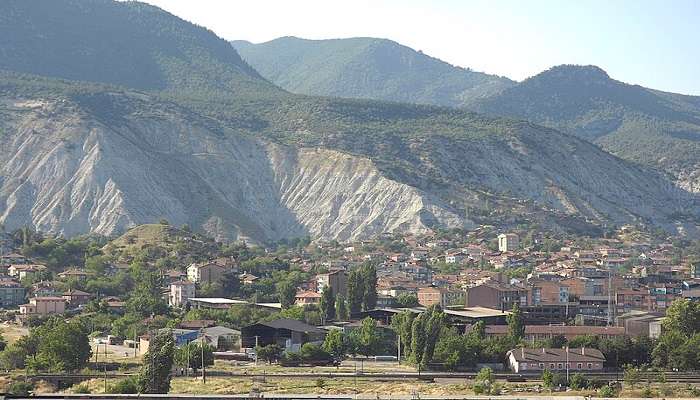
Discover The Beautiful Turkish Gem Of Karabük In 2024

Find Out About Kirşehir A Turkish Land Of Hidden Treasures In 2024
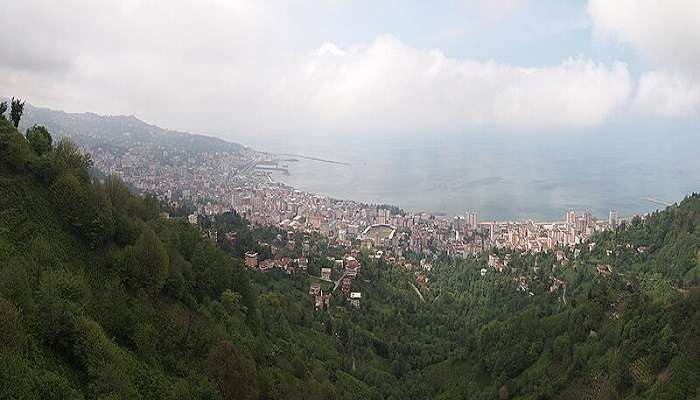
Visit Rize To Discover Vibrant Culture Of Turkey’s Tea Capital In 2024
Trending Blogs

20 Mysterious Places In India To Visit In 2024 More Bizarre Than The Bermuda Triangle

10 Scariest Roads In India That Are A Driver’s Nightmare
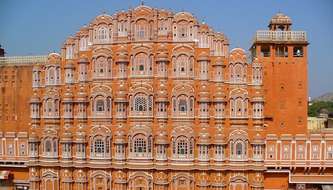
101 Places To Visit In India Before You Turn 30 in 2024

35 Exotic Places To Visit In December In India 2024 To Enjoy A Surreal Vacation

64 Top Honeymoon Destinations In India In 2024

95 Best Honeymoon Destinations In The World In 2023 For A Romantic Escape!
Best Places To Visit In India By Month
Best places to visit outside india by month.
- TravelTriangle
- Travel »
- Tour Packages
- Honeymoon Packages
- Family Packages
- Budget Tour Packages
- Luxury Tour Packages
- Adventure Tour Packages
- Group Tour Packages
- Kerala Tour Packages
- Goa Tour Packages
- Andaman Tour Packages
- Sikkim Tour Packages
- Himachal Tour Packages
- Uttarakhand Tour Packages
- Rajasthan Tour Packages
- Tour Packages From Delhi
- Tour Packages From Mumbai
- Tour Packages From Bangalore
- Tour Packages From Chennai
- Tour Packages From Kolkata
- Tour Packages From Hyderabad
- Tour Packages From Ahmedabad
- Kerala Tourism
- Goa Tourism
- Sikkim Tourism
- Andaman Tourism
- Himachal Tourism
- Uttarakhand Tourism
- Rajasthan Tourism
- Hotels in Kerala
- Hotels in Goa
- Hotels in Sikkim
- Hotels in Andaman
- Hotels in Himachal
- Hotels in Uttarakhand
- Hotels in Rajasthan

- Nature & Wildlife
- Photography
Schengen-Style Gulf Tourist Visa: Explore the Middle East with Ease
A comprehensive guide to traveling in dubai.
The Ultimate Guide to Vaishno Devi Yatra: Tips, Information, and More
Vaishno Devi Yatra is a holy pilgrimage that attracts millions of devotees from all over the world. Nestled in the Trikuta Hills of Jammu and Kashmir, the Vaishno Devi Temple is one of the most revered shrines in India.
With its breathtaking views, serene atmosphere, and rich cultural heritage, the yatra is a journey that every devout Hindu aspires to undertake. But, planning a trip to Vaishno Devi can be a daunting task, especially if you’re a first-time visitor.
In this comprehensive guide, we have put together everything you need to know to make your Vaishno Devi Yatra safe, comfortable, and memorable.
These are the outlines, that we’re covering in our guide: – Ultimate Guide to Vaishno Devi Yatra
I. how to reach katra via train.
- Train schedules and stations from Chandigarh and New Delhi
- Tips for booking train tickets
II. What is an RFID card, how to apply for it, and its validity
- Definition and benefits of RFID card
- Application process and documents required
- Validity and renewal of RFID card
- Locations to apply for RFID card and Google Map links
III. How to reach frisking point from railway station and what is frisking point
- Definition and importance of frisking point
- Directions from the railway station to frisking point
- Google Map location of frisking point
IV. Mobile network availability in Katra and Yatra SIM (Airtel and Jio)
- Availability and coverage of Airtel and Jio networks in Katra
- Tips for getting a Yatra SIM for better network connectivity
V. Budget-friendly accommodations in Katra
- Best places to stay in the price range of 400-800 INR
- Details of Niharika Complex, a popular choice for pilgrims
- Accommodation options near bus stand
VI. Different routes to reach the temple and sites to visit during the trek
- Detailed overview of various routes to the temple
- Highlights of every site and temple visited during the trek
- Estimated cost of food and beverages at each site
- Darshni Dwaar, Baan Ganga, and Bathing Ghat
- Geeta Mandir and Geeta Bhawan
- Charan Paduka, Indraprasta Bhojnaalya, and Hathi Katta
- Ardh Kuaari, Ardh Kuaari Bhojnaalya, and Shradha Bhawan
- Dharmshala, Shailputri Dormitory, and Garbhjoon
- Parchi and Bhaint Shop
- Praacheen Gufa and Bhairav Ghaati
- Parvati Bhawan, Kalika Bhawan Room No. 4, and Mahokaamana Bhawan
VII. Where to get lockers and the cost of the locker
- Locations to rent lockers along the trek
- Cost of locker rental based on size and duration
VIII. Details about maavaishnodevi.org
- Overview of the official website of the Shri Mata Vaishno Devi Shrine Board
- Services and information available for pilgrims on the website
How to apply for the RFID card through the website
Ix. how to get free accommodation and where to find it.
- Details of the free accommodation provided by the Shrine Board
- Application process for free accommodation at the Yatra Registration Counter
- Booking packages through the official website for free accommodation, Yatra Parchi, and helicopter tickets
- Availability and limitations of free accommodation options.
X. Tips for a safe and comfortable trek
- Packing list for the trek
- Weather conditions and best time to visit
- Safety precautions and tips for a smooth journey
Information on medical facilities and emergency services available during the trek
Xi. best places to eat in katra.
- Recommendations for local cuisine and street food
- Estimated cost of meals at various eateries
- Popular food joints and their specialties
XII. How to reach the temple by helicopter
- Details of helicopter services to the temple
- Booking process and availability of tickets
- Advantages and disadvantages of traveling by helicopter
XIII. Places to visit around Katra
- Popular tourist destinations near Katra
- Directions and transportation options to reach these places
- Best time to visit and estimated time required for each destination
XIV. Information on yatra parchi and its importance
- Definition and benefits of yatra parchi
- Application process for yatra parchi
- Locations to obtain yatra parchi and Google Map links
- Importance of carrying yatra parchi during the trek
XV. Other important information for pilgrims
- Prohibited items during the trek
- Information on ponies, pithus, and other modes of transportation available
- Tips for a smooth and enjoyable experience
- Contact details of important authorities and emergency services
Here is the Detailed Information of Vaishno Devi Yatra
Katra is well-connected to major cities in India via the Indian Railways network. The nearest railway station to Katra is the Shri Mata Vaishno Devi Katra railway station, which is located just 1.5 km away from the Katra bus stand. Here are the train schedules and stations from Chandigarh and New Delhi:
From Chandigarh: There are several trains that operate between Chandigarh and Shri Mata Vaishno Devi Katra railway station. Some of the popular ones include the Uttar Sampark Kranti Express, Jammu Tawi Express, and Sarvodaya Express. The travel time is approximately 7-8 hours. The train fare for a one-way journey can range from INR 300 to INR 1200, depending on the class of travel.
From New Delhi: There are several trains that operate between New Delhi and Shri Mata Vaishno Devi Katra railway station. Some of the popular ones include the Shri Shakti Express, Jammu Tawi Express, and Rajdhani Express. The travel time is approximately 10-12 hours. The train fare for a one-way journey can range from INR 400 to INR 2500, depending on the class of travel.
Tips for booking train tickets:
- It is recommended to book train tickets well in advance, especially during peak seasons, to avoid last-minute hassles.
- You can book train tickets online through the official Indian Railways website or through third-party websites such as MakeMyTrip, IRCTC, and Cleartrip.
- Always carry a printout of your ticket or save the e-ticket on your phone to avoid any confusion at the railway station.
- If you are traveling in a group, try to book tickets together to ensure that you are allotted seats together.
An RFID (Radio Frequency Identification) card is a smart card that is issued to pilgrims visiting the Mata Vaishno Devi shrine. It is a prepaid card that can be used for various services such as helicopter booking, battery-operated vehicle (BOV) rides, and priority darshan. Here is some information on the RFID card, including its benefits, application process, validity, and renewal:
Definition and benefits of RFID card for Vaishno Devi Yatra:
- The RFID card is a smart card that is linked to the pilgrim’s personal details and photograph, making it easy to access the services provided at the shrine.
- The card can be used for various services such as helicopter booking, BOV rides, and priority darshan, thus saving time and avoiding long queues.
- The card can be recharged online or at designated recharge points located near the shrine.
Application process and documents required:
- To apply for an RFID card, pilgrims can visit any of the designated registration counters located in Jammu, Katra, and Sanjichhat. The counters are open 24/7.
- The applicant must provide a valid photo ID proof such as Aadhar card, Voter ID card, or Passport.
- The applicant’s photograph will be taken at the registration counter, and the card will be issued immediately.
Validity and renewal of RFID card for Vaishno Devi Yatra:
- The RFID card is valid for one year from the date of issue.
- If the card is not used for a period of six months, it will be deactivated.
- The card can be renewed at any of the designated recharge points located near the shrine.
Locations to apply for RFID card for Vaishno Devi Yatra and Google Map links:
- Shri Mata Vaishno Devi Shrine Board Office, Katra (Google Maps: https://goo.gl/maps/UcX9nHaAz16yBm6R9 )
- Vaishno Devi Shrine Board, Jammu Tawi Railway Station (Google Maps: https://goo.gl/maps/kLZq3X2zLhE8atvKA )
- Ban Ganga Registration Counter, Ban Ganga (Google Maps: https://goo.gl/maps/yT1XkTcWpHtFhPYc8 )
Cost of the RFID card for Vaishno Devi Yatra:
- The RFID card costs INR 200 (approx. USD 3) and is valid for one year. The recharge value can range from INR 500 to INR 10,000 (approx. USD 7 to USD 140).
If you are planning to travel to Mata Vaishno Devi by train, you will arrive at the Shri Mata Vaishno Devi Katra railway station. Once you exit the station, you will need to go through a frisking point, which is a mandatory security checkpoint set up by the local police to ensure the safety of pilgrims.
The frisking point is located just outside the railway station, and you will have to go through a security check before you start your journey. The checkpoint includes metal detectors, baggage scanners, and body pat-downs. It is recommended to carry only the essentials and avoid carrying any prohibited items as it may cause delays at the checkpoint.
To reach the frisking point from the railway station, you can follow the signs and walk for approximately 10 minutes. The route is well-marked, and you will find many shops and vendors selling refreshments and other items along the way. The frisking point is located near the main entrance to the Mata Vaishno Devi Shrine Board complex.
Google Maps Location: https://goo.gl/maps/rFzY48xrHJ7G8dWw5
It is essential to note that frisking points are a mandatory security measure put in place for the safety of pilgrims. It is crucial to cooperate with the security personnel and follow their instructions to make your journey safe and hassle-free.
Katra is a small town in Jammu and Kashmir and has a good mobile network coverage. Major mobile network operators like Airtel and Jio have a strong presence in the region. Both networks provide excellent connectivity for voice and data services throughout the town and on the trek to Mata Vaishno Devi.
If you already have an Airtel or Jio SIM, you can use it in Katra without any issues. However, if you are facing network issues, you can get a Yatra SIM, which is specifically designed for pilgrims visiting the holy shrine.
The Yatra SIM is available for purchase at various locations in Katra, including the railway station, bus stand, and shrine board offices. The SIM costs around INR 200 ($3) and is valid for 7 days. It provides unlimited calls, 2GB data per day, and 100 SMSes per day.
It also comes with a complimentary subscription to the Shri Mata Vaishno Devi Shrine Board’s app, which provides live darshan and other useful information.
If you plan to get a Yatra SIM, make sure to carry a valid ID proof, such as an Aadhaar card or a passport. The application process is straightforward and takes only a few minutes.
Google Maps Location of Katra Railway Station: https://goo.gl/maps/mfM9XzexTkbMnFGD6
Google Maps Location of Katra Bus Stand: https://goo.gl/maps/HhCUzJmk9XvX8dcK8
Google Maps Location of Shrine Board Office: https://goo.gl/maps/izRPLM4P4Zb9CdtY8
It is essential to note that network connectivity may fluctuate during the trek due to the hilly terrain. However, with a Yatra SIM or a reliable mobile network operator like Airtel or Jio, you can stay connected throughout your journey.
If you are on a budget, there are plenty of options for affordable accommodations in Katra. Here are some suggestions for places to stay in the price range of 400-800 INR:
- New Ashoka Guest House: This guest house is located near the bus stand and offers comfortable rooms with basic amenities like a TV and attached bathroom. The prices range from 400-600 INR per night depending on the season.
- Hotel Anurag: This budget hotel is located close to the railway station and offers clean and spacious rooms with attached bathrooms. Prices start at around 500 INR per night.
- Hotel Maa Saraswati: This hotel is located near the main market and offers clean and comfortable rooms with basic amenities. Prices start at around 600 INR per night.
- Hotel Jagdish Residency: This hotel is located near the bus stand and offers clean and spacious rooms with basic amenities. Prices start at around 700 INR per night.
Niharika Complex is another popular choice for pilgrims in Katra. It offers both online and offline booking options for comfortable rooms at reasonable rates. The complex is conveniently located near the bus stand and has a shrine board office within its premises. Prices start at around 600 INR per night.
If you prefer to stay near the bus stand, there are several other budget-friendly accommodations in the area, including Hotel Mahindra Palace, Hotel Sunrise, and Hotel Hari Darshan. Prices for these hotels start at around 400-500 INR per night.
Google Map links:
- New Ashoka Guest House: https://goo.gl/maps/UU5yN8c9XU1MP6Ux8
- Hotel Anurag: https://goo.gl/maps/6MgHYQ8RnMnJ9Xjx7
- Hotel Maa Saraswati: https://goo.gl/maps/tkFTgN6JYvYXWJHc7
- Hotel Jagdish Residency: https://goo.gl/maps/7C21Bav5A5k5Gr5r5
- Niharika Complex: https://goo.gl/maps/fHwjJz7NV3qbiScu5
- Hotel Mahindra Palace: https://goo.gl/maps/BGTJhyzuvGwEhBrt6
- Hotel Sunrise: https://goo.gl/maps/9abJ6kjx3xTPhzKK8
- Hotel Hari Darshan: https://goo.gl/maps/8cYdYXp4gpbawvjD6
Budget Cost:
The budget cost for accommodations in Katra ranges from 400 INR to 800 INR per night, which is roughly 6 USD to 12 USD. However, the prices may vary depending on the season and the location of the hotel.
When embarking on the Vaishno Devi Yatra, pilgrims have the option of taking different routes to reach the temple. Each route offers its own unique sights and experiences, making the journey more meaningful and fulfilling. Below is a detailed overview of various routes to the temple and the highlights of every site and temple visited during the trek.
1. Traditional Route:
This is the most popular route among pilgrims, which starts from Katra and ends at the Vaishno Devi Temple. It is a 12-kilometer trek that takes about 5-6 hours to complete. Along the way, pilgrims pass through several important sites, including:
- Darshni Dwaar: This is the starting point of the trek where pilgrims have to register themselves and get a yatra parchi, a mandatory document required for the trek.
- Baan Ganga: This is the first site where pilgrims take a dip in the holy Baan Ganga river to purify themselves before starting the trek.
- Charan Paduka: This site is named after the footprints of Mata Vaishno Devi, which are believed to have been imprinted here. It is a steep climb, but the view from the top is worth the effort.
- Adhkuwari: This is the halfway point of the trek and home to the holy cave of Adhkuwari. The cave is believed to be the place where Mata Vaishno Devi meditated for nine months before finally reaching the holy shrine.
- Sanjichhat: This is the last point before the temple, from where pilgrims can get a panoramic view of the surrounding mountains.
- Bhairon Mandir: This is a small temple located at the top of the hill near the Vaishno Devi Temple. Pilgrims who complete the trek visit this temple as well.
2. Himkoti Route
This route is less crowded and starts from the Himkoti bus stand, which is 2 kilometers from Katra. It is a 14-kilometer trek that takes about 6-7 hours to complete. Along the way, pilgrims pass through several important sites, including:
- Himkoti: This is the starting point of the trek and also a famous picnic spot among tourists.
- Sanjhichhat: This is the same site as in the Traditional Route, which offers a panoramic view of the surrounding mountains.
- Bhairon Mandir: This is the same site as in the Traditional Route.
3. Baanganga Route
This route starts from the Baanganga check post, which is 2 kilometers from Katra. It is a 13-kilometer trek that takes about 6-7 hours to complete. Along the way, pilgrims pass through several important sites, including:
- Baanganga: This is the starting point of the trek and also a famous spot for taking a dip in the holy river.
- Devi ki Bhawan: This is the same site as the Vaishno Devi Temple, where pilgrims can offer their prayers and seek blessings.
4. Helicopter Route
This is the most convenient route for those who cannot undertake the strenuous trek. Helicopter services are available from Katra to Sanjhichhat, from where pilgrims can either walk or take a pony ride to the temple. The helicopter ride takes about 8 minutes, and the pony ride takes about 1-2 hours.
Estimated cost of Food and Beverages
In terms of estimated cost of food and beverages, there are several shops and restaurants along the way that offer food and drinks at reasonable prices. The cost of a meal can range from INR 100 to INR 500 ($1.36 to $6.80) depending on the type of food and the location. It is recommended to carry some snacks and water bottles with you during the trek, as some sites may not have food options or may have limited availability.
Important sites that we visit during our Journey
The trek follows a specific route, and the sites are visited in a chronological order. The first site is Darshni Dwaar, which marks the entrance to the holy town of Katra. It is customary for pilgrims to offer their prayers here before starting the trek. Baan Ganga is the next site, which is a small river where pilgrims can take a bath and wash their feet before continuing the journey.
Geeta Mandir and Geeta Bhawan are two sites that offer accommodation to pilgrims, and many choose to stay here for the night. Charan Paduka is a rock formation that is believed to have the footprints of Lord Vishnu. Indraprasta Bhojnaalya and Hathi Katta are sites where pilgrims can take a break and have a meal.
Ardh Kuaari is a site that is located halfway through the trek, and it is where pilgrims are said to attain half the blessings of the entire journey. Ardh Kuaari Bhojnaalya and Shradha Bhawan are other sites where pilgrims can have a meal and rest before continuing the journey.
Dharmshala, Shailputri Dormitory, and Garbhjoon are sites that offer accommodation to pilgrims. Parchi and Bhaint Shop are two important sites where pilgrims can collect their yatra parchi and offer their prayers. Praacheen Gufa and Bhairav Ghaati are sites that hold religious significance and are visited by pilgrims. Parvati Bhawan, Kalika Bhawan Room No. 4, and Mahokaamana Bhawan are sites that offer accommodation to pilgrims and mark the end of the trek.
A Comprehensive Itinerary for Celebrating Holi in Mathura and Vrindavan
Lockers are a convenient option for pilgrims to store their belongings during the trek to the Vaishno Devi Temple. Here are some details about locker rental options in Katra:
- Shri Mata Vaishno Devi Shrine Board Cloak Room: This is the most popular option for locker rental, located at the start of the trek in Katra. The cloak room is open 24 hours a day and offers various sizes of lockers to choose from. The cost of the locker rental depends on the size and duration. For example, a small locker for 24 hours costs around 40 INR (less than 1 USD), while a large locker for 24 hours costs around 100 INR (about 1.5 USD). The locker rental rates increase for longer durations.
- Private Locker Rental Shops: There are several private locker rental shops located near the start of the trek in Katra. The cost of the locker rental depends on the size and duration, and rates may vary based on the shop. Typically, the rental cost for a small locker for 24 hours is around 30-40 INR (less than 1 USD), while a large locker for 24 hours costs around 80-100 INR (about 1.5 USD).
- Cloak Room at the Bhawan: There is a cloak room at the Bhawan near the temple where pilgrims can store their belongings during the visit to the temple. The cost of the locker rental depends on the size and duration, with rates starting at around 30 INR (less than 1 USD) for a small locker.
It is recommended that pilgrims take only essential items with them during the trek and leave other belongings in the locker. It is also advisable to keep important documents, cash, and valuables with you at all times.
Shri Mata Vaishno Devi Shrine Board is the official governing body that manages and maintains the Vaishno Devi temple in Katra, Jammu and Kashmir. The Board has an official website, maavaishnodevi.org , which provides a plethora of information and services to the pilgrims visiting the shrine.
Overview of maavaishnodevi.org
The website is designed to provide an easy and convenient way for pilgrims to access important information about the temple and the surrounding areas. The website has a user-friendly interface and is available in multiple languages, including English, Hindi, and Punjabi.
Services and information available for pilgrims
The maavaishnodevi.org website provides a range of services and information for the convenience of the pilgrims. Some of the key features of the website include:
- Online registration for the Yatra Parchi (entry ticket) and helicopter services.
- Information about the various routes to reach the temple, including the distance, time, and level of difficulty.
- Live darshan of the temple.
- Information about accommodation options, including the Board’s own guest houses and other private hotels.
- Details about the various facilities available at the shrine, such as cloakrooms, lockers, and medical facilities.
- Information about the history and significance of the Vaishno Devi temple and the surrounding areas.
The website provides a convenient way for pilgrims to apply for the RFID card, which is mandatory for all visitors to the temple. To apply for the RFID card through the website, follow these steps:
- Visit maavaishnodevi.org and click on the ‘RFID Registration’ tab.
- Fill in the required details, such as name, address, and contact information.
- Upload a scanned copy of your photo ID and a passport-sized photograph.
- Pay the requisite fee online.
- Once the application is processed, the RFID card will be sent to your registered address.
Note that the application process for the RFID card can also be completed offline at various locations in Katra, as mentioned in a previous answer.
Overall, maavaishnodevi.org is a comprehensive and informative website that can help pilgrims plan their visit to the Vaishno Devi temple in a hassle-free manner.
If you’re a pilgrim visiting the Vaishno Devi Temple, you can avail free accommodation provided by the Shri Mata Vaishno Devi Shrine Board. Here are some details on how to get free accommodation and where to find it:
- Sarai: The board provides Sarais, or dormitories, which are basic accommodation options with beds, blankets, and basic amenities.
- Dharamshala: Dharamshalas are more comfortable options with private rooms and attached bathrooms.
- Panchayat Bhawan: The Panchayat Bhawan is a newly constructed building offering comfortable accommodation to pilgrims.
- Niharika Complex: The Niharika Complex provides air-conditioned rooms with attached bathrooms, a restaurant, and a shopping complex.
- Application Process for Free Accommodation at the Yatra Registration Counter: Pilgrims can apply for free accommodation at the Yatra Registration Counter, located near the bus stand in Katra. You’ll need to show your Yatra Parchi and a valid photo ID proof to apply for free accommodation.
- Booking Packages Through the Official Website for Free Accommodation, Yatra Parchi, and Helicopter Tickets: You can also book free accommodation packages through the official website of the Shri Mata Vaishno Devi Shrine Board. You can select the package that suits your needs and book it online. You can also book Yatra Parchi and Helicopter tickets through the website.
- Availability and Limitations of Free Accommodation Options: Free accommodation is subject to availability, and the Shrine Board doesn’t guarantee availability during peak season. Additionally, free accommodation is only available for a limited number of days, depending on the package you select.
It’s essential to note that while the accommodation is free, there may be additional charges for food, bedding, and other services. Additionally, free accommodation is available on a first-come-first-serve basis, so it’s best to book in advance to avoid disappointment.
Packing list for the trek:
- Comfortable and sturdy shoes
- Warm clothes, as the temperature can drop at night
- Raincoat or umbrella in case of rain
- Sunscreen, sunglasses, and a hat to protect from the sun
- Water bottle to stay hydrated
- Energy bars or snacks for the journey
- Torch or flashlight, as the trek is mostly at night
- Medicines and a first aid kit
Weather conditions and best time to visit Vaishno Devi Temple
The best time to visit Vaishno Devi is between the months of March and November when the weather is pleasant. During the winter months, the trek can be difficult due to heavy snowfall, so it is not advisable to trek during this time. The temperature during the summer months can go up to 40 degrees Celsius, so it is important to stay hydrated and protected from the sun.
Safety precautions and tips for a smooth journey:
- Stay hydrated and carry enough water to drink during the journey
- Wear comfortable shoes and clothing suitable for trekking
- Follow the marked paths and avoid shortcuts or unknown routes
- Do not trek alone, and always trek in a group
- Keep your belongings close to you and do not leave them unattended
- Do not litter and maintain cleanliness
- Be cautious of animals and snakes that may be present on the trek
- Do not consume alcohol or drugs during the journey
- In case of any medical emergencies, seek help immediately
There are several medical facilities available along the trek, including medical aid camps and emergency response teams. The Shrine Board also provides helicopter rescue services in case of any emergencies. It is important to carry any necessary medications and a first aid kit with you during the journey.
If you are looking for some delicious food options in Katra, here are some recommendations for local cuisine and street food:
- Kudrat Kart: This is a popular street food joint in Katra, known for serving delicious Chole Bhature, Samosas, and Kulfi. The prices are very reasonable, with a plate of Chole Bhature costing around 60-70 INR ($1-2 USD).
- Madhuban Vaishno Dhaba: This restaurant is known for its vegetarian Punjabi food, including Sarson ka Saag, Makki ki Roti, and Rajma Chawal. The prices are reasonable, with a full meal for two costing around 500-600 INR ($7-8 USD).
- The Vaishno Bhojanalaya: This is a popular restaurant located near the Katra bus stand, serving delicious vegetarian thalis with unlimited servings. The prices are very reasonable, with a full meal costing around 100-150 INR ($1-2 USD).
- Krishna Fast Food: This restaurant serves a variety of snacks and fast food items such as burgers, sandwiches, and pizzas. The prices are reasonable, with a meal for two costing around 300-400 INR ($4-5 USD).
- Falak Revolving Restaurant: This restaurant offers a unique dining experience, with a revolving platform that offers a panoramic view of the surrounding mountains. The menu includes a variety of Indian and continental dishes, and the prices are on the higher side, with a meal for two costing around 1500-2000 INR ($20-30 USD).
These are just a few of the many great food options available in Katra. Depending on your preferences and budget, you can also explore other restaurants and street food joints in the area.
To reach the temple by helicopter, pilgrims can book tickets through the official website of the Shri Mata Vaishno Devi Shrine Board or at the Katra helipad. The helicopter service is provided by several private operators and can be a convenient option for those who want to avoid the strenuous trek.
The helicopter journey starts from the Katra helipad and takes around 8 minutes to reach the Sanjichhat helipad, which is located around 2.5 km from the temple. From the Sanjichhat helipad, pilgrims can either walk or take a pony ride to reach the temple. The pony ride is available at the helipad and can be booked on the spot.
The cost of helicopter tickets varies depending on the time of the year and the availability of seats. On average, the cost of a one-way ticket is around INR 1,800 to INR 2,500 (approximately USD 25 to USD 35) per person. The return ticket costs around INR 3,600 to INR 5,000 (approximately USD 50 to USD 70) per person. The helicopter service is available from 8:00 am to 5:00 pm, and it is advisable to book tickets in advance to avoid any last-minute hassles.
One advantage of traveling by helicopter is that it saves time and energy, especially for elderly or physically challenged pilgrims. However, the availability of tickets can be unpredictable, and the service may be affected by weather conditions or other factors. Moreover, the cost of helicopter tickets is higher compared to other modes of transportation, such as buses or taxis.
Overall, traveling by helicopter can be a comfortable and convenient option for those who can afford it and want to avoid the trek. However, it is important to book tickets in advance and be prepared for any unforeseen circumstances that may affect the helicopter service.
Katra is located in the northern state of Jammu and Kashmir in India and is surrounded by several beautiful tourist destinations that are worth exploring. Here are some popular places to visit around Katra:
Patnitop is a hill station located about 80 km from Katra and is a popular destination for tourists looking to escape the heat of the plains. The town offers stunning views of the Himalayas and is known for its trekking trails, adventure sports, and ancient temples.
Google Maps: https://goo.gl/maps/2FwjLgLjKfyVZb9X9
Estimated budget: INR 2,500-3,500 per day (USD 35-50)
Shivkhori is a famous shrine located about 70 km from Katra and is dedicated to Lord Shiva. The shrine is known for its beautiful natural caves and is considered one of the most sacred places for Hindus.
Google Maps: https://goo.gl/maps/7RtvwnnzR43QPKJZ9
Estimated budget: INR 1,500-2,500 per day (USD 20-35)
Sanasar is a beautiful hill station located about 120 km from Katra and is known for its lush green meadows, scenic beauty, and adventure sports.
Google Maps: https://goo.gl/maps/v5f5UMckNVQ8w1yG8
Estimated budget: INR 3,000-4,000 per day (USD 40-55)
Jammu is the winter capital of Jammu and Kashmir and is located about 45 km from Katra. The city is famous for its temples, forts, and palaces and is a popular destination for history buffs.
Google Maps: https://goo.gl/maps/eNxB4v4fW4zWW2Qf9
Kud is a small town located about 15 km from Patnitop and is known for its apple orchards, scenic beauty, and adventure sports.
Google Maps: https://goo.gl/maps/TvP5S5z8xE5aLw7P6
The best time to visit these places is from March to June and September to December. The time required to visit each destination depends on the individual’s itinerary and travel preferences. The estimated budget for each destination may vary depending on the type of accommodation and mode of transportation chosen.
Yatra Parchi is an important document that every pilgrim must carry during their trek to the Vaishno Devi temple. It serves as a registration slip and contains the details of the pilgrim, including their name, address, age, and gender. The Shrine Board issues Yatra Parchi free of cost to manage the flow of pilgrims and ensure their safety during the trek.
Application Process
Pilgrims can apply for Yatra Parchi in several ways. They can either apply online through the official website of the Shri Mata Vaishno Devi Shrine Board or obtain it in person from the Yatra Registration Counter at the Katra Bus Stand.
Locations to Obtain Yatra Parchi
Apart from the Yatra Registration Counter, pilgrims can also get Yatra Parchi from several other locations along the trek, including Banganga, Adkuwari, and Sanjichhat. The exact locations can be found on Google Maps by searching for “Yatra Parchi Counters” in Katra.
Importance of Carrying Yatra Parchi
Yatra Parchi is an essential document that pilgrims must carry with them throughout the trek. It serves as a means of identification and helps the Shrine Board authorities in managing the crowd. Pilgrims without Yatra Parchi may be denied entry to the temple, and hence it is crucial to obtain it before starting the journey.
Budget Cost
Yatra Parchi is issued free of cost to pilgrims.
1. Prohibited items during the trek:
To ensure the safety and sanctity of the pilgrimage, certain items are prohibited on the trek. These include:
- Non-vegetarian food
- Tobacco products
- Firearms and explosives
- Narcotics and drugs
- Plastic bags
2. Information on ponies, pithus, and other modes of transportation available:
Ponies, pithus, and palanquins are available for hire along the trek to the temple. However, it is important to note that the use of animals for transportation is discouraged due to the environmental impact and animal welfare concerns. Additionally, some areas of the trek may not be accessible by these modes of transportation.
3. Tips for a smooth and enjoyable experience:
- Wear comfortable and sturdy footwear.
- Dress appropriately for the weather conditions and avoid carrying heavy or unnecessary items.
- Stay hydrated and carry sufficient water with you.
- Take breaks and rest when required to avoid exhaustion.
- Follow the designated trekking paths and avoid shortcuts or alternate routes.
- Respect the sanctity of the pilgrimage and avoid any activities that may cause harm or inconvenience to fellow pilgrims.
4. Contact details of important authorities and emergency services:
In case of any emergency or assistance required during the pilgrimage, the following authorities can be contacted:
- Shri Mata Vaishno Devi Shrine Board: +91-1991-232367, 232238, 234053
- Police Control Room, Katra: 100
- District Hospital, Reasi: +91-1991-245048
- Disaster Management Control Room, Reasi: +91-94191-98060, 01991-244555
Conclusion – Vaishno Devi Yatra
Vaishno Devi Yatra is a journey that holds immense significance for millions of Hindus around the world. It is a spiritual experience that leaves an indelible mark on one’s mind and soul. With proper planning and preparation, you can make your yatra a truly memorable one. We hope that this guide has provided you with all the information you need to plan your trip and make the most of your time at the holy shrine of Vaishno Devi. May Maa Vaishno Devi bless you with health, happiness, and prosperity.
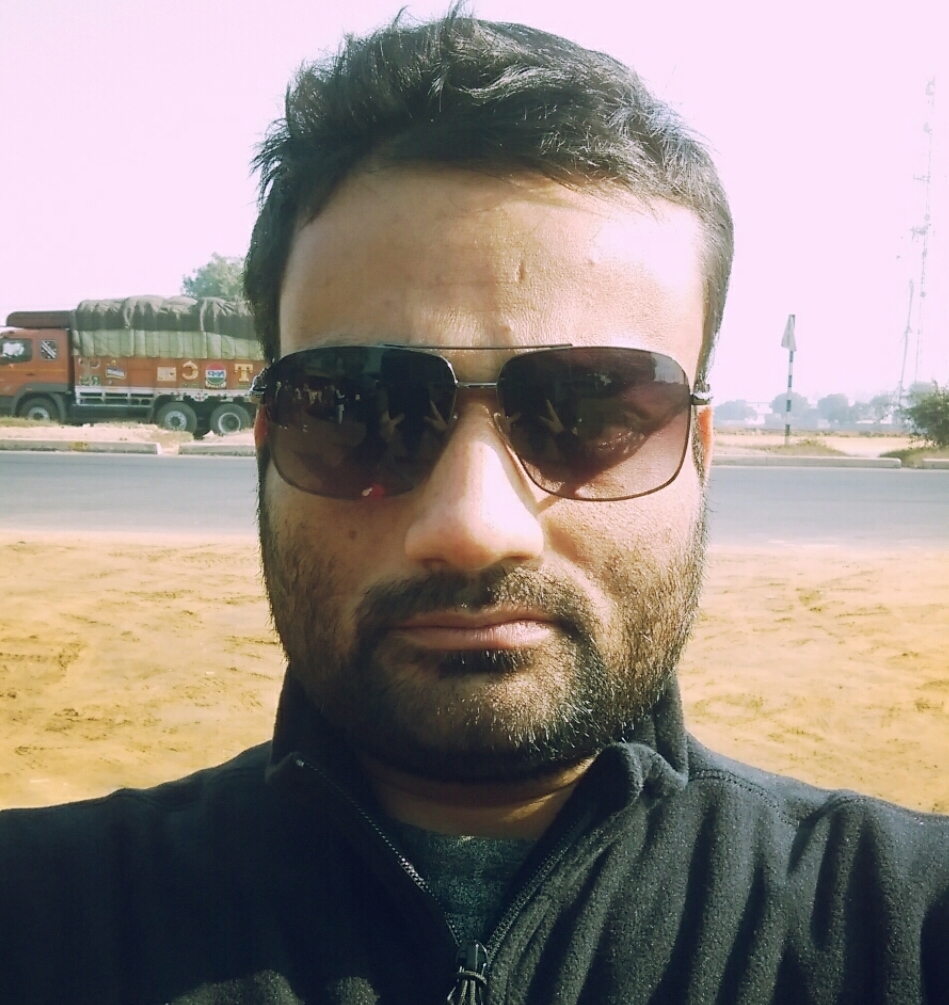
Related Stories
South west sri lanka in 8 days: the ultimate travel itinerary from new delhi, four countries in one trip to improve your travel history, visa-free countries for indians: a comprehensive guide, south west sri lanka in 8 days: the ultimate..., four countries in one trip to improve your travel..., schengen-style gulf tourist visa: explore the middle east with..., srikhand mahadev: a trekker’s spiritual odyssey, popular categories.
- Myth-Truth 19
- हिंदी में 7
- Photography 7
LEAVE A REPLY Cancel reply
Save my name, email, and website in this browser for the next time I comment.
Pardeep Patel
Traveler, Explorer, Storyteller. Join me on my journey around the world.
Quick Access
Enjoying my content.
Make this choice and from now on, you will forever be a part of every adventure!

Home » Travel » Spiritual Tourism: A Guide To Visiting The Vaishno Devi Temple in Jammu and Kashmir
Spiritual Tourism: A Guide To Visiting The Vaishno Devi Temple in Jammu and Kashmir
- Editor's Desk
- September 4, 2024
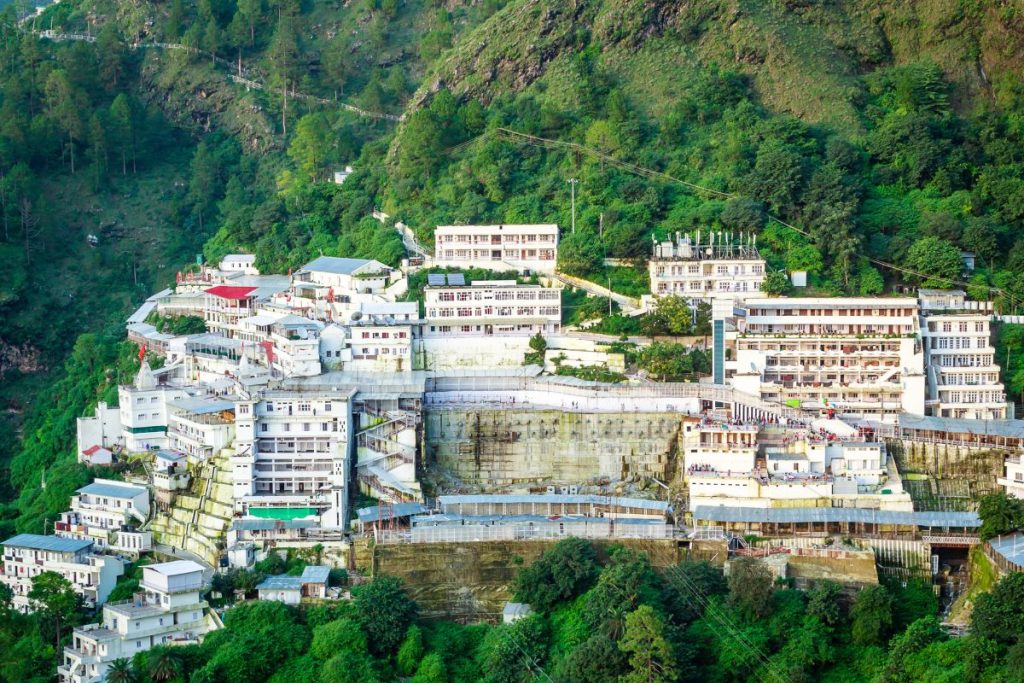
Embark on a divine journey with our complete travel guide to the Vaishno Devi Yatra, offering essential tips, spiritual insights, and practical advice to prepare you for a holy pilgrimage.
The Vaishno Devi Yatra, is not just a pilgrimage but a soulful journey towards divine enlightenment. Embarking on this path is not merely a test of physical endurance but also a spiritual exploration, where each step resonates with age-old tales of devotion and the echoing chants of the Goddess’s blessings. It’s a transformative experience, transcending mere religious boundaries, and instilling in the traveler a profound sense of inner peace and divine connection.
Legends and History
Located in the scenic Trikuta mountains, the Vaishno Devi Temple stands 61 km from Jammu and is a beacon for thousands of devotees annually. Recognized as one of the holiest Hindu pilgrimage sites in north India, the temple, elevated at 5,200 ft, worships Goddess Shakti as: Maha Kali, Maha Saraswati, and Maha Lakshmi . The cave temple’s sanctum boasts three ‘pindis’ or stone symbols of these deities, each with distinct colors and textures originating from the same rock source.
Mythology attributes the temple’s creation to the Pandavas from Mahabharata, with Arjun meditating here, seeking divine intervention before the epic Kurukshetra war. Another tale recounts that over 700 years ago, Vaishno Devi, a devotee of Lord Vishnu, had decided to never get married but was pursued by another god named Bhairon Nath. During the chase, a spring emerged from an arrow she released to quench her thirst. This place, now known as Charan Paduka, has her foot imprints. After residing in the Ardhkanwari cave for nine months, when confronted by Bhairon Nath, she took on the avatar of Maha Kali form and beheaded him. The temple marks the place where his head landed. Another tale narrates Vaishno Devi’s early life as Trikuta, who, upon meeting Lord Rama, acknowledged him as her chosen husband. While he couldn’t reciprocate owing to his commitment to Sita, he was moved by her fervor, dubbing her Vaishnavi and foretelling their union in Kaliyuga. He then adviced her to meditate within a cave in the Trikuta mountains, bestowing upon her a bow and arrow, a lion, and a battalion of monkeys for her defense.
Must Read: Quintessential Srinagar And the Kashmir Valley | Travel and Food Guide
The Vaishno Devi Yatra
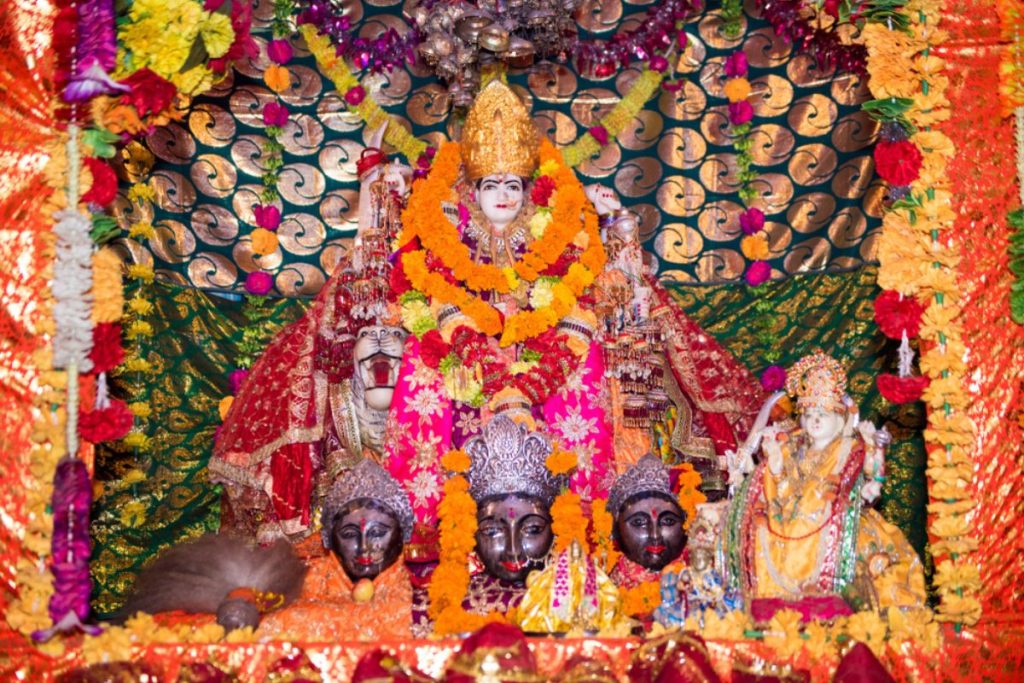
The Vaishno Devi pilgrimage requires a 12 km trek starting from the base camp in Katra , situated roughly 50 kms from Jammu . Even with the challenging trek, the shrine attracts over one crore devotees annually, especially during the Navratras. The pathway to Vaishno Devi is well-constructed with a mild incline, and the journey’s duration depends on weather conditions, crowd size, and one’s pace. Along the route, shops offer souvenirs and spiritual music, accompanied by scenic vistas. While there’s an option of stairs, which are shorter but steeper, notable landmarks on the path include Darshani Deodhi, Banganga, Chara Paduka , and up to Bhairon Mandir . The halfway mark is Adhkuari, leading to Sanji Chhat , a picturesque plateau with a helipad and rest area. The shrine is just a 2.5 km walk from here. Another less-trodden path, which doesn’t accommodate ponies, diverges from the main one just before reaching Adhkuari. Upon arriving at the shrine, one might wait, especially during peak seasons. Entrance into the inner sanctum is determined by the registration slip. The cave houses three natural rock formations, or pindies, submerged in water, now made accessible by a marble platform. The primary complex, known as the Bhawan , provides both free and rented accommodations, vegetarian eateries, a medical facility, and shops for religious offerings and keepsakes.
How to Reach
Katra, a quaint town, is the starting point for the Vaishno Devi pilgrimage and sits 50 kms from Jammu, which houses the closest airport and railway station. From Jammu, buses are an option at Rs 50 from both the railway station and the main bus terminal, while taxis are priced around Rs 1500.
The journey from Katra to Vaishno Devi spans 12 km along a well-constructed path. For those pressed for time or unable to trek, helicopter services from Katra to Sanjhhi Chhat are available, leaving just a 2.5 km walk to the shrine. Reservations for these flights can be made on the Mata Vaishno Devi Shrine Board’s official website. Additionally, ponies, porters, and palanquins can be hired for assistance.
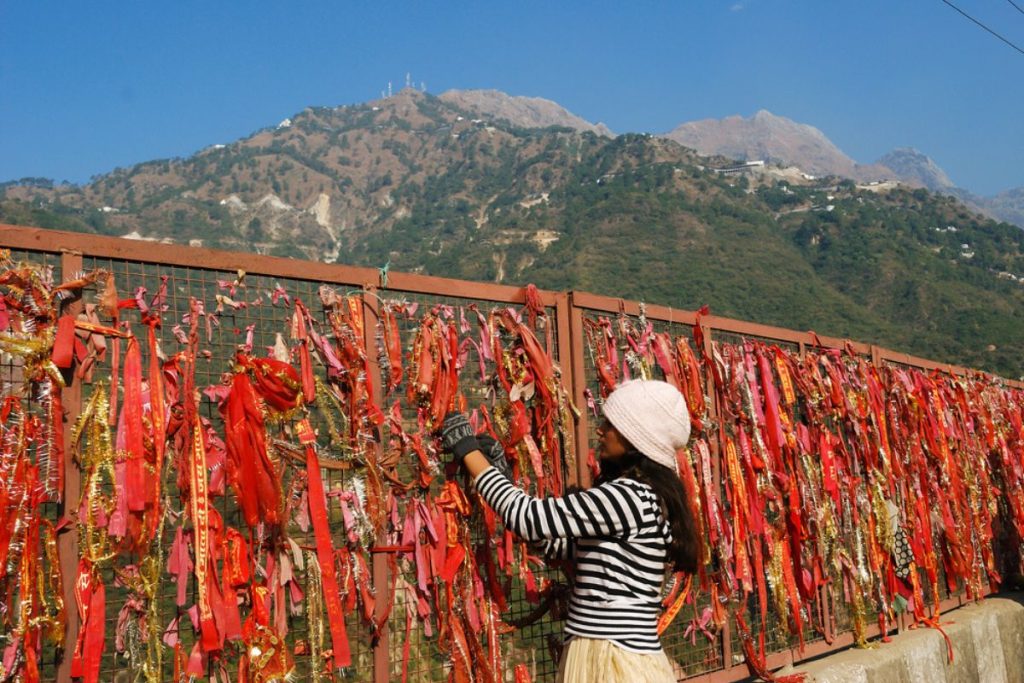
Best Time To Visit:
The ideal time for the trek is during the summer months of May-June, New Year, and the Navratra periods in March-April and September-October. Monsoons, from late July to early September, are best avoided due to slippery paths, while December and January are chilly, making a dawn start optimal.
Before embarking, pilgrims must register at Katra’s Yatra Registration Centres or on the Mata Vaishno Devi Shrine Board’s official website. The trek commences at the Banganga check post at the base; beyond this point, video cameras and electronics are prohibited. It’s recommended to trek lightly as essentials like food and water are available en route. Daily pilgrim numbers are usually capped but during peak seasons, when this is surpassed, waiting slips are distributed. For a seamless experience, online registration and wait-status checks are advised.
The Vaishno Devi Yatra isn’t just a trek but a spiritual journey that strengthens one’s faith and offers a sense of inner peace. It’s a testament to human perseverance and the undying faith of millions in the divine. Whether you’re drawn by faith, tradition, or simply the lure of trekking in a scenic landscape, the Yatra offers an enriching experience.
For latest travel news and updates, food and drink journeys, restaurant features, and more, like us on Facebook or follow us on Instagram . Read more on Travel and Food Network
Trending on TFN
A Spanish Odyssey: Trafalgar’s Unparalleled Best of Spain Itinerary
Imperial Splendors: Trafalgar’s 10-Day Sojourn in Prague, Vienna, and Budapest
You May Also Like
Latest stories.
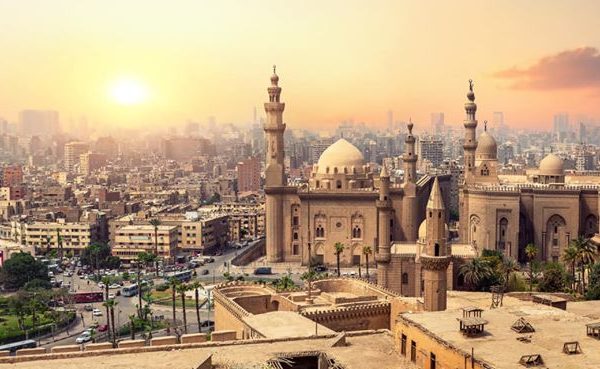
Finding Vegetarian Food in Egypt
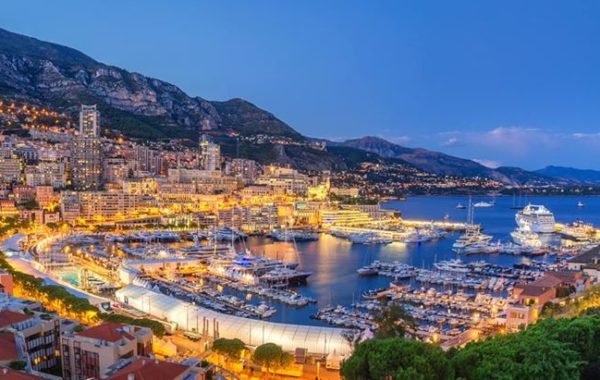
A Day in the Life of a Vegetarian in France
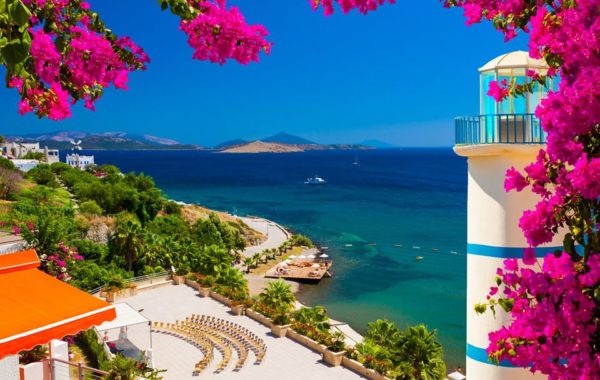
Waking Up to Vegetarian Food in Turkey

5 Restaurants In Macao That Guarantee A Gastronomic Experience
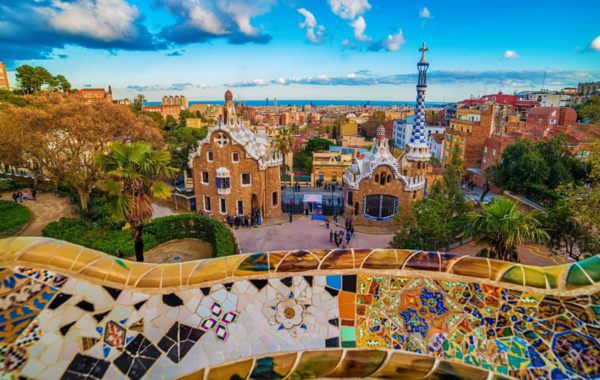
72 Hours in Barcelona | Travel And Food Guide
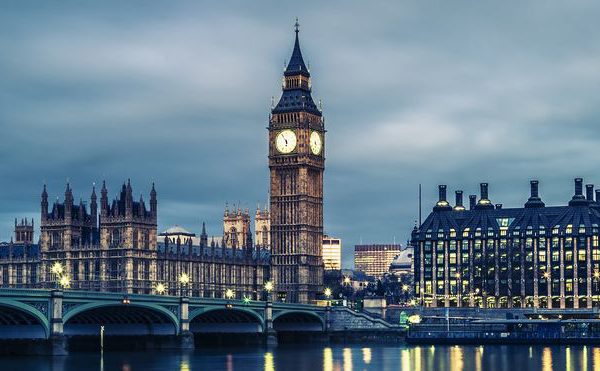
An Insider’s Food Guide To London

Long Weekend Calender
Six toughest treks that pilgrims undertake
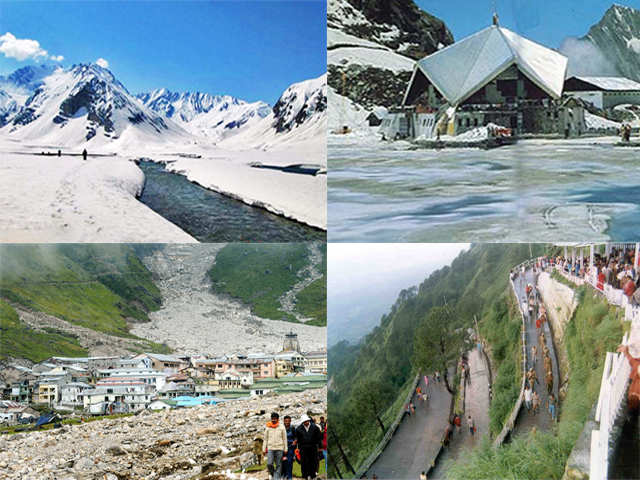
<b>Text: TNN</b><br><br>As the first batch of devotees crossed Nathula on way to Manasarovar on June 22, <i>we look at some of the toughest treks that pilgrims undertake:</i>

Amarnath Yatra
Situated at an altitude of 12,756ft, Amarnath cave is a Hindu shrine located in Jammmu and Kashmir.<br><br> The 45-km distance is covered in four days. The unpredictable weather conditions at times lead to landslides along the route and pilgrims suffer from shortage of oxygen.<br><br><i>In pic: A view of the path leading to the holy cave of Shri Amarnath Cave in Baltal area of Sonmarg.</i>
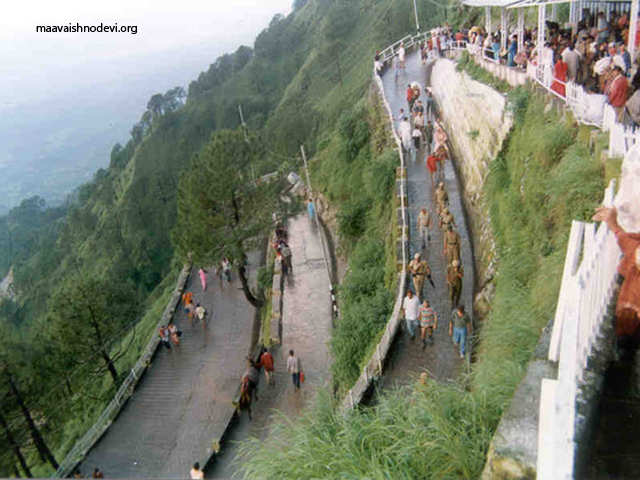
Vaishno Devi
The Vaishno Devi shrine in Trikuta mountains at 5,200ft is 61 km from Jammu city and can be reached after a 13 km arduous journey on foot from Katra. <br><br>Devotees sometimes suffer breathing problems and can avail of ponies and palanquins to reach the shrine via Ardh Kumari.
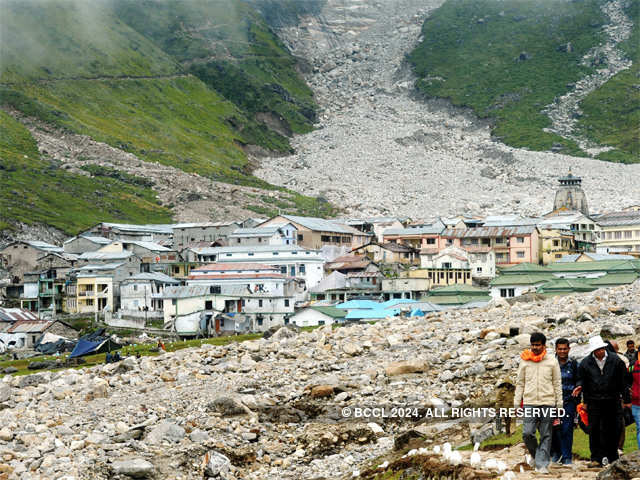
Located in Uttarakhand, the temple is situated at an altitude of 11,750ft above sea level in the Himalayan mountains. The 14km trek from Gaurikund passes along ravines and nallas.<br><br><i>Srikhand Mahadev:</i><br><br>Srikhand Mahadev yatra to reach the 70-ft-high rock Shivalinga situated at 16,900ft above sea level in Kullu, Himachal, is one of the toughest pilgrimage to undertake.<br><br> The 35km pilgrimage, one of the toughest, ascends through alpine meadows beyond snow line and takes 10 days to complete.<br><br> The yatra begins at Jaon village, 170 km from Shimla and 200 km from Kullu by road. A short trek leads to the base camp at Singhad, the last habitation. From there, the journey on foot requires stops for rest and acclimatization.
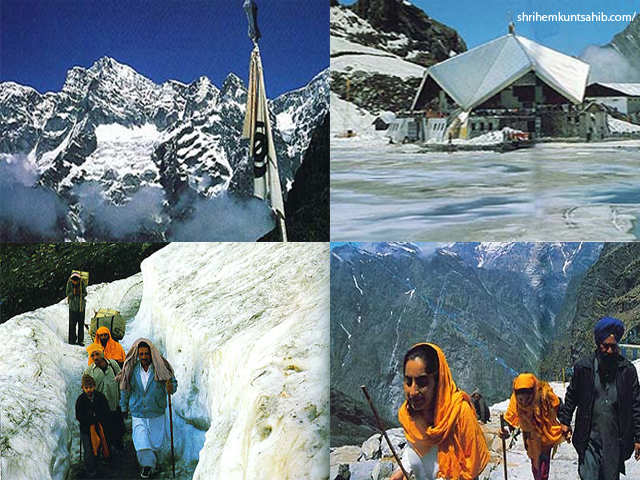
Hemkunt Sahib
Devoted to Guru Gobind Singh, the tenth Sikh Guru, Hemkunt Sahib in Chamoli, Uttarakhand, is situated 15,197ft above sea level. To reach the site, pilgrims have to trek 13km from Govindghat, near Joshimath, to the village of Ghangaria and then another 6 km to arrive at the Hemkunt Sahib Gurudwara.<br><br> Hemkunt is inaccessible from October through April because of snow bound paths and glaciers. The high-altitude setting of the site and the 19km trek make it one of the most challenging yatras in India.<br><br><i>Image: http://shrihemkuntsahib.com/</i>

Nanda Devi Raj Jat Yatra
The yatra to mountain Nanda Devi in Chamoli, Uttrakhand, is undertaken after every 12 years and goes through a long route that takes about three weeks to complete. Devotees have to travel around 280 km by foot. <br><br>The expedition starts from Nauti village in Karanprayag and passes through various rituals, village and temples.<br><br><i>In pic: Students walking towards Mt Nanda Devi East Base Camp</i>
To post this comment you must
Log In/Connect with:
Fill in your details:
Will be displayed
Will not be displayed
Share this Comment:
Discover India by road

- Upcoming Trips
- SUBSCRIBE US SUBSCRIBE US
Vaishno Devi Yatra Guide
About vaishno devi.
Vaishno Devi is also known as Mata Rani, Trikuta, and Vaishnavi. According to legends Vaishnavi was formed from the combined energies of Maha Kali, Maha Lakshmi, and Maha Saraswati.
Vaishno Devi Katra, is one of the most-visited holy places in India. Every year millions of devotees visit here.
The temple is located at an altitude of 5,200 feet on Trikuta Hill. From Katra, the main temple is located at a distance of approx 13 km.
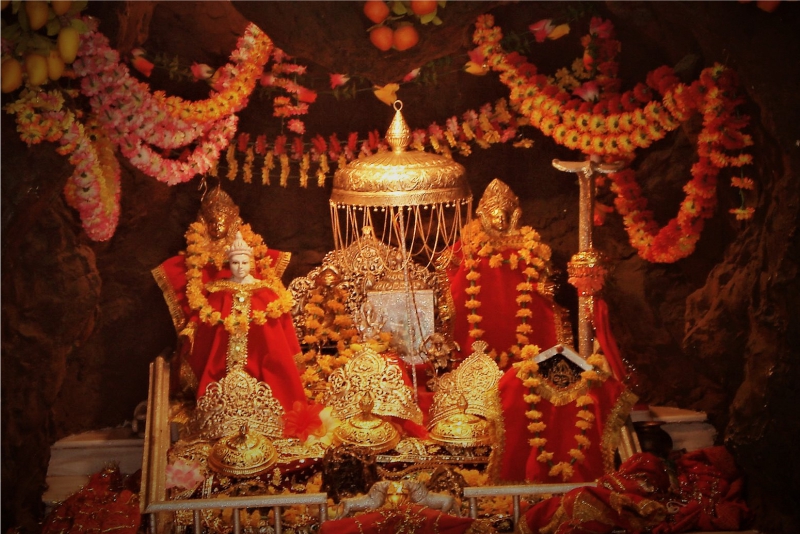
How to Plan Vaishno Devi Yatra?
Quick Navigation Index:
- Which is the best time to visit Vaishno Devi?
- How to reach Vaishno Devi?
- Where to stay in Vaishno Devi?
What is Yatra Parchi & how to get it?
- How to select the best route for Vaishno Devi Yatra?
- How to book Helicopter for Vaishno Devi?
These were some doubts that occurred to my mind when I started planning my trip to Vaishno Devi. And I am quite sure you might also facing be some trouble in getting your answers. So I will give you all the information that will help you in planning your trip to Vaishno Devi. So let’s get started.
Best time to visit Vaishno devi?
It’s hard to say when is the best time to visit Vaishno Devi, as it depends on what you’re looking for in your trip. If you want to avoid crowds, then winter is a good choice (Oct-Feb). Moreover, If the crowd doesn’t bother you then you can visit in any season.
According to me the best time to visit Vaishno Devi is in the winter months. The weather is pleasant and it’s not too cold. In the winter, there are fewer people at Vaishno Devi, so you can get more time with your family and friends. It’s also a good time to visit because you can enjoy the snow in the mountains and create some beautiful memories.
We had planned our trip in the month of October 2017, just after Navratri. The climate is very pleasant during this time. Because, as soon as November ends snowfall starts here.
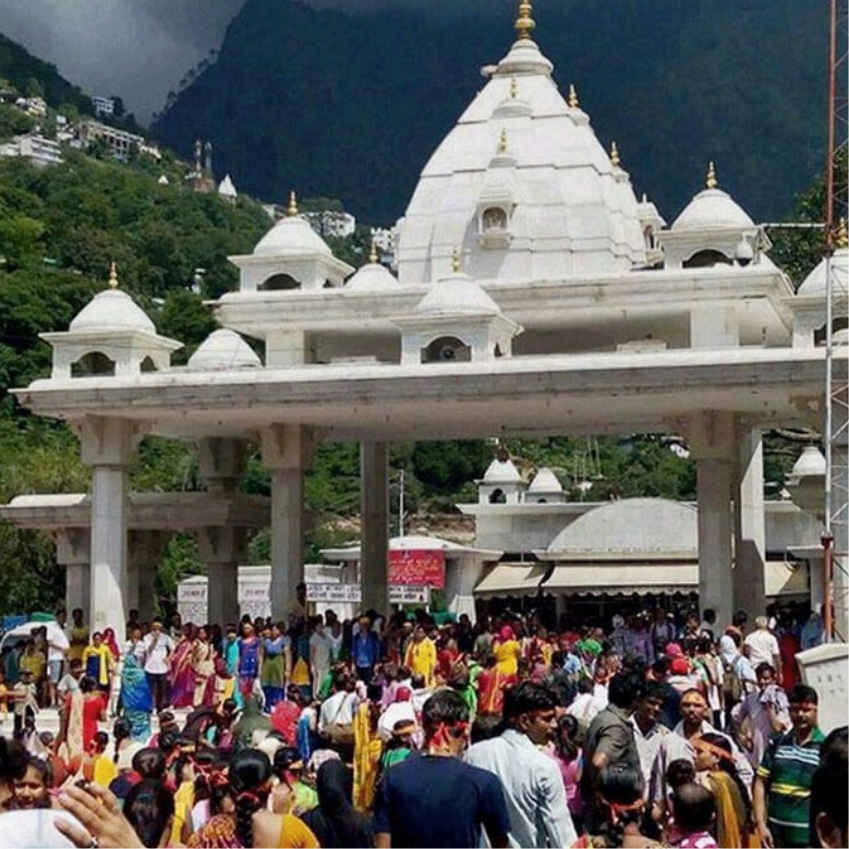
How to Reach Vaishno Devi?
Vaishno Devi is a popular Hindu pilgrimage site in the Indian state of Jammu and Kashmir. There are three ways to reach Vaishno Devi:
by Train, Air, or Road.
To reach Vaishno Devi by train , Karta is the Nearest Railway station. From Delhi, you can also take the newly launched Vande Bharat Express.
To reach Katra by air, Jammu Airport also known as Satwari Airport is the nearest one, which is located just about 48 km away from Katra.
And if you wish to travel by road , Katra is well-connected with all major road networks. From Delhi, Karta is 646 km away.
You can choose the mode of travel according to your preference. But we had chosen to travel by Train. We prefer train Journeys for long distances since it enables us to enjoy the local cuisine from various states on the way and also enjoy comfortable travel.
We started our Journey from Borivali, Mumbai at 11:23 am via 12471 Swaraj Express. This train took approx 31 hours to reach Karta at 5:40 pm. We had spent a good family time on the train. The Jammu Tavi to Katra route is the most popular train route for tourists going to the Vaishno Devi temple. It takes about 5.5 hours from Jammu Tavi station to Katra station and is a scenic journey through the mountains of Kashmir Valley. The Jammu Tavi to Katra train route passes through some Major Bridges, long Tunnels & beautiful places like Udhampur, Nowshera, Ramban, and finally Katra.

Where to Stay in Vaishno Devi?
In Katra , there are many hotels & Guest Houses available according to your budget & comfort . Even Shri Mata Vaishno Devi Shrine Board provides clean, well-maintained, and very economical accommodation at various locations like Jammu, Katra, Adkuwari, Bhavan & Sanjichatt. You can book them online via their official website.
For online booking you can register through the website create a user name and password , close all links and open the website page again. Log in with the user name and password, click on room booking, enter the details select location, date, etc. Once you make the payment you will get a booking confirmation.
For More details and booking you can visit here. https://www.maavaishnodevi.org/
At a time you can book a room for one night only , you cannot extend your booking, if you wish to stay for a longer time, then you will have to book it separately.
We booked our stay at the Niharika complex in Katra. The rooms were neat & clean. From our room’s balcony, we could see the mesmerizing view of the Trikuta hills, on which the main temple is situated.
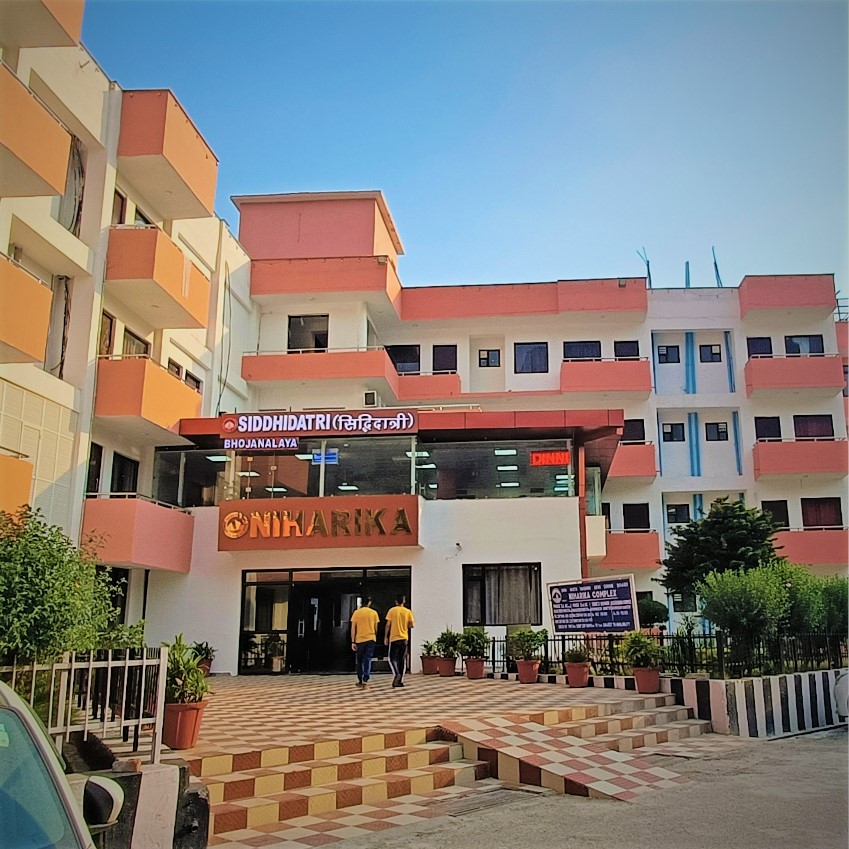
After having some rest in our room, we went to the market for some refreshment. Niharika complex is located near the main Bus stand. Therefore, the area was very busy and crowded. After roaming for a while in the market we decided to finish our dinner early.
After finishing the dinner, we realized that we would need to sleep early. So that we could wake up early in order to begin our yatra to Vaishno Devi. Since we needed some rest before starting our journey. The alarm was set for 3:30 am, so that we could wake up early and begin our yatra to Vaishno Devi by 4:00 am.
For more in-depth information you can also watch my video on YouTube.
Today we all are very excited, we all get ready as per the schedule and packed our bags, as you have to vacant your room . You can keep your luggage in the cloakroom of Niharka Complex free of cost & claim back once you return from Yatra. During yatra try to carry minimal luggage with you. As you will get everything like food, water, etc. on the yatra route.
We took a small backpack with a water bottle, some energy bars, some Chocolates, Glucose Candy (Glucovita), a cap & sunglasses, fully charged camera gears, ID Cards & the most important document YATRA PARCHI. Without Yatra Parchi you cannot enter anywhere. So let’s understand what is Yatra Parchi and how to get it?
So why YATRA PARCHI is the most important document for Vaishno Devi Yatra and why it’s necessary?
The answer is, that the carrying capacity of the Holy Trikuta Mountain is limited, the maximum numbers of yatries that can have Darshans in a single day are about 30,000 to 35,000. However, during the peak rush periods, the number of yatri arrivals is far in excess of this number. And the Holy Pindies is situated in a narrow Cave , a group visits for Darshans are not possible here. The system of Darshans is in the form of a continuously moving queue , round the clock. Thus only a limited number of pilgrims can have Darshans every day.
Yatra Registration is carried out at the Yatri Registration counter (YRC 1 & 2) near the Bus Stand Katra. But if you visit here during peak time then you have to face a huge rush here & they may give you a waiting list Parchi. However, you can avoid this by getting your Yatra Parchi Online.
In order to get your Yatra Parchi online, you need to visit the official website of the Shrine Board. https://www.maavaishnodevi.org/ And Login by using your ID & Password which have been created during Room booking. Now click on the Yatra Parchi tab , enter the no. of visitors & date of visit & click on Get Availablity , on the next page you can see which particular date slots are available or not. If the slot is available you can click on Book now then on another page you need to enter the visitor’s Personal Information like Name, Age, Gender, ID card no. and click Proceed to Book & now it’s done , take the print of Yatra Parchi, and yes this service is free of cost.

Now It’s around 4:10 am and in order to start our Yatra, we need to reach the entry point . Yes, there are three different routes available for devotees from which you can choose any one according to your budget & fitness level. So let’s know more about it.
How to select the best route for Vaishno Devi Yatra?
There are 3 major routes are available for visitors from which you can select as per your convenience, fitness level & budget. The most commonly used route is via Banganga Checkpost. Another newly opened route is via the Tarakot Marg . And Another one via the Katra – Sanjichatt Helicopter route, So let’s understand all routes one by one. I will also tell you which route we have taken & guide you on how to choose your route which will reduce your distance. I have also created a 3D Route Map of Vaishno Devi Yatra with all routes and distance charts. if you want you can Download this Map & take a printout with you.

Vaishno Devi Yatra route via Banganga - Adkuwari - Himkoti - Bhavan (13km)
The Banganga route is the oldest and most common route used by most devotees. We also selected this same route for our Yatra. From Niharika Complex to Banganga Check post is just 1.5km away, so we hire an auto-rickshaw to reach there, in Karta auto-rickshaw is the only mode of local transport. Hence, the Auto fares are very high here, we paid INR.100/- for such a short distance.
Banganga Check post is the first Check post where your Yatra Parchi & luggage was checked . you can carry a camera with you. After checking we started our Yatra . As we entered we saw tariff cards for Pittu, Palkhi & Pony , if you are unable to walk you can hire any one of these services according to your choice & Budget. We personally like to do Yatra by walking ourselves. So we skip all these sections asap because this entire area was stinking with the intense smell of Pony & Donky’s Dung, which was spread everywhere.
After walking ahead we reached on a small bridge under which flows river Banganga. The name of this river comes from two terms, Ban and Ganga. The Ban means Arrow and Ganga stand for the river . It is believed that Vasinavi , while on her way to the Holy Cave , created this water body with a shot of an arrow to quench her thirst, hence the name Banganga, and it’s considered sacred. There are a couple of Ghats built here, if you want you can take a here bath too.
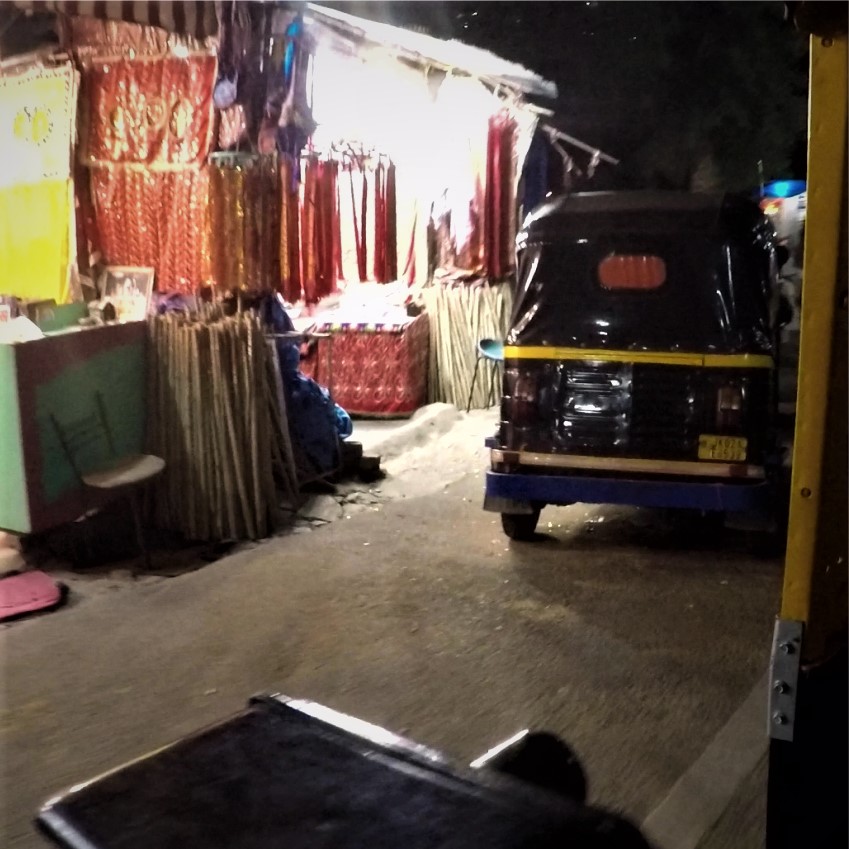
We do not have any plans to take a bath here so we kept moving further. There are plenty of Shops & Hotels located here, Even many photo studios are also situated here with dummies of Vaishno Devi Gufa , where you take photos as a memory with you. Even Medical Units, Toilets & Drinking Water Coolers are also placed at various places on this entire route .
After walking further we reached Geeta Mandir , yet another landmark on the way to Adhkuwari. This old route is very narrow at some points, which creates inconvenience when many devotees gathered together. We also saw many donkeys carrying supplies on their back. Donkeys are the cheapest mode of transport to carry anything on top.
The next popular landmark is Charan Paduka . This white temple is believed to be the place where Mata Vaishno Devi akaVaishnavi stopped over to check if she was still being chased by Bhairon Nath . In Charan Paduka Temple, the feet Impressions of Mata Vaishno Devi’s feet can be seen on a rock slab.
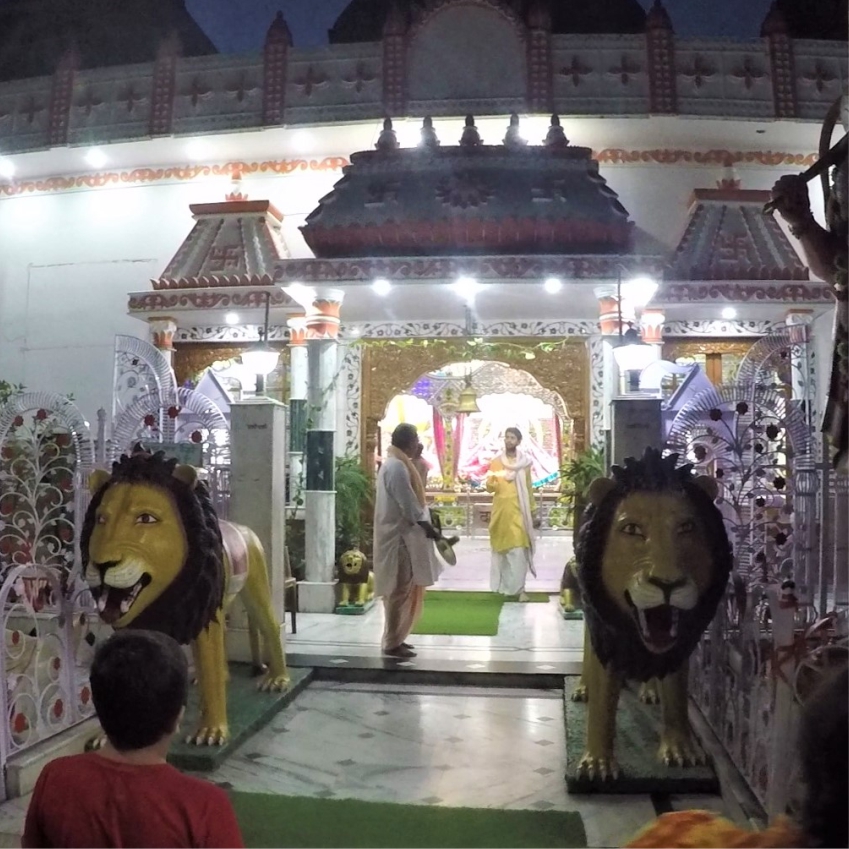
Reached Adkuwari (6km)
Now we are on the way to Adhkuwari, After Charan Paduka most of the pathway was divided into two sections, one for Walking Devotees & another for Pitthu Pony & Palkhiwalas. While walking on the way we also saw a CCD (Cafe Coffee Day) on this route. Sometimes you also see some local villagers playing dhol on the route to encourage devotees.
We also notice a Stairways was made at some places as a shortcut to reduce your walking distance. But it will exhaust you instantly, so be careful if you have any Heart, BP, or Breathing issues.
After taking many Stairway shortcuts we finally reached Adkuwari, The term Adkuwari is believed to have come from Adi kumari, which means “The Eternal Virgin” . Adkuwari is also considered a halfway mark on the track as it is situated at a distance of nearly 6 km. Adkuwari is the second most important Darshans of this entire Yatra.
According to the legend, when Vaishnavi was a small girl, she left the Bhandara organized by Pandit Shridhar , and she was chased by Bhairon Nath. To hide from him first she halted at Banganga and then Charan Paduka. From there she reached here. Where in a small womb-shaped cave she meditated for nine long months. Therefore, this cave has become popular by the name of Garbh Joon, which has come from the term Garbh Yoni meaning the Womb. When during her meditation She realized that Bhairon Nath had approached the cave in search of her. She created an exit at the other end with her Trident and proceeded towards the Holy Cave.
It is generally believed that by merely passing through this cave, a devotee’s sins are cleansed and his soul becomes pious again. Since the cave is very narrow , only one person can pass through it at a time. Hence, they have made a group system here for darshan.

When we reach Adkuwari we saw a huge crowd waiting for a Darshan, when we inquire at the Garbh Joon Parchi counter for Darshan we came to know that there were 36 hours waiting period for darshan. So we decided to skip this and walked further.
From here we took the Himkoti route. You have to pass through a small tunnel mentioning the Way to Bhavan.
Adkuwari to Himkoti (3km)
This route is also called a new route. Because earlier devotees were using the oldest route called Hathi Matha Route. This route is still used by many devotees. But we decided to choose the Himkoti route as this was the most convenient way to walk or if you want you can also take a Battery car from here till Bhavan. This Battery car is run between Adhkuwari & Bhavan. Tickets can be booked in two modes – online and offline. The online ticket for the battery car can be booked by using your same ID & Password through the official website of Shri Mata Vaishno Devi Shrine Board: https://batterycar.maavaishnodevi.org/ . The cost of Tickets is given below.
Himkoti route is much wider and cleaner compared to the older routes. Most of the route is paved & covered by Shade . You can also find a few monkeys on this route. But most of the time they are harmless until you tease them. The Shrine Board has also constructed many restaurants & Prasad Counters on this route.
After walking for around 3 km we reached Himkoti Viewpoint. As soon as we reached here we saw a Dosa Point, a Small restaurant & a huge resting area. We wanted to try some Dosa but it was not opened yet. The police check-post is also situated here, where they will check your luggage again.

Himkoti to Bhavan (4km)
From Himkoti the Bhavan is around 4km away. Now we were very hungry as we had not taken our Breakfast yet. We are gaining energy by eating some chocolate & energy bars. We also saw a Sakat Bhajanlaya on the way, So we planned to have some hot Rajma Chaval, but it was not ready at that moment.
On this route your Yatra Parchi was chacked again , from there you can get the first glimpse of Bhavan ” The Adobe of Mata Vaishno Devi”. By walking further we getting more closer to Bhavan, while on a walk we saw some old abandoned staircases , which might be the oldest trek of Vaishno Devi.
Finally, we reached Bhavan , we also saw many battery cars parked here as this was their last stop. After walking ahead again you have to pass through another Police Check Post . After checking we walk ahead toward Bhavan, at that time a Ropeway was under construction (we were there in the year 2017). However, here I am sharing all the datils of Ropeway with you.
Vaishno Devi Ropeway system connects Vaishno Devi Mandir to Bhairon Nath Mandir, which is located about a couple of kilometers. The one and half-hour trek from Vaishno Devi Mandir to Bhairon Nath Mandir is tough and very difficult for the elderly. It can be covered in just 5 minutes with the ropeway. This air-conditioned cable car can carry 45 people at a time. The panoramic aerial view of Bhairo Valley from the ropeway is stunning. The Vaishno Devi Mandir is 300 meters away from the Ropeway.
Vaishno Devi Ropeway Ticket Price is INR 100 per person for Too and Fro, and Ropeway Timings are from 8:00 AM to 5:00 PM. Currently, no online booking is available, you have to book your tickets from the ticket counter once you reach here.

Darshan of Mata Vaishno Devi
The Bhavan is the final destination of all the devotees, where the Holy Cave of Mata Rani is situated. But before proceeding for the Darshan of Mata Vaishno Devi first we need to eat something. as we are very hungry now. As we walked just a few steps Mata Rani fulfilled our wish, we saw a Manokamna Bhojanalaya . The name itself means wish or desire. Here we had some Rajma Chaval & Chole Bhature.
Now it’s time for Darshan of Vaishno Devi, like other yatra dham there is not such a huge temple built here. The word Bhavan itself means The home or residence, it’s believed that the Mata Rani resides here, And there may be some another reason too, because wherever you see you find buildings named Bhavan i.e Vaishnavi Bhavan, Kalika Bhavan, Laxmi Bhavan, Shridhar Bhavan, etc.
We are visiting here just after Navratri , hence we saw a very beautiful decoration done on the entire path in this section. Before Proceeding for darshans Devotees are required to deposit all their belonging in the free cloakrooms , as nothing except cash and selected offerings are allowed inside the Holy Cave. All articles of general use like belts, wrist watches with leather belts, combs, pens, pencils, purses, handbags, Mobile Phones, Cameras, etc. are prohibited . For the convenience of the yatries, Shrine Board has organized free locker facilities at many points in the Bhawan complex.
We decided to keep our stuff in the last locker room, so we can shoot as much as possible. After keeping our luggage, shoes, etc. at the last locker we proceed further towards The Holy Cave.
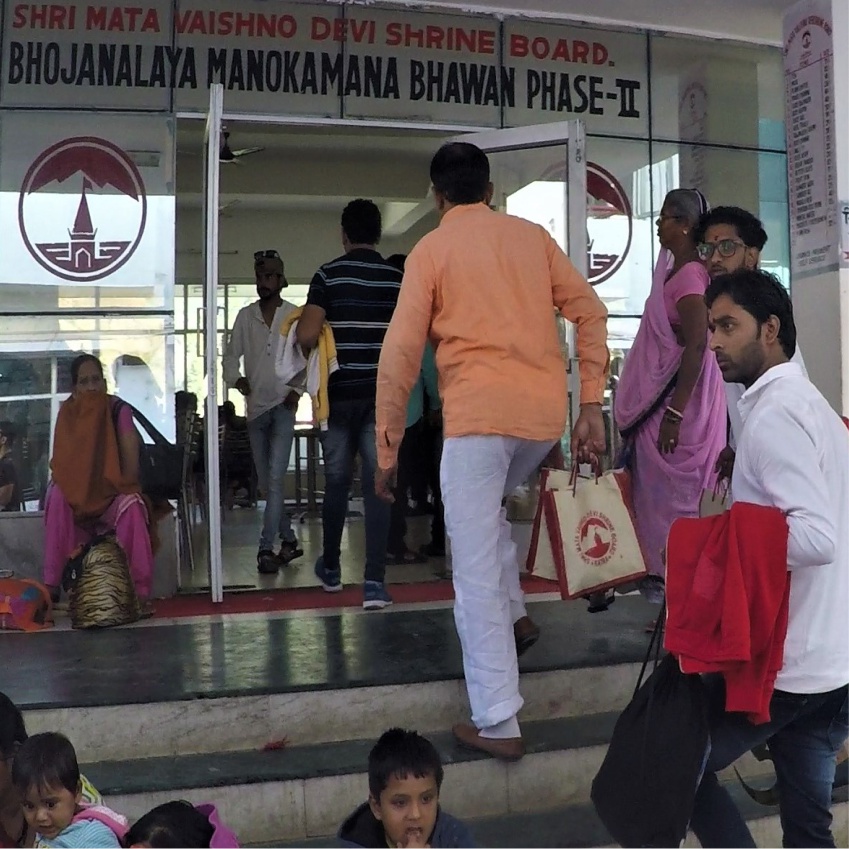
On the way to the Darshan, we cross a small patio type of structure on the right-hand side which looks like a Cave opening. This is the original Cave leading to the Holy Pindies. During the olden days, the yatries used to reach the Holi Pindies through this cave only. Nowadays, this cave is kept closed most of the time throughout the year. Since this cave is quite narrow, it takes several minutes for a single person to cross it and take darshans.
Therefore, two new tunnels have been constructed to facilitate a larger number of devotees to have Darshans. One tunnel is used for the entrance and another tunnel is used for the exit. By making an illustration I have tried to explain this.
As we entered the tunnel, we felt positive energy all around us. At the end of the tunnel, there is a raised marble platform on which the Mata Rani has revealed herself in a natural rock formation known as the Holy Pindies . There are no statues, pictures, or idols inside.
The Panditji was sitting on the platform, informing the devotees about these Pindies, however since the time for Darshans is very limited, we only get a glimpse of the Holy Pindies and have to move further in order to keep the queue moving.

Bhavan to Bhairon Mandir (1.5km)
Just outside the exit tunnel , towards the left-hand side of the Cave, the Amrit Kund or Charanamrut is situated where water taps are located which flows the water of the Charan Ganga , the sacred water flowing from the f eet of Mata. (bottom of Pindies)
After taking some Charanamrut as we walk further we saw a small window of Prashad’s counter. From here we received the Prashad pouch of Mishri (a kind of Sugar) plus a blessed Silver coin , as a token of your visit. And after taking our luggage from the Locker room we proceeded to Bhairon Nath Temple.
What is the importance of Bhairaon Temple? To understand this we need to know what happened when Vaishnavi left form Adkuwari. The Vaishnavi after halting at Adhkuwari finally reached the holy cave Shrine. When Bhairon Nath continued to follow her despite the Vaishnavi trying to avoid a confrontation, the Vaishnavi was compelled to kill him. Bhairon Nath met his ultimate fate when the Vaishnavi was just outside the mouth of the cave and beheaded him. The severed head of Bhairon fell with a force at a distant hilltop. Bhairon Nath upon death realized the futility of his mission and prayed to the Mata Rani to forgive him. The Mata Rani had mercy on Bhairon and gave him a boon that every devotee of her would have to have the Darshans of Bhairon after having the Darshans of her and only then would the yatra of a devotee consider to be completed.
Now it’s time to visit Bhairon Temple which is located around 1.5km away from Bhavan. As I mentioned earlier you can take Ropeway, which will hardly take 5 mins to reach on top. However, when we visited the ropeway was still under construction, so we have to walk. You can also hire Pitthu, Pony, and Palkhi if you wish. After walking & taking a few stairways finally we reached Bhairon Nath Temple.
After Darshan of Bhairon Baba, we have to move further towards Sanjichatt Helipad to catch our Helicopter for Katra . Yes, we are returning via Helicopter. But before I share my experience I will give a short idea of the new route which is Tarakote Marg.
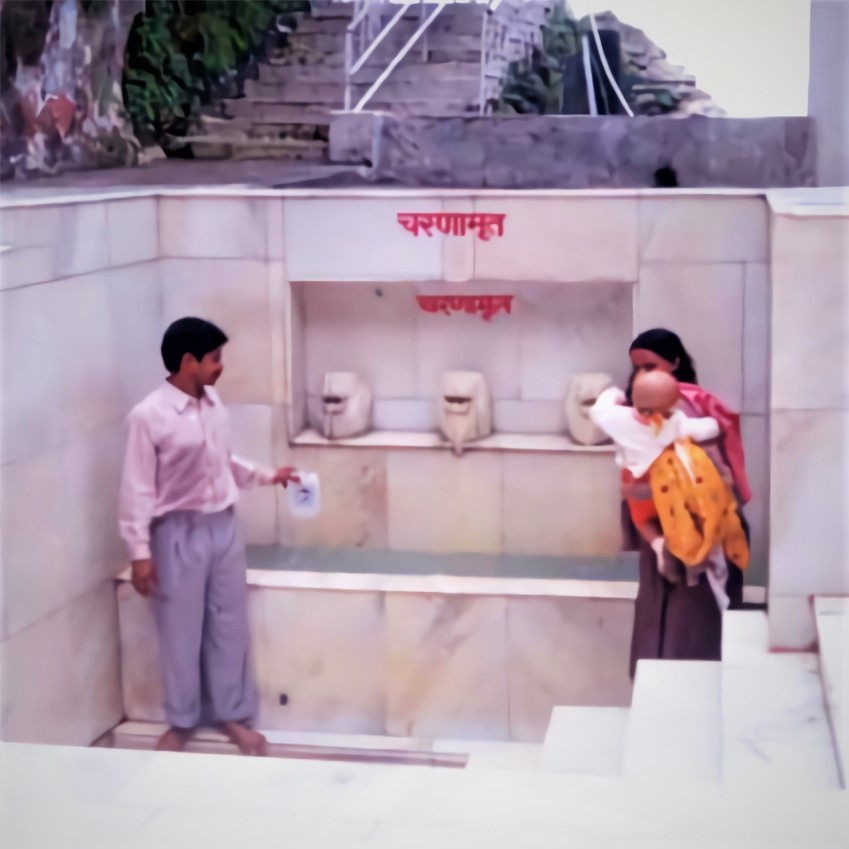
Vaishno Devi Yatra route via Tarakote Marg - Adkuwari - Himkoti - Bhavan (14km)
Tarakote Marg is an alternate option for devotees of Mata Rani. This 7 km long & six-meter wide track is constructed to reduce the rush on the existing tracks to the holy shrine. This route is Just 1km longer than the Banganga (6 km) route. The track was opened to the public in May 2019 in the presence of Governor NN Vohra and inaugurated by PM Narendra Modi.
In order to start your Yatra, you have to reach Tarakote Marg Starting Point. This point is located around 3.3 km away from Katra Chowk or Katra Bus stand. From here you can hire Auto @ Rs.50/- per person (this fare is decided by Shrine Board) but if you are traveling alone then you have to pay Rs.205/-.
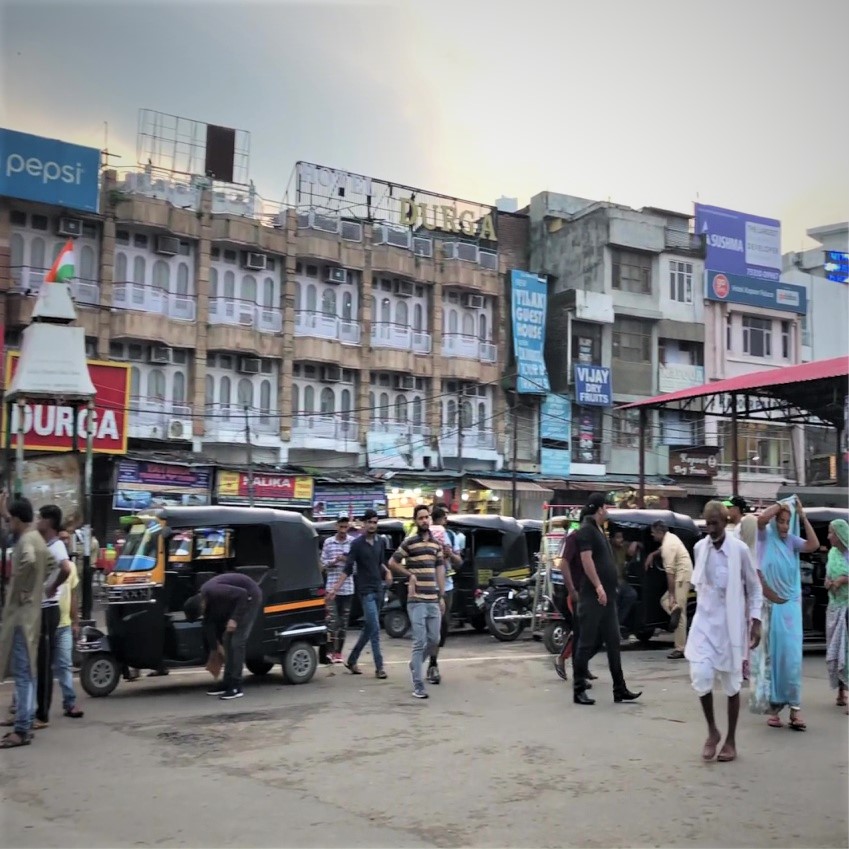
Tarakote Marg to Adkuwari (7Km)
once you reach the starting point, you can enjoy Hot Coffee at CCD. Here you can also get your yatra Parchi from the Yatra Parchi counter. After Screening your Luggage you can Start your Yatra. The main benefit of this route is it was neat & clean because horses & Pones are not allowed on this route. Just a few meters ahead you can see the first Bhojanalaya of this route. If you wish you can take some light refreshment here.
This new track has two Bhojanalayas, two ATMs, four viewpoints, seven toilet blocks, and facilities like a medical unit with doctors, paramedics, medicines, and equipment that had been established here for pilgrims. Tarakote Marg has also been aesthetically landscaped with ornamental plants, herbs, flowering, and avenue trees have been planted to improve the ambiance and three fountains.
At almost half of the distance, you can reach Langar Hall where you can take Mata ka Bhandara as a Prasada. This place is very clean & hygienic. One ATM is also located here. After walking for about 4 Km you can reach Adkuvari. From here you have two options, either you can visit Adkuwari or you can Proceed to Bhavan via Himkoti Marg & after darshan of Mata Rani & Bhairon Baba, you can choose your desired mode of return Because we are returning via Helicopter.
But Before we proceed on our return journey let me tell you the pros and cons of the newly inaugurated Tarakote route of the Mata Vaishno Devi Shrine
- Much cleaner and more scenic than the older route.
- The incline is much gentler than the old track. So it is much easier to trek despite having a slightly longer distance.
- Not at all crowded so it is easier to walk and find places to rest.
- Clean restrooms, water points, and food points at regular gaps.
- No Horses and ponies are allowed on this route. So you are saved from the smell of horse dung which is present throughout the old route. Also, the ponies tend to corner the pedestrians which is very troublesome on the older route.
- The track is much wider than the older track and is almost fully covered so easy to walk even in the rain, bright sunlight, etc.
- Very less crowded. It looked almost deserted at night (if you are alone then avoid traveling on this route at night).
- The older track has more eating points and massage points.
- You don’t have the luxury of hiring a pony or palki if you get tired midway which is there on the older track.
- No stairs to cut short the distance.
- 1 km longer than the older route.

Return Journey options from Bhairon Ghati to Katra
From Bhairon Ghati you have two options for your return Journey, one is the same route from which you have come i.e. Bhairon – Bhavan – Himkoti – Adkuwari – Banganga or Tarakote – Katra, And the second is Bhairon – Sanjichhat – Adkuwari -Banganga or Tarakote – Katra. Or you can also book a Helicopter ride from Sanjichatt to Katra, which we have chosen for our return Journey. So first let me tell you how to book your Helicopter ride in advance because all seats are getting full.

How to Book Helicopter Ride for Vaishno Devi Yatra?
For adding more comfort & convenience Shrine Board provides Helicopter facilities for Devotees of Mata Rani. Helicopter service is available from Katra Helipad to Sanjichhat Helipad which is located at a distance of just 2.5km away from Bhavan. However, to avail of this facility, I strictly recommend you to book your tickets online only, Because last the moment it’s difficult to avail of tickets offline. So let’s understand how to book your helicopter tickets online step by step.
There are two booking options available for Devotees: Katra to Sanjichhat INR.3660/- | Sanjichhat to Katra INR.1830/- (Incl. of GST) as of the year 2022.
Online booking of tickets on the official website of SMVDSB can be done a maximum of 60 days, and a minimum of 04 days in advance from the desired date of journey. The online booking opens exactly 60 days in advance at 10 AM every day. For advance booking of tickets, please visit: https://www.maavaishnodevi.org
In order to book your tickets Login with the user name and password, click on Helicopter Services, select date, route, no. of passenger, time, etc., and enter other passenger detail. At the end click on the payment gateway, link that opens the bank site you can enter the credit card number, CVV number (at the back side of credit card) and expiry date. If the bank will accept your credit card and the message appears for the Non-secure site you can click on yes. Your booking is completed. You can obtain the printout of said page. For booking terms & conditions please visit https://www.maavaishnodevi.org/helecopter_detail.aspx

Bhairon Ghati to Snajichhat Helipad (1.5km)
From Bhairon Ghati we started descending towards Sanjichhat Helipad. This route is also very Scenic you can enjoy the beautiful view of the Pir Panjal Mountain range. On the route, you can see many Monkies too like Himkoti Marg. The helipad is easily visible from the route you enjoy watching Helicopters lending & taking off from Helipad.
We booked our Slot for 3:45 pm & we started descending on 2 pm we have just 1:30 hours to reach down to the helipad, this was our first time so we don’t know the check-in procedure of the Helipad & how much time earlier we have to check-in. Hence we increased our speed in order to reach faster. After a quick walk, we reached there within the time, as soon as we entered we showed our printout, after checking our weight they allotted us a boarding pass & inform us to seat in a waiting hall.
Within 10 mins our number was called, it was very quick to take off within 5 mins passengers came out from helicopter & we have to board in. at a time 4 passengers traveling in one chopper. This was our first time experiencing a Helicopter ride so we were very excited. This ride hardly take 5 mins to reach Katra Helipad, our chopper was very nice he took a Helicopter from Katra Railway Station, and this was an amazing experience for all of us.
From Katra Helipad their Van will drop us at the main gate, and from there we hired an Auto for Niharika Bhavan (INR.200).
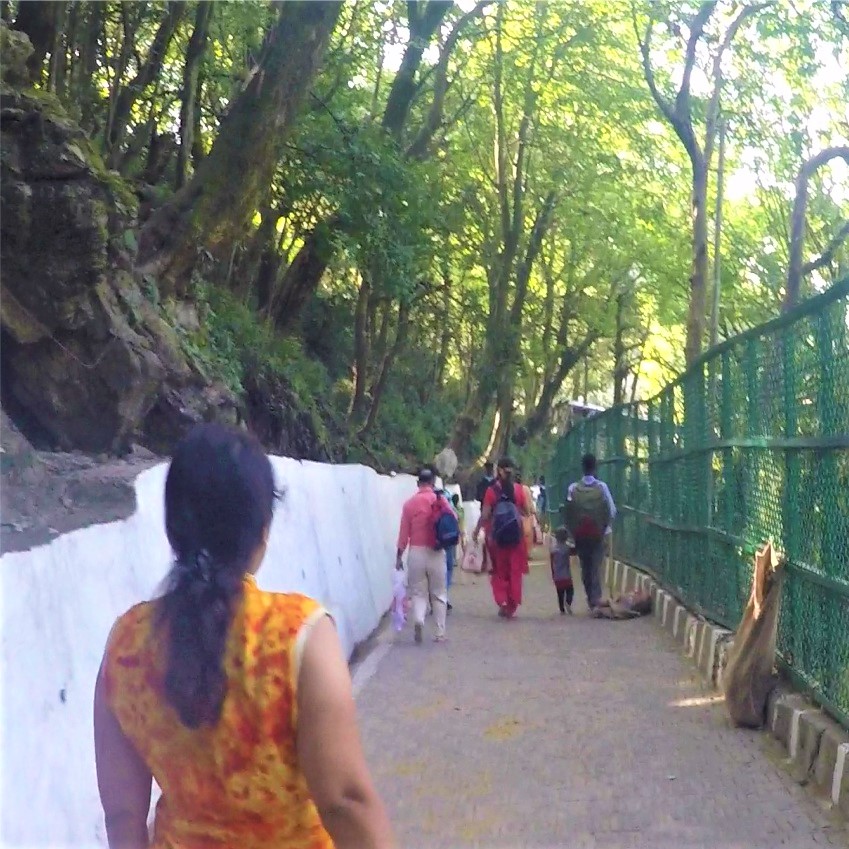
Within approx 10 mins, we reached Niharika Bhavan & then we collected our luggage from the Clock room & Check in to a room which we have booked earlier. It’s around 4:30 pm, so we decided to take some rest in our room, because, tomorrow we not returning back to Mumbai instead we were going to visit some beautiful places of Himachal Pradesh, like Khajjiar, Dalhousie, Dharamshala, Mcledgunj & from there we were going to visit the Holy Golden Temple, Jalianwala Baug & witness the Wagha Border Flag lowering ceremony. So stay with us for more such beautiful trips.
However, you can also enjoy this entire Yatra video on our YouTube Channel. And if you get any value from my content please do like my channel & Share it with your family & friends. To stay updated please subscribe to our YouTube channel. Thanks a lot for being with us. Jai Mata di.
Liked it! Share it!

Vaishno Devi Trek Routes
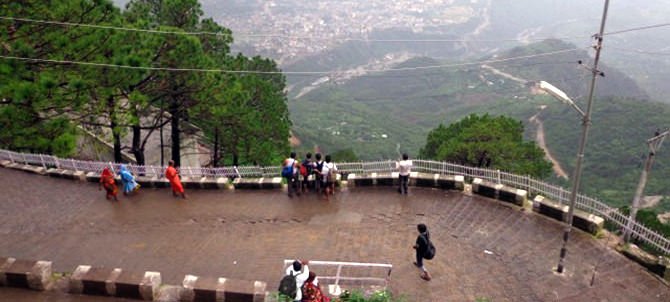
The Holy Shrine of Vaishno Devi is perched at an altitude of 5,200 feet on the Trikuta Mountains. The town of Katra is the base camp for the Vaishno Devi Yatra from where the devotees partake in a 13 km trek uphill to the Holy Bhawan where the Holy Cave is situated. Devotees reach the holy shrine either by walking on foot or by hiring ponies, coolies or dandis.
After the takeover of the Holy Shrine by the Shri Mata Vaishno Devi Shrine Board (SMVDSB) , the entire track from Katra has been remodeled. The route to the Holy Bhawan which was earlier kutcha has now been made pucca and tiled. For the convenience of the yatris, steeper paths has been made gentler. Route has been widened so that crowd can move easily. At regular intervals lantern has been installed making pilgrimage possible at night. To protect the pilgrims from uncertain weather conditions around 5 km of the track has been covered with rain shelters. Facilities like water points/water coolers, sanitary arrangements has been provided along the track route to Vaishno Devi Bhawan.
There are two routes for reaching the Holy Bhawan of Vaishno Devi
- Alternative Route (500m shorter)
Vaishno Devi Temple Route – Main Trek Route to Mata Ka Bhawan
Katra – Ban Ganga – Charan Paduka – Adhkuwari – Himkoti – Sanjhichhat – Bhawan
Darshani Darwaza (Katra)
Darshani Darwaza is the entry gate to the route and is around 1 km from the bus stand. Devotees get a complete view of the Trikuta Mountains from this place. The term ‘ Darshan’ stands for view; hence symbolically this is the first Darshan of the Vaishno Devi Bhawan. One can either walk up to the Darshani Darwaza on foot or hire an auto rickshaw.
Located at a height of 2,700 ft, Banganga is the first major stop for pilgrims taking the on-foot journey to Bhawan from Katra. It is situated on the bank of small rivulet known as Banganga. The legendary history attached to this place makes it an important site.
Legends say that, it was at this place where a spring emerged when Goddess Vaishnavi shot an arrow into the ground. She shot an arrow for her friend Langoor Veer who was thirsty when he was accompanying the Goddess to Trikuta Hills. This pond is considered very sacred. Devotees before proceeding further bathe in the pure waters of the pond.
Charan Paduka
Charan Pduka is settled at an height of 3,380 ft. It is a very pristine religious site, where the holy feet of Mata are believed to be imprinted on a rock slab. Devotees before moving further stop at Charan Paduka to pay reverence. Yatris touch the feet of the mata and seek her blessings. A well equipped medial unit of the Shrine Board is also present here. Unit has all the basic medical facilities and a team of experienced medical staff.
As Adhkuwari is situated 6km from the Holy Bhawan, it marks the midpoint of the Vaishno Devi Yatra and most pilgrims like to rest here for a while before proceeding further. According to the legend, Vaishnavi meditated and observed spiritual discipline (tapasya) for nine long months at a womb shaped cave known as Garbh Joon. It is commonly believed that whoever passes through the cave their past sins gets washed away. Only one person at a time can pass through the cave as it is very narrow.
Located at a distance of 2.75 km from Adkiwari (on new route) is a serene place called Himkoti. On the route to Himkoti one gets to see the panoramic view of the whole valley. Though this place has no religious importance but pilgrims love spending time here. The natural surroundings of Himkoti is charming and gripping. A spot where people can relish the nature and relax.
Many shops that sell packed & cooked food, medicare, oxygen cylinders can be found here. Shri Mata Devi Shrine Board has also opened a view point and restaurant for the public. People can sit and enjoy the tasty food amidst beautiful views.
Sanjhichhat
Situated at a splendid height of 62,00 ft above sea level, Sanjhichhat is the highest point of the trek to Holy Bhawan. It is located around 2 km away from the Vaishno Devi Mandir. Sanjhichatt offers the soulful view of the entire valley. Many development plans has been successfully implemented by the Vaishno Devi Shrine Board at Sanjhichatt.
For the ease of the pilgrims a shopping complex has been developed. A 24 bedded hospital has been opened to facilitate good medical facilities. One of the important development was of the helipad. A helipad has been opened here that runs helicopter services between Katra and Sanjhichatt.
Mata Ka Bhawan
After a long journey pilgrims reach the final destination-‘The Holy Bhawan. The holy cave houses the Sanctum Sanctorum. It is reckoned that inside the cave Goddess disclosed herself and it is in form of a natural rock. The rock has three heads at the top with single base. These three heads in the rock form is called Holy Pindies and is very piously worshipped. The three head manifest Mata in her three form- Kali Mata, Lakshmi Mata and Ma Saraswati. One of the unique features of the Holy Pindies is that each one has a different color and structure even though they emerge from the same rock.
Bhairon Temple
The next stop for pilgrims after visiting the sacred Mata Vaishno Devi shrine is Bhairon Temple. It is said that the whole yatra gets completed only after darshan at Bhairon temple. As per legends, the Goddess forgave Bhairon Nath for his obscene and blessed him with a boon that the holy pilgrimage will only be achieved after visiting the Bhairon temple. Therefore, yatris on the return journey stop at the Bhairon temple in Vaishno Devi to pay homage.
Alternative Route to Vaishno Devi Temple (500m shorter)
Every year lakhs of devotees undertake the Vaishno Devi pilgriamge tour. With the increase inflow of the yatis the routes use to get overcrowded and it became difficult to manage the crowd. In the old route devotees had to walk through the steep path at Hathimatha. To make the journey easy for the pilgrims an alternative route to the Vaishno Devi Mandir has been opened for public in 1999.
In the alternative route no ponies are allowed and is 500 m shorter then the old track. New route is much wider and less steeper & easy in comparison to old track. This alternate route starts from just below Adhkuwari near Indraprastha View Point and ends just short of the Bhawan. Zero-emission battery-operated rickshaws are also available on this track. Sufficient numbers of shelter sheds are also present.
Pilgrimage Destinations
- Vaishno Devi
- Jagannath Puri
- Dwarka Dham
- Rameshwaram Dham
Pilgrimage Packages
- Vaishno Devi Packages
- Amarnath Packages
- Shirdi Packages
- Tirupati Packages
- Badrinath Packages
- Kedarnath Packages
- Gangotri Packages
- Yamunotri Packages
Where to Stay
- Hotels in Vrindavan
- Hotels in Shirdi
- Hotels in Tirupati
- Hotels in Puri
- Hotels in Badrinath
- Hotels in Kedarnath
- Hotels in Gangotri
- Hotels in Yamunotri
Which is more difficult Kedarnath or Vaishno Devi?

1. Which is the toughest Shiva yatra in India?
The Kedarnath Yatra is considered to be one of the most challenging and revered pilgrimages in India. The trek to the Kedarnath Temple involves steep ascents, rugged terrains, and unpredictable weather conditions, making it a difficult yatra.
2. How long does it take to trek Kedarnath?
The trek to Kedarnath usually takes about 6-7 hours to complete. The route is approximately 15 kilometers long and includes both steep ascents and descents. It is considered a moderate level trek.
3. Which trek is tough Amarnath or Kedarnath?
Both the Amarnath Yatra and the Kedarnath Yatra are challenging pilgrimages. However, the Kedarnath Yatra is known to be more difficult due to its rugged terrains, steep ascents, and unpredictable weather conditions.
4. Which is difficult Kedarnath or Amarnath?
Both Kedarnath and Amarnath are challenging pilgrimages, but Kedarnath is considered to be more difficult. The trek to Kedarnath involves steep ascents, rocky terrains, and unpredictable weather conditions, making it a tough journey for pilgrims.
5. Kedarnath Yatra 2023 : Kedarnath Trek in May | Gaurikund To Kedarnath Mandir | Kedarnath Snowfall
This question does not provide enough information to determine the difficulty level of Kedarnath Yatra or compare it with Vaishno Devi.
6. Is it difficult to breathe in Kedarnath?
Due to the high altitude of Kedarnath (approximately 3,583 meters or 11,755 feet), the oxygen levels are lower, and breathing may require more effort. This can affect people differently, and some may experience difficulty breathing at such altitudes.
7. Which temple is higher than Kedarnath?
There is no specific information provided in the article about a temple that is higher than Kedarnath.
8. Can a beginner do Kedarnath trek?
The Kedarnath trek can be challenging for beginners, but with proper preparation, it is possible to complete the trek. It is recommended to start with cardiovascular training, gradually increase the intensity, and acclimatize to the high altitude before attempting the trek.
9. Is Kedarnath trek risky?
The Kedarnath trek involves certain risks due to its rugged terrains, unpredictable weather conditions, and high altitude. However, with proper planning, adequate fitness levels, and guidance from experienced trekkers or local guides, the risks can be minimized.
10. Which is more difficult Kedarnath or Badrinath?
Both Kedarnath and Badrinath are challenging pilgrimages. Kedarnath requires a trek of approximately 16 kilometers, while Badrinath is accessible by vehicle. The difficulty level may vary based on individual fitness levels and preferences.
11. Can Kedarnath be done in 1 day?
It is not advisable to attempt to complete the Kedarnath trek in just one day. The trek is approximately 16 kilometers long and involves steep ascents and descents. It is recommended to take enough time to acclimatize to the high altitude and ensure a safe and enjoyable trekking experience.
12. Can I climb Kedarnath at night?
It is not recommended to climb Kedarnath at night. The trail is not well-lit, making navigation difficult. Additionally, weather conditions can be unpredictable, and it is safer to trek during the daytime when visibility is better.
13. How do I prepare my body for Kedarnath trek?
To prepare your body for the Kedarnath trek, it is recommended to engage in cardiovascular training to build endurance. Start with brisk walking for 30 minutes and gradually increase the duration and intensity of your workouts. Additionally, it is important to stay hydrated, eat a balanced diet, and acclimatize to the high altitude before attempting the trek.
14. Which is the most difficult Shiv Trek?
The most difficult Shiv Trek mentioned in the article is the Shrikhand Mahadev trek. It is considered one of the most challenging treks in the Indian Himalayas, requiring high physical fitness and endurance due to steep ascents, treacherous ridges, and
About The Author
Joshua stephens, leave a comment cancel reply.
Your email address will not be published. Required fields are marked *
Save my name, email, and website in this browser for the next time I comment.
My Subscriptions

J&K: Landslide Strikes Track To Shri Mata Vaishno Devi Shrine, Two Pilgrims Dead
On monday, landslides triggered by heavy rain also blocked the badrinath national highway in the chamoli district of uttarakhand at multiple points..

A landslide occurred on the Shri Mata Vaishno Devi Shrine track in the Katra city of Jammu and Kashmir on Monday, killing two pilgrims from Punjab and Uttar Pradesh while a five-year-old girl was injured. The disaster management team from the Shri Mata Vaishno Devi Shrine Board has arrived at the scene. Further details on the incident are awaited, according to the CEO of Shri Mata Vaishno Devi Shrine Board.
As per PTI, the deceased were identified as Sapna, 27, from Dhianpur village in Punjab’s Gurdaspur, and Neha, 23, from the Kanpur district of Uttar Pradesh.
The injured girl, Sanvi, also from Kanpur, was rushed to the Shri Mata Vaishno Devi Narayana Superspeciality Hospital for treatment. Her grandfather, L. Prasad, said they had paused during their trek to the shrine when police began clearing the track due to a monkey scare. "Suddenly, there was a landslide, and debris fell on the tin shed, causing it to collapse," he said.
J&K | Shooting stones and a landslide have taken place on Shri Mata Vaishno Devi Shrine track. Disaster Management team of Shri Mata Vaishno Devi Shrine Board have reached the spot. More details awaited: CEO of Shri Mata Vaishno Devi Shrine Board — ANI (@ANI) September 2, 2024
Katra SDM Piyush Dhotra told ANI, "A landslide occurred in which two people lost their lives and one person is injured...The dead bodies and injured are being brought to the hospital."
#WATCH | Katra, J&K: Katra SDM Piyush Dhotra says, "A landslide occurred in which two people lost their lives and one person is injured...The dead bodies and injured are being brought to the hospital..." https://t.co/TeFLovCPWA pic.twitter.com/HbWNyYqPCU — ANI (@ANI) September 2, 2024
Officials told PTI that pilgrim movement on the Himkoti track was halted following a landslide, but the pilgrimage to the shrine atop Trikuta hills continued via the traditional Sanjhichatt route. The landslide occurred around 2:15 p.m. near Panchi, three kilometers from Bhawan, damaging part of an overhead iron structure.
They also added that the pilgrims were en route to the shrine when they got trapped under the iron structure due to the landslide. The landslide was triggered by falling rocks, known as "shooting stones," after several days of rainfall.
Reasi Deputy Commissioner Vishesh Paul Mahajan confirmed the deaths and the injury of a girl, stating that senior police and civil administration officers had rushed to the scene. He headed to Katra, the base camp for Vaishno Devi pilgrims, to assess the situation and check on the injured girl personally.
Disaster management teams from the Shri Mata Vaishno Devi Shrine Board (SMVDSB) quickly arrived at the scene and launched a rescue operation, officials further added.
On Sunday, the weather department had forecast dry conditions in Jammu and Kashmir until September 12, saying brief spells of rain could hit isolated areas on certain days.
ALSO READ | Mizoram: Newly Constructed Kawnpui Railway Station Collapses Due To Rain-Triggered Landslide — VIDEO
Landslides In Uttarakhand Too
On Monday, landslides triggered by heavy rain blocked the Badrinath national highway in the Chamoli district of Uttarakhand at multiple points. The highway is obstructed at Pagalnala, Patalganga, and Nandaprayag, and efforts are underway to clear it, according to the district disaster management centre.
According to PTI, seven shops in the Simli market were damaged by landslide debris.
The Jyotirmath-Malari road, which connects to the India-China border, along with the Karnaprayag-Gwaldam national highway, has also been blocked by a landslide, the district disaster management centre reported.

Top Headlines
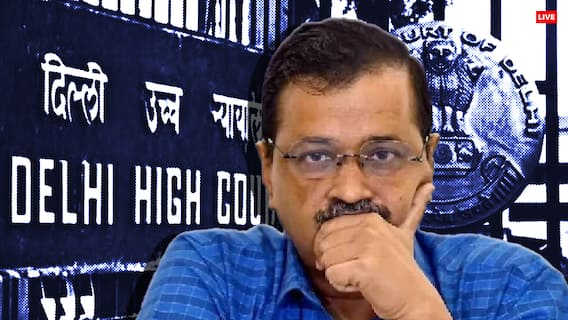
Trending News

Photo Gallery

Trending Opinion

Personal Corner


COMMENTS
The Trek Route and Distance. The Vaishno Devi Trek commences from the holy town of Katra. The trek route spans approximately 13 kilometers, with a total ascent of about 5,200 feet. The trek generally takes 4-6 hours to complete, depending on the pace and endurance of the pilgrims. The trail is well-paved and interspersed with rest stops and ...
The Vaishno Devi trek is a pilgrimage to the sacred shrine of Mata Vaishno Devi, situated in the Trikuta Mountains of Jammu and Kashmir, India. This 12-kilometer journey is considered one of the most important Hindu pilgrimages, attracting millions of devotees annually. ... Hard: 10 miles: 8 hours: Forest Path: Medium: 5 miles: 4 hours: Coastal ...
Located in the Himalayas, the Kedarnath Trek is acknowledged for its rugged and difficult terrain. Involves river crossings, steep ascents, and unpredictable climate conditions. The trek needs bodily staying power and a resilient spirit. The Vaishno Devi Trek, nestled in the scenic Trikuta Mountains of Jammu and Kashmir, is a revered pilgrimage ...
The 13-kilometer trek from Katra to Vaishno Devi Bhawan is both challenging and spiritually enriching. You can choose your mode of transportation based on your fitness and preferences. Walking Tips. In addition to comfortable trekking shoes, carry a walking stick for support. Layer your clothing as temperatures can change rapidly.
Day 1. Start the trek to Vaishno Devi from Katra. Reach Vaishno Devi and offer prayers at the shrine. Descend back to Katra, explore local market. Day 2. Visit Bhairavnath Temple. Head to Patnitop ...
The trek is 15 km stretch with a good ascent. An athlete/sportsperson walking at normal speed can complete the trek in 3 hours. A regular walk/jog of 10 km for 3 months prior to yatra is advisable. Must Read: hampta pass trek, sripuram golden temple. There is only one way up and down. Road has proper lighting.
The original Vaishno Devi trek route is a 13 km uphill climb, starting from Katra. This path, while challenging, offers stunning views and a deep sense of accomplishment. Here's what to expect: Terrain: The route is a mix of paved walkways and steeper inclines with stairs. Difficulty: Moderate to difficult.
The trek begins at the town of Katra and ends at the Vaishno Devi shrine, which is located in the Trikuta Mountains. Katra to Vaishno Devi Distance. Katra to Vaishno devi covers a distance of approximately 14 kilometers and involves a climb of about 3,500 feet. This route stretches from Katra to Bhawan and is well-maintained.
Vaishno Devi trekking refers to the pilgrimage to the Vaishno Devi temple, located in the Trikuta Mountains in Jammu and Kashmir, India. The trek involves a 12-kilometer uphill journey from the base camp at Katra to the temple.
The Vaishno Devi trek is a pilgrimage route to the Vaishno Devi temple, located in the Trikuta Mountains in the Indian state of Jammu and Kashmir. It is a popular pilgrimage destination for Hindus, and the trek involves a 12-kilometer uphill climb to reach the temple.
Routes for The Vaishno Devi Yatra. There are two popular routes to trek up the height of Vaishno Devi shrine. It usually takes 6-7 hours to trek up and 3-6 hours to trek down depending upon your stays and walking speed. We begin our trek at 9 am morning and reached Bhawan by 5 PM with a break of 2 hours at Ardhkuwari.
Each year, millions of devotees embark on the sacred journey to seek the blessings of Mata Vaishno Devi. The pilgrimage involves a trek through picturesque landscapes, challenging terrains, and a ...
Banganga Check Point in Katra, about 45 km from Jammu is the starting point of the Vaishno Devi Yatra. Due to security reasons, Only Postpaid connection will work. So if you don't have a postpaid connection buy one to communicate. Distance between Banganga check post and Katra by walk is around 1.5km-1.7km depending on the route you choose.. Here is the distance table from Katra to the ...
From Katra bus stand, entry point to Vaishno Devi trek at Banganga is about 1.5 kilometers. Then from Banganga, Vaishno Devi shrine (situated at Bhawan) is about a 12- 13 kms trek. Banganga to Adhkuwari (halfway): 6-7 kms; Adhkuwari to Bhawan: 6-7 kms. Further, if one decides to trek up to Bhairon Temple, it's about 1.5 kms more.
It is the must visit place on your Vaishno Devi family trip. 2. Adh Kumari Temple. Adh Kuwari is considered as a halfway mark to the main Bhawan of Vaishno Devi situated at a distance of 6 km. The term Adh Kuwari means the eternal virgin and is regarded as one of the most essential temples on the way to the holy cave.
Ans: The trek to Vaishno Devi typically takes around 5 to 6 hours to complete, covering a distance of approximately 13 kilometers from Katra to the main shrine. However, the duration may vary ...
Lockers are a convenient option for pilgrims to store their belongings during the trek to the Vaishno Devi Temple. Here are some details about locker rental options in Katra: Shri Mata Vaishno Devi Shrine Board Cloak Room: This is the most popular option for locker rental, located at the start of the trek in Katra. The cloak room is open 24 ...
The trek from Katra to the Vaishno Devi Temple covers a distance of approximately 13 kilometers. Here's a breakdown of the journey: Starting Point: Ban Ganga. The trek begins at Ban Ganga, where ...
The Vaishno Devi Yatra isn't just a trek but a spiritual journey that strengthens one's faith and offers a sense of inner peace. It's a testament to human perseverance and the undying faith of millions in the divine. Whether you're drawn by faith, tradition, or simply the lure of trekking in a scenic landscape, the Yatra offers an ...
The Vaishno Devi shrine in Trikuta mountains at 5,200ft is 61 km from Jammu city and can be reached after a 13 km arduous journey on foot from Katra. Devotees sometimes suffer breathing problems and can avail of ponies and palanquins to reach the shrine via Ardh Kumari. ... 170 km from Shimla and 200 km from Kullu by road. A short trek leads to ...
Vaishno Devi Ropeway system connects Vaishno Devi Mandir to Bhairon Nath Mandir, which is located about a couple of kilometers. The one and half-hour trek from Vaishno Devi Mandir to Bhairon Nath Mandir is tough and very difficult for the elderly.
The Holy Shrine of Vaishno Devi is perched at an altitude of 5,200 feet on the Trikuta Mountains. The town of Katra is the base camp for the Vaishno Devi Yatra from where the devotees partake in a 13 km trek uphill to the Holy Bhawan where the Holy Cave is situated. Devotees reach the holy shrine either by walking on foot or by hiring ponies ...
1. Which is the toughest Shiva yatra in India? The Kedarnath Yatra is considered to be one of the most challenging and revered pilgrimages in India. The trek to the Kedarnath Temple involves steep ascents, rugged terrains, and unpredictable weather conditions, making it a difficult yatra. 2. … Which is more difficult Kedarnath or Vaishno Devi ...
A landslide occurred on the Shri Mata Vaishno Devi Shrine track in the Katra city of Jammu and Kashmir on Monday, killing two pilgrims from Punjab and Uttar Pradesh while a five-year-old girl was injured. ... Her grandfather, L. Prasad, said they had paused during their trek to the shrine when police began clearing the track due to a monkey ...